Affordable Fares and Welcoming Design: Navi Mumbai Airport Sets Out to Redefine Travel
Latest News: 19th December 2025


As the Navi Mumbai International Airport (NMIA) prepares to open on December 25, 2025, Jeet Adani, Director at Adani Airport Holdings, has emphasised a passenger-first and affordable travel experience at the new facility. In an exclusive interview, Adani said the airport — developed under a Public-Private Partnership (PPP) between Adani Airports and CIDCO — has been designed with both first-time flyers and frequent travellers in mind, ensuring easy navigation, clear signage, and thoughtful amenities across the terminal. He stressed that affordability is central to the airport’s operational model, with efforts such as direct partnerships with food vendors to cut out middlemen and keep prices for items like vada pav in a reasonable range of roughly ₹80–₹100, aiming to reduce typical airport costs for everyday travellers.
Beyond costs, Jeet Adani highlighted how NMIA plans to tailor services to passenger needs, including language-adaptive digital displays to help travellers better orient themselves and thoughtful curation of food, art, and hospitality offerings throughout the facility. The airport is expected to ease congestion at Mumbai’s existing international hub and serve the wider Mumbai Metropolitan Region and Pune, with commercial flight operations kicking off soon and initial services already planned with carriers like IndiGo. With its focus on convenience, price sensitivity and a curated travel experience, NMIA aims to position itself as a more accessible gateway for both domestic and international flyers.
(NNI / Latest news / Latest news india / India latest news/UPSC Preparation)
Indian Rupee Inches Up as Dollar Sales Support Markets
Latest News: 18th December 2025


The Indian rupee strengthened modestly on Thursday, appreciating 12 paise to close at ₹90.26 against the US dollar, marking a rebound from recent record lows as traders responded to suspected intervention by the Reserve Bank of India (RBI) in the foreign exchange market. The domestic unit opened the session at around ₹90.35 and touched an intraday high near ₹90.04 before settling stronger by the close of trade. Brent crude prices near USD 59 per barrel and dollar selling by the central bank helped support the rupee, although resilient strength in the US dollar and weak domestic equity markets limited sharper gains.
Market participants noted that the recent RBI dollar sales likely aimed to curb excessive volatility and prevent further steep depreciation, while concerns over delayed India-US trade negotiations and continued capital outflows keep downward pressure on the currency. Despite the uptick, analysts caution that broader drivers — including the strength of the US dollar, foreign fund movements, and global monetary policy cues — will continue to shape INR’s trajectory in coming sessions. The modest recovery provides some relief after the rupee slid to multi-year lows earlier this week, but promises of sustained strength remain tied to both domestic economic cues and global financial conditions.
(NNI / Latest news / Latest news india / India latest news/UPSC Preparation)
Government Targets Big-Bang Financial Reforms in Busy Winter Session
Latest News: 22nd November 2025


The upcoming Parliament Winter Session is expected to be one of the most reform-driven in recent years, with the central government preparing to introduce a series of significant financial and economic bills. Officials indicated that proposals related to regulatory modernisation, fiscal transparency, and compliance simplification are likely to take centre stage. The government aims to strengthen India’s evolving financial architecture as global economic uncertainties continue to challenge emerging markets. Key updates to taxation laws, banking regulations, and market oversight frameworks are reportedly part of the legislative package.
Political observers say the reform-heavy agenda underscores the government’s focus on accelerating growth, improving investor confidence, and preparing India for the next phase of economic expansion. However, the Opposition is expected to counter the move by raising issues around unemployment, inflation, and alleged lapses in governance. With crucial bills on the table and the general elections approaching, the Winter Session may see heated debates, strategic alliances, and intense parliamentary action as both sides seek to shape the national economic narrative.
(NNI / Latest news / Latest news india / India latest news/UPSC Preparation)
Why 100% Buy Ratings Failed: The Hidden Risks Behind 3 Underperforming Stocks
Latest News: 21st November 2025


The central government has scheduled a crucial meeting with automobile manufacturers this week to address growing concerns over the mandatory Anti-lock Braking System (ABS) requirement. Auto industry bodies have warned that implementing ABS across all entry-level two-wheelers and small cars could significantly increase production costs, affecting price-sensitive consumers. With several manufacturers already struggling with supply-chain pressures and tighter emission norms, the additional cost burden has triggered calls for staggered implementation or financial support.
According to officials, the meeting aims to strike a balance between road safety priorities and industry feasibility. The government maintains that ABS is essential for reducing accident fatalities, especially on Indian roads where emergency braking often leads to skidding and loss of control. However, companies argue that sudden cost hikes could push buyers away from the formal market and slow down sales in the mass segment. A final decision is expected after detailed consultations, with both sides hoping to reach a practical middle ground.
(NNI / Latest news / Latest news india / India latest news/UPSC Preparation)
Cost Burden Growing? Centre To Engage Auto Industry On ABS Norms
Latest News: 20th November 2025


The central government has scheduled a crucial meeting with automobile manufacturers this week to address growing concerns over the mandatory Anti-lock Braking System (ABS) requirement. Auto industry bodies have warned that implementing ABS across all entry-level two-wheelers and small cars could significantly increase production costs, affecting price-sensitive consumers. With several manufacturers already struggling with supply-chain pressures and tighter emission norms, the additional cost burden has triggered calls for staggered implementation or financial support.
According to officials, the meeting aims to strike a balance between road safety priorities and industry feasibility. The government maintains that ABS is essential for reducing accident fatalities, especially on Indian roads where emergency braking often leads to skidding and loss of control. However, companies argue that sudden cost hikes could push buyers away from the formal market and slow down sales in the mass segment. A final decision is expected after detailed consultations, with both sides hoping to reach a practical middle ground.
(NNI / Latest news / Latest news india / India latest news/UPSC Preparation)
India’s PSU Banks Are Growing in Scale — But Is It Helping?
Latest News: 19th November 2025


India’s public sector banks (PSBs) have expanded rapidly through mergers and consolidation over the past few years, creating financial institutions of unprecedented scale. However, experts argue that size doesn’t automatically translate into efficiency or resilience, especially in an economy undergoing major structural shifts. Despite their expanded balance sheets, many large PSBs continue to grapple with outdated technology systems, slow decision-making, and legacy non-performing assets that limit their competitiveness against private and digital-first banks.
Economists highlight that in the current environment—marked by rising fintech disruption, tighter credit standards, and evolving borrower behaviour—agility matters more than size. While consolidation has helped stabilize weaker banks, it hasn’t fully addressed core issues such as talent retention, innovation capacity, and customer experience. Analysts believe that unless PSBs prioritize modernization, digital transformation, and performance accountability, the benefits of scaling up may remain limited, leaving India’s banking sector unevenly prepared for future economic challenges.
(NNI / Latest news / Latest news india / India latest news/UPSC Preparation)
Corporate India Should Create Joint Startup Fund, Says Goyal
Latest News: 18th November 2025

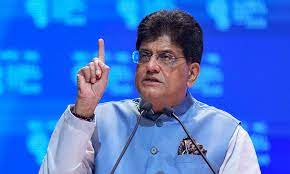
Union Minister Piyush Goyal on Monday urged India’s leading corporates to collectively create a shared pool of funds dedicated to supporting early-stage startups, stressing that innovation must not be allowed to struggle for capital. Speaking at a business summit, Goyal said that while India’s startup ecosystem has grown rapidly, thousands of promising entrepreneurs still face funding hurdles in their initial stages. He emphasised that a unified, industry-backed funding mechanism could help startups access resources quickly and scale sustainably.
Goyal added that the government has already taken several steps to ease compliance, improve access to markets, and encourage innovation, but long-term success requires strong participation from private industry. By creating a collaborative funding corpus, corporates can not only empower young innovators but also strengthen India’s position as a global innovation hub. Industry leaders present at the event welcomed the proposal, noting that coordinated investments could significantly accelerate the growth of high-potential startups across sectors including technology, manufacturing, and green energy.
(NNI / Latest news / Latest news india / India latest news/UPSC Preparation)
Gold Close To ₹1,27,300 Levels As Demand Rises — Delhi & Mumbai Rates Inside
Latest News: 14th November 2025


Gold prices continued their upward trend on Monday, edging close to ₹1,27,300 per 10 grams in many markets as global uncertainty and strong retail demand pushed rates higher. Traders attribute the surge to rising geopolitical tensions and a weaker dollar, which have boosted safe-haven investments worldwide. In Delhi, the price of 24-carat gold was quoted near ₹1,27,100, while Mumbai recorded similar levels as jewellers reported an uptick in advance bookings ahead of the festive season.
Other major cities also saw a sharp rise in prices, with Chennai and Kolkata witnessing rates in the range of ₹1,27,000 to ₹1,27,300. Silver, meanwhile, traded firm, adding to the bullish sentiment in the bullion market. Analysts say gold may remain elevated in the coming weeks if global cues continue to favour safe-haven assets. Consumers planning to buy jewellery or invest in bullion have been advised to track daily fluctuations closely, as volatility is expected to persist.
(NNI / Latest news / Latest news india / India latest news/UPSC Preparation)
Moody’s Projects India as G-20’s Fastest-Growing Economy
Latest News: 13th November 2025, UPSC Preparation
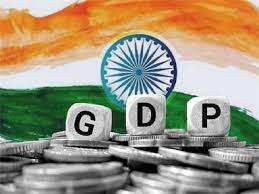

India is set to maintain its position as the fastest-growing economy in the G-20, according to Moody’s latest global outlook. The agency expects strong domestic demand, stable monetary conditions and resilient exports to support growth through 2027.
India’s Growth Path Through 2025–27
Moody’s forecasts India’s GDP to rise 7 per cent in 2025, followed by 6.4 per cent in 2026 and 6.5 per cent in 2027. The momentum is driven by sustained consumption, increased infrastructure spending and continued diversification of export markets.
Resilience Amid Global Headwinds
The rating agency noted India’s ability to navigate international pressures, including higher US tariffs on selected products. Exporters successfully redirected shipments, helping overall exports grow despite a decline in goods sent to the United States.
Policy Support and Financial Conditions
A neutral-to-easy monetary stance, supported by the RBI’s steady repo rate and stable inflation, has ensured favourable domestic conditions. Strong capital inflows and upbeat investor sentiment have helped absorb external shocks and preserved liquidity.
Exam Oriented Facts
Moody’s expects India’s GDP growth at 7% in 2025.
India is projected to remain the fastest-growing G-20 economy through 2027.
RBI maintained a steady repo rate, supporting a neutral-to-easy policy stance.
India’s exports rose 6.75% in September despite tariff-related challenges.
Global Outlook and Comparative Trends
Moody’s expects global GDP to remain in the 2.5–2.6 per cent range in 2026 and 2027. Advanced economies may grow close to 1.5 per cent, while emerging markets could expand around 4 per cent. The United States is likely to see stable but moderating growth, Europe’s prospects have improved due to supportive policies, and China’s growth is set to ease gradually following stimulus-driven expansion.
(NNI / Latest news / Latest news india / India latest news/UPSC Preparation)
“Mutual Funds Bet Big on Unprofitable IPOs Despite Risks — Here’s Why”
Latest News: 10th November 2025


Despite many newly listed companies yet to turn a profit, Indian mutual funds continue to pour money into their public offerings — and industry advisors say the driving force is strong “appetite” for growth, market share and primary-market opportunities. With the IPO pipeline swelling, mutual fund houses see a strategic advantage in securing allocations in fresh issues, where valuations may offer more upside than mature listed firms. The logic: by getting in early — even at companies still reporting losses — funds believe they can ride the growth curve once profitability kicks in.
At the same time, this appetite is supported by the broader environment of abundant domestic liquidity and strong institutional support for the primary market. Analysts note that foreign institutional investors (FIIs) have become more selective, turning cautious in buying secondary-market stocks while still participating in IPOs where terms and allocations look favourable. For fund managers, the rationale is to participate in high-potential stories where the market entrance may offer a tailwind — albeit with admitted higher risk. The assessment: losses now may be acceptable if future earnings and valuations justify the bet.
(NNI / Latest news / Latest news india / India latest news/UPSC Preparation)
Microfinance Loan Defaults Surge, Bihar Worst Hit
Latest News: 13th October 2025, UPSC Preparation
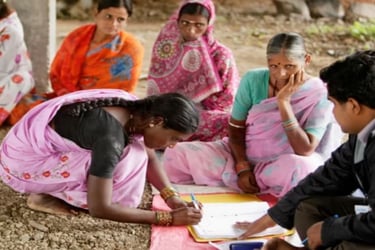

The microfinance sector in India witnessed a sharp increase in loan delinquencies during the financial year 2024-25. According to the latest data from Sa-Dhan, the self-regulatory body for microfinance institutions, the percentage of loans overdue by more than 30 days rose steeply from 2.1% in 2023-24 to 6.2% in 2024-25. This trend signals growing stress in the sector, raising concerns about borrower repayment capacity and institutional risk.
Overview of Microfinance Delinquency Trends
Microfinance loans overdue by over 30 days, also called Portfolio at Risk (PAR) 30+, increased nearly threefold in one year. Loans overdue by more than 90 days, a key indicator of non-performing assets, also rose from 1.6% to 4.8%. The rise in delinquency is widespread across the industry, reflecting an emerging challenge for lenders and borrowers alike.
State-Wise Performance and Bihar’s Distress
Among state of Indias, Bihar recorded the highest outstanding microfinance loan amount at Rs 57,712 crore by March 2025. It also showed the worst repayment performance, with 7.2% of loans overdue by more than 30 days, above the national average of 6.2%. Loans overdue by over 90 days stood at 4.6% in Bihar, indicating greater credit risk and potential asset quality deterioration.
Urban-Rural Disparities in Loan Repayment
Rural borrowers faced more repayment difficulties than their urban and semi-urban counterparts. Of the Rs 2.3 lakh crore outstanding to rural customers, 6.4% of loans were overdue beyond 30 days. This compared to 6.1% and 6% for semi-urban and urban borrowers respectively. Similarly, loans overdue by more than 90 days were higher for rural borrowers at 3.7%, compared to 3.2% for both semi-urban and urban groups.
Implications for Microfinance Institutions and Borrowers
Rising delinquency rates increase the risk of loan defaults and reduce the financial health of microfinance institutions. It may constrain their ability to lend further and affect funding costs. For borrowers, especially in rural areas, repayment stress could worsen economic vulnerability. The trend puts stress on the need for better credit assessment, borrower education and risk management.
Factors Contributing to Rising Delinquencies
Several factors may explain the surge in overdue loans. These include economic slowdown, inflationary pressures, agricultural distress, and limited income opportunities for low-income borrowers. External shocks such as floods or pandemics may also impact repayment capacity. The sector requires adaptive strategies to mitigate these risks.
(NNI / Latest news / Latest news india / India latest news/UPSC Preparation)
“From 6.3 to 6.5: World Bank’s Upward Revision Reflects India’s Economic Vigor”
Latest News: 07th October 2025


The World Bank has revised upward its growth projection for India in fiscal year 2025–26 to 6.5%, up from its earlier estimate of 6.3%. This adjustment reflects stronger than expected domestic demand, a robust rural recovery, and improved agricultural output. The bank also flagged the government’s GST reforms and simplified tax structure as supportive policy measures aiding growth momentum.
However, the World Bank cautioned that external headwinds could dampen momentum in the medium term. It trimmed its FY27 forecast to 6.3%, citing rising U.S. tariffs on Indian exports, increasing risk in global trade policies, and uncertainty associated with technology disruptions. The bank also warned that inflationary pressures and capital flow volatility could test the resilience of India’s growth trajectory.
(NNI / Latest news / Latest news india / India latest news/UPSC Preparation)
“IPO Frenzy: India Set for Biggest Month Yet with $5B in New Deals”
Latest News: 05th October 2025


India’s IPO market is preparing for a blockbuster October, with proceeds from new equity listings expected to cross the $5 billion mark — a historic high for any single month. The surge is being driven by marquee offerings such as Tata Capital’s ~$1.7 billion IPO and a major listing from LG Electronics’ Indian unit, which collectively reflect strong investor appetite despite global headwinds. Supporting this wave is a steady inflow of domestic mutual funds, which are backing new issues and helping absorb large issuances even as foreign flows remain volatile.
Market watchers say the uptick isn’t transient — the strength lies in India’s expanding equity culture and deepening capital markets. Analysts expect that as long as macro conditions remain stable, this momentum could push the full year’s IPO haul past previous records. Institutional anchors too are stepping in early, signaling confidence in large-ticket issues.
(NNI / Latest news / Latest news india / India latest news/UPSC Preparation)
"Economic Friction Spurs India-China Rapprochement at SCO"
Latest News: 31st August 2025

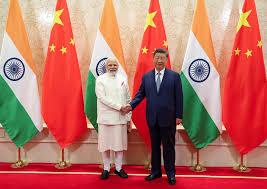
At the Shanghai Cooperation Organisation summit in Tianjin, Chinese President Xi Jinping and Indian Prime Minister Narendra Modi held their first face-to-face bilateral meeting in seven years, signaling a thaw in ties amidst escalating geopolitical tensions. Modi reaffirmed India’s dedication to improving relations, urging a foundation of mutual respect, trust, and strategic autonomy—ways that do not hinge on the agendas of any third country. The two leaders agreed to reinstate direct flights and ease trade restrictions, while Modi acknowledged the increased stability along their Himalayan border, which followed a phased troop disengagement.
Under pressure from newly imposed U.S. tariffs—ranging up to 50% on Indian goods—both nations demonstrated a pragmatic approach toward strengthening economic and strategic ties. Xi emphasized that border issues should not define their relationship and reiterated the potential for cooperation if the two countries see each other as partners rather than rivals. As India seeks to assert its independence in foreign policy and diversify its global partnerships, this rekindled cooperation with China offers a critical counterbalance in regional dynamics.
(NNI / Latest news / Latest news india / India latest news/UPSC Preparation)
India’s Wholesale Price Inflation Hits Two-Year Low
Latest News: 16th August 2025, UPSC Preparation


India’s factory gate inflation, measured by the Wholesale Price Index (WPI), recorded a two-year low of -0.58 per cent in July 2025. This marked the second consecutive month of negative inflation, mainly driven by falling food and fuel prices. Despite this overall decline, prices of manufactured goods showed an upward trend during the same period.
Wholesale Price Index
The WPI is the primary inflation indicator in India. It tracks price changes of a basket of goods at the wholesale level. The index is divided into three groups – Primary Articles (22.6%), Fuel and Power (13.2%), and Manufactured Products (64.2%). Food items from Primary Articles and Manufactured Products together form 24.4% of the total weight. Key subgroups include Basic Metals, Food Products, Chemicals, and Textiles.
Decline in Food Prices
Primary food articles fell by 6.29% in July, marking the third consecutive month of deflation. Onion prices plunged by 44.4%, potatoes by 41.3%, and vegetables by 28.9%. Pulses and fruits also saw price drops of 15.12% and 2.65%, respectively. Protein-rich foods like eggs, meat, and fish fell by 1.09%. Wheat prices rose by 4.4%, while oil seeds surged by 9.77%, showing mixed trends within food items.
Fuel and Power Price Movements
Fuel and power prices declined by 2.43% in July. Global commodity price softness, especially mineral oils, pushed petrol prices down by 5.7% and high-speed diesel by 4.3%. This marked the 14th and 27th consecutive month of decline for these fuels. However, cooking gas prices increased by 1.23%, showing divergence within the fuel category.
Manufactured Products Price Trends
Manufactured goods prices increased by 2.05% in July. Apparel rose by 2.5%, leather by 2.57%, and non-metallic mineral products by 2.7%. Cement and plaster prices surged by 3.4%. Manufactured animal oils and fats slowed but remained high at 22.04%. Other items like food products, paper, chemicals, and pharmaceuticals saw slower price rises, indicating mixed inflationary pressures in this segment.
Economic Implications and Outlook
The deflation in July was mainly due to food price declines, even as other segments showed price increases. Experts believe WPI inflation bottomed out in July and expect it to return to positive territory in August 2025. Factors include rising food and crude oil prices, currency depreciation, and seasonal weather effects like heavy rains that may increase perishable food costs.
Relation to Retail Inflation
The WPI trends align with retail inflation data, which hit an eight-year low of 1.55% in July 2025. This was aided by falling prices of many food items despite a surge in edible oil prices, influenced by global geopolitical tensions. The moderation in inflation supports monetary policy decisions and economic planning.
(NNI / Latest news / Latest news india / India latest news/UPSC Preparation)
DSP Mutual Fund Launches Flexicap Quality Index Fund
Latest News: 11th August 2025, UPSC Preparation


DSP Mutual Fund introduced the DSP Nifty500 Flexicap Quality 30 Index Fund. This fund is India’s first low-cost flexicap strategy that blends quality stock selection with dynamic market capitalisation allocation. It aims to help investors confidently navigate changing equity markets through a rules-based, automated approach.
Fund Overview
The fund’s New Fund Offer (NFO) period was from 8 to 22 August 2025. It replicates the Nifty500 Flexicap Quality 30 Index, which selects 30 fundamentally strong companies. These companies are equally divided across large, mid, and small cap segments. The fund uses a passive investment style to reduce costs and complexity for investors.
Quality Stock Selection Criteria
Quality stocks are chosen based on financial strength. Key parameters include high return on equity (ROE), low debt levels, and consistent earnings growth. This ensures the fund invests only in companies with robust fundamentals. The equal weighting within each segment avoids concentration risk.
Dynamic Flexicap Allocation Using Momentum
Allocation between large caps and small & midcaps (SMID) is adjusted quarterly. This is done using a momentum-based signal derived from the ratio of SMID to large caps compared to its 200-day moving average. Allocation can shift to either 33% or 67% in each segment based on this signal. This dynamic approach captures market trends while maintaining quality.
Benefits Over Traditional Strategies
The fund removes the need for investors to time the market or switch schemes frequently. Its passive structure means rebalancing happens without triggering tax outflows or exit loads. This contrasts with active flexicap funds where frequent trading can increase costs and tax liabilities. The fund’s transparent, rules-based design reduces noise and complexity.
Investment Philosophy and Market Positioning
DSP Mutual Fund emphasises investing in high-quality businesses at reasonable valuations to achieve compounding. The launch coincides with a period when the quality factor is underpriced, offering potential long-term benefits. The fund combines agility through momentum-driven allocation with resilience via quality stock filters.
Industry Impact and Innovation
This launch reflects DSP Mutual Fund’s commitment to investor-centric innovation. It offers a clean, cost-efficient strategy designed to perform across market cycles. The fund caters to investors seeking disciplined exposure to flexicap equities without the challenges of active management or market timing.
(NNI / Latest news / Latest news india / India latest news/UPSC Preparation)
IEPFA Launches Saksham Niveshak Campaign
Latest News: 02nd August 2025, UPSC Preparation


The Investor Education and Protection Fund Authority (IEPFA) under the Ministry of Corporate Affairs launched the Saksham Niveshak campaign in 2025. This 100-day national drive ran from 28th July to 6th November. It focused on empowering shareholders by raising awareness about unclaimed dividends and guiding them to update KYC and nomination details. The campaign aimed to help investors reclaim their dividends and prevent transfer of shares to the IEPFA.
Background and Purpose
The campaign was initiated to address the issue of unclaimed dividends held by companies. Many shareholders remain unaware of dividends owed to them due to outdated records or lack of communication. Saksham Niveshak sought to bridge this gap by encouraging companies to reach out proactively. It also urged shareholders to update their KYC and nomination information to ensure smooth dividend payouts.
Key Objectives
The campaign had three main goals:
Resolve pending cases of unclaimed dividends with companies.
Support shareholders in updating KYC and nomination details.
Ensure direct dividend payments reach rightful investors without delay.
Role of IEPFA
IEPFA is a statutory body under the Ministry of Corporate Affairs. It protects investor interests and promotes financial literacy. The authority manages unclaimed dividends and shares transferred after a specified period. Through initiatives like Niveshak Didi, Niveshak Panchayat, and Niveshak Shivir, IEPFA builds investor awareness and empowerment across India.
Collaborations and Wider Impact
Recently, the Department of Posts collaborated with the Association of Mutual Funds in India (AMFI) to simplify KYC verification for over 24 crore mutual fund investors. This partnership benefits all Asset Management Companies under AMFI by enabling seamless KYC compliance. The move supports the growing investor base, which added nearly 10 million new investors in FY25 alone, enhancing financial inclusion and operational efficiency.
Investor Actions and Benefits
Shareholders holding physical share certificates or outdated KYC were urged to act promptly. Updating KYC and dematerialising shares ensures dividend credits are received directly. Timely action prevents shares and dividends from being transferred to the IEPFA. This safeguards investor rights and improves dividend receipt continuity.
(NNI / Latest news / Latest news india / India latest news/UPSC Preparation)
US Tariff Escalation
Latest News: 10th July 2025, UPSC Preparation


The United States has intensified its tariff campaign, threatening punitive duties on over a dozen countries from August 2025. This move follows a delayed deadline for trade negotiations under the so-called “reciprocal” tariff policy. The ongoing trade tensions have unsettled global markets and complicated international relations.
Background of US Tariff Policy
The tariff initiative was first announced in April 2025 with a 90-day grace period to negotiate trade agreements. The original goal was to secure 90 deals in 90 days. However, limited progress has been made, prompting an extension of the deadline to August. The policy aims to address trade imbalances by imposing tariffs on countries with export surpluses to the US.
Countries Affected and Tariff Rates
Fourteen countries have been warned of tariffs ranging from 25% to 40%. Southeast Asian nations face some of the harshest levies – Indonesia (32%), Cambodia and Thailand (36%), Laos and Myanmar (40%). Other affected countries include Bangladesh (35%), Tunisia, Malaysia, Kazakhstan, South Africa, and Bosnia and Herzegovina (30%). The tariffs target manufacturing hubs and developing economies with strong export ties to the US.
Trade Deals and Negotiation Status
Only two deals have been finalised so far. The UK secured a deal with a 10% tariff on most goods and zero tariffs on steel and aluminium. Vietnam agreed to a 20% tariff on exports, though details remain vague. Discussions with China have reached a fragile truce. Several countries, including South Korea and the EU, are actively negotiating to avoid tariffs. South Africa has criticised the tariffs as unjustified due to its low tariff rates on US goods.
Market Impact and Business Response
The threat of tariffs has caused market volatility. US stock indices fell, with major Japanese automakers’ shares dropping sharply. The US dollar experienced its worst half-year performance in over five decades. Economists warn that tariff uncertainty dampens investor confidence and disrupts supply chains, potentially slowing economic growth.
Reasons for Targeting Asian Countries
Asian countries face steep tariffs due to perceived trade imbalances with the US. Critics argue that deficit calculations are flawed and suggest the US aims to pressure China indirectly by targeting its investment partners in Southeast Asia. The region’s role as a manufacturing hub for textiles, footwear, and electronics means tariffs will raise costs and disrupt global supply chains.
(NNI / Latest news / Latest news india / India latest news/UPSC Preparation)
SEBI Cracks Down on Jane Street Over ₹43,000 Cr Derivatives Trade
Latest News: 04th July 2025


India's market regulator, the Securities and Exchange Board of India (SEBI), has barred Jane Street, a global proprietary trading firm, from accessing Indian markets following a staggering ₹43,289 crore profit in index options trading. The firm allegedly exploited inefficiencies in India’s options market to make this windfall, prompting SEBI to investigate potential issues around market manipulation, front-running, or misuse of access. Though the trades were technically within regulatory norms, SEBI flagged the magnitude and pattern of the profits as suspicious.
SEBI's action has sent ripples through both domestic and global trading communities, raising questions about the transparency and oversight of India's derivatives markets. Jane Street, known for its quantitative trading prowess, is now under scrutiny for its algorithmic strategies in India. While the firm has yet to issue an official statement, sources suggest it may appeal the decision or cooperate with SEBI to clarify its trading positions. This case could potentially lead to tighter controls over foreign institutional participation in the Indian derivatives market going forward.
(NNI / Latest news / Latest news india / India latest news/UPSC Preparation)
RBI Asks Banks to Adopt FRI
Latest News: 03rd July 2025, UPSC Preparation
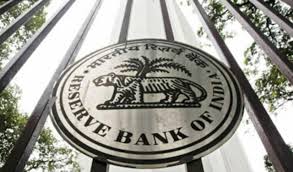

The Reserve Bank of India (RBI) issued an advisory for all banks to adopt the Financial Fraud Risk Indicator (FRI) developed by the Department of Telecommunications (DoT). This initiative is advancement in combatting cyber-enabled financial fraud in India. The FRI aims to enhance the security of digital transactions by providing real-time risk assessments of mobile numbers associated with financial activities.
What is the Financial Fraud Risk Indicator?
The Financial Fraud Risk Indicator is a metric that categorises mobile numbers based on their risk of being involved in financial fraud. It classifies numbers into Medium, High, or Very High risk categories. This classification is derived from data collected from various sources, including the Indian Cyber Crime Coordination Centre (I4C) and inputs from banks and financial institutions.
How Does the FRI Work?
The FRI operates through a multi-dimensional analytical tool. It assesses mobile numbers against a range of risk factors. When a number is flagged, the system conducts an analysis and promptly shares the risk classification with relevant stakeholders. This enables banks and financial institutions to take immediate preventive actions.
Benefits for Financial Institutions
Banks and financial institutions can leverage the FRI to enhance their fraud prevention strategies. They can decline suspicious transactions, issue alerts to customers, and delay transactions flagged as high-risk. This proactive approach helps in safeguarding customers from potential financial losses.
Collaboration Among Stakeholders
The implementation of the FRI has encourageed collaboration between the DoT, RBI, and various financial institutions. Leading UPI platforms, such as PhonePe and Paytm, have begun integrating FRI alerts into their systems. This collaboration enhances the efficacy of fraud detection and response mechanisms across the financial sector.
Impact on Digital Payments
As UPI continues to be the preferred payment method in India, the FRI is poised to reduce the incidence of cyber fraud. By providing timely risk assessments, the FRI empowers users and institutions to make informed decisions during transactions. This intervention could save millions from falling victim to cyber fraud.
Future of Cybersecurity in India
The FRI represents a step towards a more secure digital financial ecosystem in India. As more institutions adopt this framework, it is expected to evolve into a standard practice. The ongoing commitment of the DoT to enhance cybersecurity measures will further strengthen the trust of citizens in digital transactions.
(NNI / Latest news / Latest news india / India latest news/UPSC Preparation)
RBI’s Financial Stability Report
Latest News: 02nd July 2025, UPSC Preparation


India achieved milestone by securing a position among the top 100 countries in the United Nations Sustainable Development Goals (SDGs) Index. This ranking is part of the Sustainable Development Report, which evaluates the progress of nations in achieving the 17 SDGs established in 2015. India ranks 99th out of 193 countries, scoring 67 points. This marks a notable improvement in its commitment to sustainable development.
About the SDG Index
The SDG Index measures countries based on their performance across various sustainable development indicators. The index includes metrics related to poverty, education, health, and environmental sustainability. The report is produced by the U.N. Sustainable Development Solutions Network, with renowned economist Jeffrey Sachs leading the analysis.
Global Rankings and Comparisons
In the 2025 report, India is positioned at 99th place, trailing behind China at 49th and the United States at 44th. Among South Asian countries, Bhutan, Nepal, and Bangladesh are also evaluated, with Bhutan ranking highest at 74th. The report marks that European nations, particularly the Nordic countries, dominate the top spots, with Finland leading the index.
Progress and Challenges in SDG Implementation
Despite the overall progress in the SDG Index, the report indicates that globally only 17% of SDG targets are on track to be achieved by the 2030 deadline. Factors such as conflicts, economic vulnerabilities, and limited fiscal resources hinder progress in many regions. Countries like Nepal and Cambodia have shown improvements, indicating that rapid socioeconomic development can lead to better SDG outcomes.
Key Areas of Improvement
The report identifies several areas where countries have made substantial progress since 2015. These include access to electricity, mobile broadband, and reductions in under-five mortality rates. However, it also notes reversals in critical areas such as obesity rates and press freedom, denoting the uneven nature of progress.
Global Financial Architecture Concerns
The report puts stress on the need for reform in the global financial architecture. It points out that capital flows preferentially to wealthier nations, leaving emerging and developing economies underfunded despite their growth potential. The upcoming International Conference on Financing for Development aims to address these disparities and promote more equitable funding mechanisms.
Commitment to Multilateralism
The report ranks countries based on their commitment to UN multilateralism, with Barbados, Jamaica, and Trinidad and Tobago leading the list. Notably, the United States ranks last for the second consecutive year, having withdrawn from key international agreements, which raises concerns about global cooperation on sustainable development.
(NNI / Latest news / Latest news india / India latest news/UPSC Preparation)
India’s SDG Ranking in 2025
Latest News: 25th June 2025, UPSC Preparation
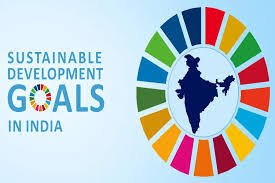

India achieved milestone by securing a position among the top 100 countries in the United Nations Sustainable Development Goals (SDGs) Index. This ranking is part of the Sustainable Development Report, which evaluates the progress of nations in achieving the 17 SDGs established in 2015. India ranks 99th out of 193 countries, scoring 67 points. This marks a notable improvement in its commitment to sustainable development.
About the SDG Index
The SDG Index measures countries based on their performance across various sustainable development indicators. The index includes metrics related to poverty, education, health, and environmental sustainability. The report is produced by the U.N. Sustainable Development Solutions Network, with renowned economist Jeffrey Sachs leading the analysis.
Global Rankings and Comparisons
In the 2025 report, India is positioned at 99th place, trailing behind China at 49th and the United States at 44th. Among South Asian countries, Bhutan, Nepal, and Bangladesh are also evaluated, with Bhutan ranking highest at 74th. The report marks that European nations, particularly the Nordic countries, dominate the top spots, with Finland leading the index.
Progress and Challenges in SDG Implementation
Despite the overall progress in the SDG Index, the report indicates that globally only 17% of SDG targets are on track to be achieved by the 2030 deadline. Factors such as conflicts, economic vulnerabilities, and limited fiscal resources hinder progress in many regions. Countries like Nepal and Cambodia have shown improvements, indicating that rapid socioeconomic development can lead to better SDG outcomes.
Key Areas of Improvement
The report identifies several areas where countries have made substantial progress since 2015. These include access to electricity, mobile broadband, and reductions in under-five mortality rates. However, it also notes reversals in critical areas such as obesity rates and press freedom, denoting the uneven nature of progress.
Global Financial Architecture Concerns
The report puts stress on the need for reform in the global financial architecture. It points out that capital flows preferentially to wealthier nations, leaving emerging and developing economies underfunded despite their growth potential. The upcoming International Conference on Financing for Development aims to address these disparities and promote more equitable funding mechanisms.
Commitment to Multilateralism
The report ranks countries based on their commitment to UN multilateralism, with Barbados, Jamaica, and Trinidad and Tobago leading the list. Notably, the United States ranks last for the second consecutive year, having withdrawn from key international agreements, which raises concerns about global cooperation on sustainable development.
(NNI / Latest news / Latest news india / India latest news/UPSC Preparation)
India’s First Household Income Survey
Latest News: 24th June 2025, UPSC Preparation
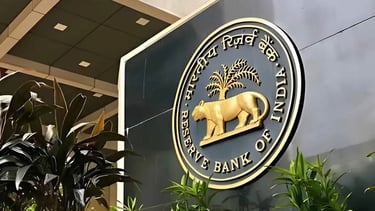

On June 20, 2025, the Reserve Bank of India announced a significant policy change: the mandatory share of lending by Small Finance Banks (SFBs) to priority sectors—such as agriculture and micro‑enterprises—has been reduced from 75% to 60% of their Adjusted Net Bank Credit. The move aims to give these lenders greater freedom to diversify loan portfolios, allocate more funds to emerging and mid‑market segments, and better manage credit risk, while still maintaining support for underserved sectors.
The lower threshold is likely to ease pressure on SFBs that have been overly reliant on priority lending due to regulatory quotas. This should enable them to venture more into retail, mid‑corporate, and other commercial banking segments without compromising their foundational social mandate. Still, watchdogs and analysts are cautious: they note that the shift could potentially dampen credit flow to agriculture and small industries, requiring vigilant oversight to ensure that financial inclusion goals aren't sidelined.
(NNI / Latest news / Latest news india / India latest news/UPSC Preparation)
“India's central bank cuts small finance banks' lending requirement to priority sectors”
Latest News: 21st June 2025


On June 20, 2025, the Reserve Bank of India announced a significant policy change: the mandatory share of lending by Small Finance Banks (SFBs) to priority sectors—such as agriculture and micro‑enterprises—has been reduced from 75% to 60% of their Adjusted Net Bank Credit. The move aims to give these lenders greater freedom to diversify loan portfolios, allocate more funds to emerging and mid‑market segments, and better manage credit risk, while still maintaining support for underserved sectors.
The lower threshold is likely to ease pressure on SFBs that have been overly reliant on priority lending due to regulatory quotas. This should enable them to venture more into retail, mid‑corporate, and other commercial banking segments without compromising their foundational social mandate. Still, watchdogs and analysts are cautious: they note that the shift could potentially dampen credit flow to agriculture and small industries, requiring vigilant oversight to ensure that financial inclusion goals aren't sidelined.
(NNI / Latest news / Latest news india / India latest news/UPSC Preparation)
"The Fed's Two-Day Policy Meeting Kicked Off Tuesday—What You Need To Know"
Latest News: 18th June 2025


The Federal Reserve commenced its two-day monetary policy meeting on June 17, 2025, amid a complex economic landscape characterized by persistent inflation concerns and political pressures. The central bank is expected to maintain the federal funds rate at 4.25%-4.5%, continuing its strategy to curb inflation by keeping rates elevated. Despite inflation nearing the Fed’s 2% annual target, officials are wary that recently proposed tariffs by President Trump could reignite inflationary pressures later in the year. The cautious approach reflects the Fed's commitment to its dual mandate of promoting maximum employment and stable prices, while also navigating the uncertainties introduced by new trade policies.
This decision comes amid external pressures, including calls from former President Donald Trump advocating for rate cuts to stimulate economic activity. Trump has publicly urged the Fed to reduce rates by up to a full percentage point and even summoned Fed Chair Jerome Powell to the White House. However, the Fed has reaffirmed its independence, with Powell declining to comment on the President's remarks. Analysts caution that acting under perceived political duress could damage the Fed’s credibility, inflame inflation expectations, and destabilize financial markets. As the Fed continues to assess economic indicators, its cautious stance underscores the importance of maintaining impartiality in monetary policy decisions.
(NNI / Latest news / Latest news india / India latest news/UPSC Preparation)
Rupee Interest Rate Derivatives Regulations 2025
Latest News: 17th June 2025, UPSC Preparation


The Reserve Bank of India (RBI) has recently proposed draft regulations for Rupee Interest Rate Derivatives (IRD) to modernise the existing framework. This move follows developments in the market since the last regulations were issued in June 2019. The RBI aims to align the regulatory framework with current market conditions and enhance participation from non-resident entities.
About Interest Rate Derivatives
Interest rate derivatives are financial contracts whose value is linked to interest rates. They include instruments like futures, options, swaps, and swaptions. These derivatives are primarily used for hedging against interest rate fluctuations. They help investors manage risk associated with changes in market interest rates.
Types of Interest Rate Derivatives
Common types of interest rate derivatives include:
Interest Rate Swaps: Agreements to exchange cash flows based on different interest rates.
Interest Rate Futures: Contracts to buy or sell an interest-bearing asset at a predetermined price in the future.
Caps and Floors: Instruments that set upper and lower limits on interest rate payments.
Interest Rate Collars: Combine caps and floors to manage risk within a specified range.
Market Developments and Regulatory Changes
The RBI’s draft regulations reflect the evolving market landscape. They allow non-residents to engage in IRD transactions through central treasuries or group entities. This encourages broader participation and liquidity in the market. The draft also proposes simplified reporting requirements to reduce compliance burdens for market participants.
Importance of Interest Rate Risk Management
Interest rate risk can affect the value of interest-bearing assets like loans and bonds. Managing this risk is crucial for financial stability. Interest rate derivatives provide tools for entities to hedge against potential losses. They can also be employed for speculative purposes, allowing investors to bet on future interest rate movements.
Enhancing Transparency in the Market
The proposed regulations aim to improve transparency in the Rupee IRD market. By introducing requirements for reporting global IRD transactions, the RBI seeks to create a more robust oversight mechanism. This is expected to encourage trust among market participants and enhance overall market efficiency.
(NNI / Latest news / Latest news india / India latest news/UPSC Preparation)
RBI’s Monetary Policy Space Shrinks, Says UBS Following Recent Rate Cut and Liquidity Boost
Latest News: 16th June 2025
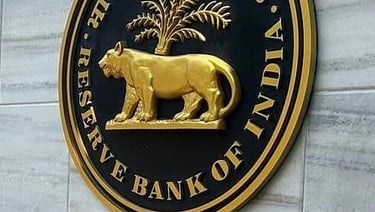

Following the recent sharp rate cut and a significant liquidity injection by the Reserve Bank of India (RBI), UBS has stated that the central bank now has limited room for further monetary easing. The recent actions were aimed at stimulating growth amid global economic uncertainties and domestic inflation pressures. However, UBS notes that with inflation still a concern and economic growth showing signs of recovery, the RBI must tread cautiously to avoid overheating the economy or triggering excessive inflation.
UBS further explains that while the rate cut and cash infusion provide a short-term boost to liquidity and credit flow, the RBI’s flexibility for additional cuts is constrained by macroeconomic realities. The central bank is likely to focus more on managing inflation expectations and ensuring financial stability in the near term. This signals a shift from aggressive easing to a more balanced and data-dependent approach in upcoming monetary policy decisions.
(NNI / Latest news / Latest news india / India latest news/UPSC Preparation)
SEBI Introduces New UPI Payment Mechanism for Investors
Latest News: 15th June 2025, UPSC Preparation


The Securities and Exchange Board of India (SEBI) is set to implement a new Unified Payment Interface (UPI) address mechanism by October 1, 2025. This initiative aims to protect investors from unregistered entities in the stock market. The new system will allow investors to easily identify legitimate SEBI-registered intermediaries before making payments.
Background of the Initiative
Unregistered entities have increasingly misled investors, collecting funds without proper authorisation. This has led to financial losses for many individuals. SEBI’s new UPI mechanism is a proactive response to these fraudulent activities. It aims to enhance investor confidence and ensure safer transactions in the securities market.
Structure of the New UPI Mechanism
The new UPI addresses will feature a unique identifier, @valid. This identifier will be combined with the intermediary’s name and a suffix that denotes their category. For example, a stock broker would have a suffix of ‘.brk’, while a mutual fund would use ‘.mf’. This structure is designed to help investors easily identify legitimate intermediaries.
Benefits of the New UPI IDs
The introduction of validated UPI IDs will improve transaction safety. Investors will have a clear visual cue—a thumbs-up inside a green triangle icon—when making payments to registered intermediaries. This visual indicator aims to prevent impersonation and fraudulent activities.
Mandatory Compliance for Intermediaries
All registered intermediaries are required to adopt the new UPI IDs. They must inform investors about this new payment option and ensure it is offered as a primary payment method. Existing UPI IDs will no longer be accepted after the implementation date.
Investor Payment Options
While the new UPI handle is mandatory for intermediaries, its use remains optional for investors. They can still choose from various payment methods, including Immediate Payment Service (IMPS), National Electronic Funds Transfer (NEFT), and Real Time Gross Settlement (RTGS). However, if they opt for UPI, they must use the new validated IDs.
The SEBI Check Tool
To enhance security, SEBI is developing a tool called ‘SEBI Check’. This tool will enable investors to verify the authenticity of UPI IDs by scanning a QR code or entering the ID manually. It will also confirm bank details, such as account numbers and IFSC codes, providing an additional layer of protection for investors.
Timeline for Implementation
The SEBI Check tool and the new UPI IDs are currently under development. Both will be available to investors starting October 1, 2025. This timeline allows for a smooth transition and ensures that investors are well-informed about the changes.
(NNI / Latest news / Latest news india / India latest news/UPSC Preparation)
UBS: RBI's Aggressive Easing Strategy May Limit Future Monetary Policy Options
Latest News: 14th June 2025
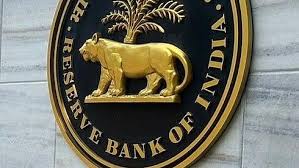

The Reserve Bank of India (RBI) has implemented its most significant interest rate cut in five years, reducing the key repo rate by 50 basis points to 5.50% and lowering the cash reserve ratio (CRR) by 100 basis points to 3%. These measures aim to stimulate economic growth amid global uncertainties and underwhelming domestic investment. However, UBS analysts caution that these aggressive moves have left the RBI with limited room for further monetary easing in the near future.
UBS highlights that while current inflation is low, creating room for policy flexibility, the central bank's shift from an "accommodative" to a "neutral" stance indicates a more cautious approach moving forward. The significant rate cuts and liquidity injections may not be sufficient to counteract structural challenges such as lagging private investments and rising core inflation. As a result, UBS suggests that the RBI may face challenges in implementing additional rate cuts without risking financial market volatility or undermining long-term economic stability.
(NNI / Latest news / Latest news india / India latest news/UPSC Preparation)
"RBI Ends Daily VRR Auctions Due to Evolving Liquidity Conditions"
Latest News: 12th June 2025

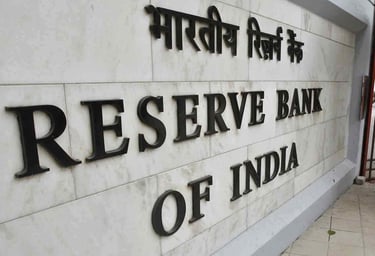
The Reserve Bank of India (RBI) has decided to discontinue its daily Variable Rate Reverse Repo (VRR) auctions starting June 11, 2025, due to the current surplus liquidity in the banking system. This move indicates that financial institutions now have adequate funds and no longer require daily borrowing support from the central bank. VRR auctions, which allow banks to borrow money from the RBI at varying interest rates, were previously used to manage short-term liquidity needs. The cessation of these auctions reflects the RBI's assessment that the financial environment does not necessitate such daily operations at this time.
This policy adjustment underscores the RBI's adaptive approach to managing liquidity in accordance with prevailing economic conditions. By halting daily VRR auctions, the central bank aims to align its operations with the current surplus liquidity scenario, ensuring that the banking system operates efficiently without excess intervention. Market participants will be closely monitoring the RBI's future actions to understand its strategy for maintaining liquidity balance and supporting economic stability.
(NNI / Latest news / Latest news india / India latest news/UPSC Preparation)
Economic Growth Outlook Dims: World Bank Cuts India’s FY26 GDP Forecast to 6.3%
Latest News: 11th June 2025


The World Bank has revised India’s Gross Domestic Product (GDP) growth forecast for the fiscal year 2025-26 to 6.3%, down from its previous estimate. This downward revision reflects concerns over global economic uncertainties, rising inflationary pressures, and potential domestic challenges that could impact India’s growth trajectory. Despite the cut, India remains one of the fastest-growing major economies, but the revised forecast signals a need for cautious optimism in economic planning and policy-making.
The World Bank’s updated outlook comes amid a mixed global economic environment, with slowing growth in key markets and persistent geopolitical tensions affecting trade and investment flows. Experts suggest that India’s ability to sustain its growth momentum will depend on factors such as policy reforms, infrastructure development, and effective management of inflation. The revision underscores the importance of strategic interventions to bolster economic resilience and support long-term growth prospects.
(NNI / Latest news / Latest news india / India latest news/UPSC Preparation)
"SEBI's Insider Trading Investigation at IndusInd Bank Expands; More Orders Likely"
Latest News: 09th June 2025
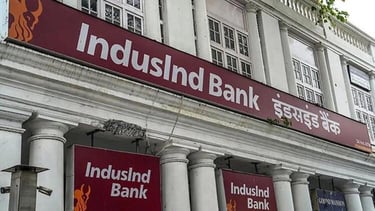

The Securities and Exchange Board of India (SEBI) is intensifying its investigation into insider trading activities at IndusInd Bank, with potential for additional enforcement actions against senior executives. Earlier this year, SEBI issued an ex-parte interim order barring five top officials, including former CEO Sumant Kathpalia, from accessing the securities market. These individuals allegedly sold shares while in possession of unpublished price-sensitive information concerning significant derivative losses, thereby avoiding losses estimated at approximately ₹20 crore.
In a recent development, SEBI issued a corrigendum to its previous order, clarifying that a key document cited during the investigation was an "engagement note," not a "board note" as initially stated. This correction addresses concerns regarding the extent of internal knowledge and authorization within the bank related to the appointment of auditing firm KPMG and the associated valuation issues. As the investigation progresses, SEBI is considering issuing additional orders, which may include monetary penalties, market bans, and internal disciplinary actions such as the claw-back of bonuses, depending on the findings. The outcome of this probe could have significant implications for IndusInd Bank's governance practices and regulatory compliance.
(NNI / Latest news / Latest news india / India latest news/UPSC Preparation)
Statistical Business Register
Latest News: 08th June 2025


The Government of India is set to launch a Statistical Business Register (SBR). This initiative aims to enhance the quality of business data across the country. The Ministry of Statistics and Programme Implementation (MoSPI) is leading this project. The SBR will provide a comprehensive database of businesses operating at district and state levels.
Purpose of the Statistical Business Register
The SBR will serve multiple purposes. It will facilitate business outlook and sentiment surveys. The data will help in market analysis and policy formulation. It will also aid in estimating Gross Domestic Product (GDP) and analysing industrial performance. The SBR aims to create a unified data repository for better decision-making.
Data Sources for the SBR
The SBR will gather data from various sources. Key contributors include the Employees’ Provident Fund Organisation (EPFO) and the corporate affairs ministry. Goods and Services Tax (GST) data will also be integrated. The annual survey of industries (ASI) will provide additional insights. Furthermore, the Economic Census will offer data on both organised and unorganised sectors.
Frequency of Updates
The SBR is expected to be updated regularly. Updates will occur either quarterly or monthly. The frequency will depend on the feasibility of data collection and processing. This will ensure that the data remains current and relevant.
Alignment with International Standards
The SBR aligns with recommendations from the United Nations Statistics Division (UNSD). This international body promotes the establishment of SBRs in developing countries. Over 60% of such nations have adopted similar frameworks. The initiative aims to address issues like data fragmentation and duplication in business statistics.
Importance of a Unified Data Repository
Currently, business statistics in India face challenges. There is non-uniformity and a lack of a unified data repository. The SBR aims to resolve these issues. A centralised system will improve data accuracy and accessibility. This will enhance the overall quality of statistical information available for analysis.
Role of the United Nations Statistics Division
The UNSD plays important role in global statistical activities. It oversees the compilation and dissemination of statistical information. The division develops standards for statistical practices. It also supports countries in strengthening their national statistical systems. Regular publications and data updates are part of its mandate.
(NNI / Latest news / Latest news india / India latest news/UPSC Preparation)
Repo Rate Cut by RBI: What It Means for Your Loan EMIs
Latest News: 06th June 2025
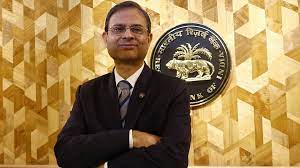

The Reserve Bank of India (RBI) has announced a significant monetary policy move by reducing the repo rate by 50 basis points (0.5%), aiming to boost economic growth amid global uncertainties. The repo rate is the interest rate at which the RBI lends money to commercial banks. By cutting this rate, the RBI lowers the cost of borrowing for banks, which is expected to be passed on to consumers in the form of reduced interest rates on loans.
For borrowers with floating-rate loans such as home loans, personal loans, or auto loans, this rate cut typically translates into lower Equated Monthly Installments (EMIs). Banks generally adjust their lending rates following the RBI’s policy changes, which means customers may benefit from reduced monthly payments, easing their financial burden. However, the actual impact on EMIs depends on the bank’s lending policies and how quickly they transmit the rate cut to consumers.
(NNI / Latest news / Latest news india / India latest news/UPSC Preparation)
RBI Introduces Additional Factor Authentication for International Transactions
Latest News: 05th June 2025, UPSC Preparation


The Reserve Bank of India (RBI) has announced enhancement to the security of online payments. This new measure focuses on cross-border “Card Not Present” (CNP) transactions. The introduction of Additional Factor of Authentication (AFA) aims to ensure that international digital transactions using Indian-issued cards are as secure as domestic ones. This move comes in response to the increasing volume of online shopping and the associated rise in fraud risks.
About Additional Factor of Authentication (AFA)
AFA is a security process that requires more than one method of verification to authenticate a transaction.
Previously, AFA was mandated only for domestic transactions.
This additional layer of security typically involves a One-Time Password (OTP) or biometric verification.
Its implementation has reduced fraud in domestic online payments, encouraging consumer confidence.
The Need for AFA in International Transactions
With the rise of e-commerce, Indian consumers are increasingly purchasing goods from overseas merchants.
However, without AFA, these cross-border transactions have remained vulnerable to cyber threats.
The absence of physical card verification increases the risk of fraud.
The RBI has recognised this gap and is extending AFA to cover international CNP transactions, thereby enhancing consumer protection.
Proposed Changes by RBI
The RBI’s proposal will require cardholders to undergo additional verification when making international purchases. This may include OTPs sent to registered mobile numbers or biometric checks. The RBI aims to issue a draft circular for stakeholder feedback shortly. This initiative is part of a broader framework to improve the security of digital payments in India.
Framework for Digital Payment Security
Last year, the RBI introduced a draft framework to enhance digital payment security.
This framework mandates that all digital transactions, excluding card-present ones, must use a dynamically generated authentication factor.
This factor is unique to each transaction and cannot be reused.
The framework categorises authentication factors into three types
Something the user knows – Examples include passwords and PINs.
Something the user has – This includes physical devices like ATM cards.
Something the user is – This encompasses biometric identifiers like fingerprints.
Implications for Indian Consumers
The introduction of AFA for international transactions is expected to provide Indian consumers with a similar level of security as that offered for domestic transactions. This measure will likely encourage more consumers to engage in online shopping with overseas merchants, knowing their payments are safeguarded against fraud.
(NNI / Latest news / Latest news india / India latest news/UPSC Preparation)
Evaluation of Centrally Sponsored Schemes
Latest News: 02nd June 2025, UPSC Preparation
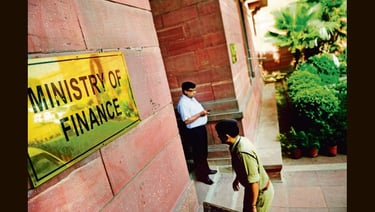

The Government of India has initiated a comprehensive evaluation of Centrally Sponsored Schemes (CSSs) and Central Sector Schemes (CSs). This exercise aims to assess the effectiveness and relevance of these schemes over the next five years, starting from April 2026. The evaluation aligns with the 16th Finance Commission cycle and follows a workshop led by key officials from the Ministry of Finance.
Purpose of the Evaluation
The evaluation aims to improve public expenditure quality. It seeks to ensure that each scheme has a defined sunset date and undergoes outcome reviews. This strategy was first articulated in the Union Budget Speech of 2016. The Government believes that rigorous evaluations can lead to better resource allocation and enhanced scheme effectiveness.
Structure of the Schemes
There are 54 CSSs and 260 CSs currently in operation. CSSs are co-funded by both the central and state governments, whereas CSs are fully funded by the central government. Each scheme’s continuation will depend on third-party evaluations and their alignment with the Finance Commission’s recommendations.
Financial Overview
The Department of Expenditure provided insights on financial resources available for the upcoming cycle. The budget for capital expenditure stands at Rs. 11.21 lakh crore for FY 2025-26. This funding puts stress on the government’s commitment to enhancing infrastructure and social services through well-evaluated schemes.
Policy Priorities
Key policy priorities discussed included adopting a challenge mode of financing, promoting universal Aadhaar-based Direct Benefit Transfers (DBT), and ensuring the convergence of various schemes. These strategies aim to eliminate duplication of efforts and drive meaningful reforms.
Implementation Strategies
The government emphasised the need for timely fund releases to avoid fund parking. This concept of ‘just in time’ funding will allow the government to reallocate savings from completed schemes to new or ongoing projects, thus enhancing overall efficiency.
Evaluation Agencies
The Development Monitoring Evaluation Organisation (DMEO) in NITI Aayog is responsible for evaluating CSSs. For CSs, evaluations are conducted by third-party agencies selected by the respective ministries. This dual approach ensures a broad and objective assessment of scheme effectiveness.
(NNI / Latest news / Latest news india / India latest news/UPSC Preparation)
RBI Balance Sheet Growth and Economic Outlook 2025
Latest News: 31st May 2025, UPSC Preparation
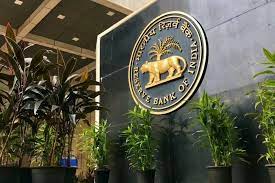

The Reserve Bank of India (RBI) reported growth in its balance sheet for the financial year 2024-25. The total balance sheet expanded to ₹76.25 lakh crore, marking an 8.2% increase from the previous year. This growth was boosted by substantial gains in foreign exchange transactions and a rise in gold and domestic investments. The RBI’s annual report marks the resilience of the Indian economy amid global challenges, positioning India as the fastest-growing major economy in 2025-26.
Key Financial Highlights
The RBI’s income rose by 22.77% while expenditures increased by 7.76%. The overall surplus for the year reached ₹2.69 trillion, a 27.37% increase compared to the previous year. The balance sheet growth was largely attributed to a 52.09% rise in gold holdings, a 14.32% increase in domestic investments, and a 1.70% rise in foreign investments.
Composition of Assets and Liabilities
As of March 31, 2025, domestic assets accounted for 25.73% of total assets, while foreign currency assets, gold, and loans to financial institutions made up 74.27%. On the liabilities side, increases were noted in notes issued (6.03%), revaluation accounts (17.32%), and other liabilities (23.31%).
Currency Circulation Trends
The value of banknotes in circulation increased by 6% during 2024-25. The share of ₹500 banknotes decreased slightly in value terms but remained the most circulated denomination. The withdrawal of ₹2000 banknotes continued, with 98.2% of the currency returned to the banking system. The value of coins in circulation rose by 9.6%.
Digital Currency and Counterfeit Notes
The e-rupee saw a remarkable increase of 334% in circulation. The report noted a decline in counterfeit notes for most denominations, except for ₹200 and ₹500, which saw increases of 13.9% and 37.3% respectively.
Economic Resilience and Policy Outlook
The RBI’s report indicates that the Indian economy is well-positioned for sustainable growth, supported by sound macroeconomic fundamentals. Factors such as easing supply-chain pressures and higher agricultural production contribute positively to the inflation outlook. The RBI expressed confidence in achieving a durable alignment of headline inflation to the 4% target within a 12-month horizon.
Recommendations
The RBI advised banks to manage interest rate risks effectively, given the changing economic landscape. It brought into light the importance of addressing both trading and banking book risks, especially with moderating net interest margins.
(NNI / Latest news / Latest news india / India latest news/UPSC Preparation)
RBI Moves to Internationalise INR
Latest News: 30th May 2025, UPSC Preparation
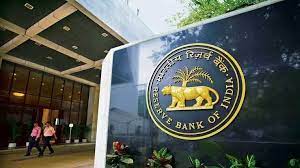

The Reserve Bank of India (RBI) is making strides towards internationalising the Indian Rupee. Recently, the RBI sought approval from the Government of India to allow domestic banks to lend rupees to overseas borrowers. This initiative aims to enhance the use of the rupee in international trade, particularly with neighbouring countries.
Proposal
The RBI’s proposal suggests that domestic banks and their foreign branches lend in rupees to non-residents. Initially, this would focus on neighbouring countries such as Bangladesh, Bhutan, Nepal, and Sri Lanka. If successful, this could eventually extend to global cross-border transactions. Currently, Indian banks can only provide loans in foreign currencies, primarily to Indian firms.
Trade Context
In the fiscal year 2024-25, India’s exports to South Asia amounted to approximately $25 billion. Notably, 90% of these exports were directed towards Bangladesh, Bhutan, Nepal, and Sri Lanka. This marks the potential market for rupee-denominated lending in these regions.
Strategic Steps by RBI
Over recent years, the RBI has implemented various measures to promote the rupee in foreign transactions. The central bank has allowed non-residents to open rupee accounts outside India. Furthermore, it has sought to remove caps on foreign banks with vostro accounts buying short-term sovereign debt. These steps aim to boost rupee-denominated investments and trade.
Current Lending Restrictions
At present, the foreign branches of Indian banks are limited to providing loans in foreign currencies. This restriction hampers the potential for rupee transactions in international trade. The proposed lending in rupees aims to facilitate trade settlements and reduce exposure to foreign exchange volatility.
Reducing Reliance on Government Support
Currently, rupee liquidity in other countries is available only through a limited number of government-backed credit lines or bilateral currency swap arrangements. The RBI’s objective is to reduce this dependence and allow commercial banks to provide rupee liquidity based on market conditions.
Previous Initiatives
India has previously entered into local currency agreements with countries like the United Arab Emirates, Indonesia, and the Maldives. These agreements have demonstrated the feasibility of increasing transactions in local currencies, including the Indian Rupee. The RBI’s recent moves are part of a broader strategy to deepen the availability of rupee liquidity in international markets.
(NNI / Latest news / Latest news india / India latest news/UPSC Preparation)
Revised Economic Capital Framework of the Reserve Bank
Latest News: 29th May 2025, UPSC Preparation


The Reserve Bank of India (RBI) has recently updated its Economic Capital Framework (ECF). This revision aims to provide the central bank with enhanced flexibility in managing surplus transfers to the government. This approach ensures that fiscal stability is maintained even in volatile economic conditions. The new framework allows for a contingency risk buffer (CRB) range of 4.5-7.5 per cent, expansion from the previous 5.5-6.5 per cent range.
Surplus Transfer to Government
In a remarkable move, the RBI’s central board approved a surplus transfer of approximately ₹2.69 trillion to the government for the fiscal year 2024-25. This transfer occurred despite maintaining the CRB at the upper limit of 7.5 per cent. The surplus was boosted by the RBI’s robust earnings from foreign exchange transactions. The gross dollar sales dramatically increased from $153 billion in FY24 to $399 billion in FY25.
Earnings and Asset Management
The RBI’s earnings have seen a substantial rise due to increased interest income from government securities. Additionally, lower provisioning for revaluation losses on assets contributed to this growth. The central bank is likely benefiting from mark-to-market gains on both foreign and domestic asset holdings. This financial strategy has enabled the RBI to manage its balance sheet effectively while ensuring a healthy surplus transfer.
Historical Context of the CRB
The CRB has undergone several adjustments over the years. From FY19 to FY22, the RBI maintained a CRB of 5.50 per cent. In FY23, it increased to 6 per cent, and further to 6.5 per cent in FY24. The recent increase to 7.5 per cent is a response to exceptional economic conditions. This flexibility allows the RBI to adjust the CRB based on the prevailing economic environment, ensuring stability in surplus transfers.
Recommendations and Future Outlook
The revised ECF was adopted based on recommendations from an expert committee led by former RBI governor Bimal Jalan. This committee suggested regular reviews of the framework every five years. The RBI aims to strengthen the ECF to better align with emerging risks. This proactive approach is crucial in maintaining a resilient balance sheet amid global economic uncertainties.
Economic Implications
The adjustments to the ECF are designed to ensure that the RBI can respond effectively to changing economic conditions. This flexibility is particularly important in uncertain environments where previous surplus transfers have varied . For instance, the transfer of ₹2.1 trillion in FY24 was the highest ever, while the ₹30,000 crore transfer in FY22 was the lowest in over a decade. The broad CRB range allows the RBI to navigate these fluctuations more adeptly.
(NNI / Latest news / Latest news india / India latest news/UPSC Preparation)
India’s Agricultural Trade
Latest News: 28th May 2025, UPSC Preparation


India’s agricultural trade has witnessed developments in recent years. In the fiscal year 2024-25, agricultural exports rose by 6.4% to reach $51.9 billion. This increase contrasts sharply with the overall goods export growth, which remained nearly flat at 0.1%. Meanwhile, agricultural imports surged by 17.2%, denoting a growing dependency on foreign products.
Export Growth Trends
Agricultural exports have shown a recovery since 2019-20. The peak was in 2022-23, when exports reached $53.1 billion. However, the current figure of $51.9 billion indicates a slight decline from that peak. Key export commodities include marine products, rice, spices, and coffee. Marine products, despite a recent drop, remain export, primarily to the US and China.
Import Dynamics
India’s agricultural imports have increased , from $15.5 billion in 2013-14 to $38.5 billion in 2024-25. The main import items include vegetable oils and pulses, driven by low domestic production and yield issues. This trend reflects a growing reliance on international markets for essential food items.
Major Export Commodities
Rice has emerged as a standout export, with non-basmati and basmati varieties reaching record values. In 2024-25, exports totalled $12.5 billion. Other notable exports include spices, tobacco, and fruits, all of which have seen increased demand in global markets. Coffee exports benefited from global supply shortages, particularly due to adverse weather conditions in major producing countries.
Import Challenges
The surge in imports can be attributed to stagnant domestic production of key crops such as oilseeds and pulses. Farmers face challenges due to low yields and the absence of a robust government procurement system. These factors contribute to a rising import bill, especially for vegetable oils and pulses, which surpassed $5 billion for the first time.
Trade Agreements Impact
India is currently negotiating trade agreements with the US, EU, and UK. These agreements may lead to tariff reductions and increased market access for agricultural products. The outcomes of these negotiations could shape India’s agricultural trade landscape in the coming years.
Agricultural Trade Surplus
India’s agricultural trade surplus has halved from $27.7 billion in 2013-14 to $13.4 billion in 2024-25. This decline reflects the increasing import bill and the challenges faced by domestic producers. The balance between exports and imports remains critical for the sustainability of India’s agricultural sector.
(NNI / Latest news / Latest news india / India latest news/UPSC Preparation)
FATF’s Role in Global Financial Oversight
Latest News: 26th May 2025, UPSC Preparation
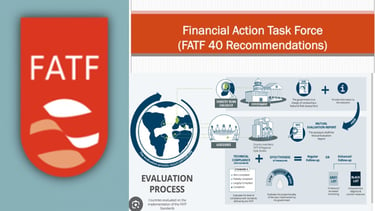

India is set to submit a dossier to the Financial Action Task Force (FATF) to advocate for Pakistan’s reinstatement on the “grey list“. This move marks ongoing concerns about Pakistan’s compliance with anti-money laundering and counter-terrorism financing regulations. The FATF, an inter-governmental organisation, plays important role in monitoring global financial practices and ensuring countries adhere to established standards.
What is the FATF?
The FATF is a global watchdog focused on money laundering and terror financing. Established in 1989, it comprises 40 members, including key nations worldwide. The organisation’s primary aim is to combat financial crimes by promoting international standards and assessing the effectiveness of countries’ measures against these crimes.
Monitoring Financial Crimes
The FATF monitors how criminals and terrorists manage their finances. It raises awareness about evolving techniques used in money laundering and terror financing. Through regular assessments, the FATF identifies jurisdictions that fail to implement adequate measures to combat these threats.
Setting Global Standards
The FATF has developed a comprehensive set of recommendations to facilitate a coordinated global response to organised crime, corruption, and terrorism. These standards guide countries in establishing robust frameworks to prevent financial crimes and pursue those involved in such activities.
Grey and Black Lists
The FATF categorises countries based on their compliance with anti-money laundering and counter-terrorism financing standards into grey and black lists. The grey list comprises jurisdictions with deficiencies but that are actively working to address them. Currently, 24 countries are on this list, which subjects them to increased monitoring.
Impacts of Greylisting
Being placed on the grey list can have severe economic repercussions. It affects foreign investment and international aid inflows. For instance, India has noted that Pakistan’s greylisting from 2018 to 2022 helped reduce illicit fund flows into regions like Jammu and Kashmir.
The Black List
The black list includes countries with serious deficiencies in their financial regulations. Currently, North Korea, Myanmar, and Iran are on this list. Countries in this category face mandatory economic sanctions, and other nations are urged to apply enhanced due diligence when interacting with them.
Recent Developments
India’s planned submission to the FATF reflects ongoing geopolitical tensions and concerns over financial integrity. Pakistan’s previous greylisting has been linked to curtailing illegal financial activities, particularly in sensitive regions. The FATF’s actions continue to influence international relations, economic strategies, and security measures.
(NNI / Latest news / Latest news india / India latest news/UPSC Preparation)
NITI Aayog CEO Announces India Overtakes Japan in Global Economic Rankings
Latest News: 25th May 2025

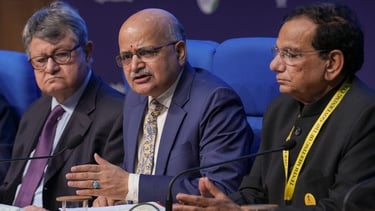
India has officially surpassed Japan to become the world's fourth-largest economy, according to B V R Subrahmanyam, CEO of NITI Aayog. This significant milestone was announced during a press briefing following the 10th Governing Council meeting of NITI Aayog. Subrahmanyam attributed India's rise to favorable geopolitical and economic conditions, highlighting the country's robust growth trajectory.
The International Monetary Fund (IMF) projects India's nominal GDP to reach $4.187 trillion in 2025, narrowly surpassing Japan's estimated $4.186 trillion. This shift reflects India's rapid economic expansion and Japan's more modest growth. Looking ahead, India is poised to overtake Germany, positioning itself as the third-largest economy by 2028, with a projected GDP of $5.58 trillion.
(NNI / Latest news / Latest news india / India latest news/UPSC Preparation)
Payments Regulatory Board
Latest News: 24th May 2025, UPSC Preparation
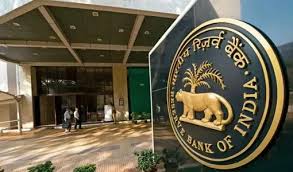

The Government of India introduced changes to its payments ecosystem by establishing the Payments Regulatory Board (PRB). This new regulatory body aims to enhance oversight of the payment and settlement systems. It replaces the previous Board for Regulation and Supervision of Payment and Settlement Systems (BPSS) under the Reserve Bank of India (RBI). The PRB’s formation reflects a growing recognition of the need for robust regulation in the rapidly evolving financial technology landscape.
Composition of the Payments Regulatory Board
The PRB will comprise the RBI Governor as Chairperson, the Deputy Governor responsible for payment systems, and three members nominated by the central government. The board may also invite experts in relevant fields to participate in discussions as ad hoc invitees. This composition ensures a blend of regulatory oversight and industry expertise.
Role of the Department of Payment and Settlement Systems
The Department of Payment and Settlement Systems (DPSS) will assist the PRB. It will be responsible for implementing policies and ensuring compliance with regulations. This partnership aims to streamline operations and enhance the efficiency of the payments ecosystem.
Voting Process
Each board member has one vote. Decisions will be made by a majority. In case of a tie, the Chairperson has the casting vote. This structure promotes democratic decision-making while maintaining a clear leadership role for the Chairperson.
Regulatory Powers and Delegation
The PRB can delegate its powers to the Chairperson, board members, or sub-committees. This flexibility allows for efficient administration and quick responses to emerging challenges in the payment landscape. Regular meetings, at least twice a year, will facilitate ongoing oversight.
Age and Conflict of Interest Restrictions
Nominated members must be below 70 years of age and free from conflicts of interest. These restrictions ensure that board members are capable of making unbiased decisions that serve the public interest.
Historical Context and Opposition
The establishment of the PRB follows a history of debate regarding the regulation of payment systems. In 2018, the RBI opposed the idea of an independent regulator outside its purview. The RBI argued that monetary policy’s influence on payment systems necessitated regulation by the central bank. The current structure aims to balance government involvement with central bank oversight.
Future Implications for the Payments Ecosystem
The new PRB is expected to encourage innovation and stability within India’s payment systems. By incorporating diverse expertise, it aims to address challenges holistically. This could lead to improved standards and coordination across various payment platforms, benefiting consumers and businesses alike.
(NNI / Latest news / Latest news india / India latest news/UPSC Preparation)
Sensex Faces Sharp Decline, Loses 720 Points; Nifty Follows Suit, Falls 220 Points in Early Trade
Latest News: 22nd May 2025, UPSC Preparation
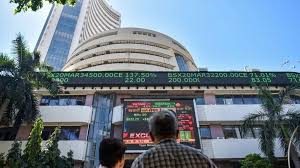

In a sharp market reaction to global and domestic uncertainties, the Sensex has dropped a staggering 720 points in early trading on Tuesday, while the Nifty slid by 220 points. Investors are grappling with mounting concerns over inflationary pressures, global interest rate hikes, and a slowdown in major economies. The sell-off was triggered by a combination of weak global cues and worries over the tightening of monetary policy, leading to a broad-based decline across sectors. The market witnessed heavy losses in banking, IT, and auto stocks, which were major contributors to the downturn.
Experts suggest that the current market volatility reflects investor caution ahead of key economic data releases and corporate earnings reports. With global markets also showing signs of weakness, Indian equities are not immune to the ripple effects. Analysts warn that the ongoing market correction could extend for the short term unless there is a change in macroeconomic fundamentals or a recovery in global markets. Investors are advised to stay vigilant and adopt a cautious approach in the current environment.
(NNI / Latest news / Latest news india / India latest news/UPSC Preparation)
Inflation Trends in India
Latest News: 21st May 2025, UPSC Preparation
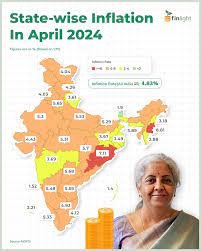

In recent years, India’s economic landscape has been shaped by fluctuating inflation rates and monetary policy adjustments. Between February 2023 and January 2025, the Reserve Bank of India (RBI) maintained its repo rate at 6.5%. During this period, inflation averaged 5.2% according to the Consumer Price Index (CPI). The Consumer Food Price Index (CFPI) saw an even higher average of 7.6%. Notably, core inflation, which excludes food and fuel, remained lower at 4.1%. This divergence prompted discussions on monetary policy strategies.
About Inflation Metrics
Inflation is assessed using various indices. The CPI includes all consumer goods, while the CFPI focuses solely on food prices. Core inflation excludes volatile items like food and fuel. This distinction is crucial for policymakers. Core inflation provides a clearer picture of underlying economic conditions. It is less influenced by temporary supply shocks.
Factors Influencing Inflation
Food and fuel inflation are affected by supply-side factors. Weather events, such as El Niño, can disrupt agricultural output. Geopolitical tensions, like the Russia-Ukraine conflict, can spike global commodity prices. These external factors create challenges for monetary policy, which primarily influences demand through interest rates.
RBI’s Monetary Policy Decisions
The RBI’s decisions are influenced by inflation trends. In 2023, the RBI faced pressure to reduce interest rates due to falling core inflation. However, persistent food inflation complicated these decisions. The RBI eventually cut the repo rate to 6% in early 2025. This move aimed to stimulate economic growth amid fluctuating inflation rates.
Recent Trends and Predictions
By early 2025, CFPI inflation fell to 1.8%, while core inflation rose to 4.2%. This shift indicated a potential change in policy focus. The RBI might prioritise core inflation over headline inflation. The end of El Niño and improved agricultural conditions contributed to stabilising food prices. Forecasts suggest a positive outlook for inflation in the upcoming monsoon season.
Currency Stability and External Influences
The Indian rupee’s stability has been factor in controlling inflation. Following a period of depreciation, the rupee stabilised around 85.5 to the dollar. This stability mitigates the risk of imported inflation. Additionally, the prospect of cheaper imports from countries like China may further ease inflationary pressures.
Future Monetary Policy Outlook
The RBI’s future monetary policy decisions will likely consider both food and core inflation. With a stable currency and improved domestic food supply, the RBI may find room to reduce rates further. This approach aims to support economic growth without igniting inflation.
(NNI / Latest news / Latest news india / India latest news/UPSC Preparation)
RBI Surplus Transfer
Latest News: 20th May 2025, UPSC Preparation
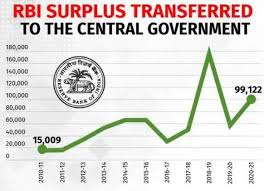

The Reserve Bank of India (RBI) plays important role in the Indian economy. Its surplus transfer to the government is for fiscal planning. The RBI is expected to transfer between ₹2.5 lakh crore and ₹3 lakh crore for the 2024-25 accounting year. This follows a record transfer of ₹2.11 lakh crore in the previous year.
About the Economic Capital Framework
The Economic Capital Framework (ECF) guides the RBI in determining risk provisioning and surplus distribution. The RBI’s central board reviews this framework to ensure financial stability. The ECF aims to align the central bank’s capital with its risk profile.
How the RBI Generates Income
The RBI earns income through various channels. It invests in foreign currency assets, including bonds and treasury bills. It also earns interest from local government securities. Additionally, the RBI charges a management commission for handling government borrowings. Its primary expenditures include printing currency and staff salaries.
Surplus Transfer Mechanism
The RBI does not pay dividends like commercial banks. Instead, it transfers surplus profits to the government. This process follows Section 47 of the Reserve Bank of India Act, 1934. The surplus is the income remaining after accounting for expenses and provisions. The transfer typically occurs in August after the financial year ends in June.
Tax Exemption for the RBI
The RBI enjoys a unique tax status. It is exempt from paying income tax or wealth tax. This exemption is outlined in Section 48 of the RBI Act, 1934. As a result, the RBI retains more of its profits for surplus transfer.
Policy on Surplus Distribution
There is no explicit policy on how surplus is distributed. However, a Technical Committee led by Y H Malegam recommended higher transfers to the government in 2013. This led to increase in surplus transfers, reaching nearly 100% of gross income in subsequent years.
Government and RBI Relationship
The relationship between the RBI and the government can be complex. The government often argues that the RBI’s reserves exceed global standards. In contrast, the RBI prefers to maintain larger reserves for financial stability. This difference in perspective has led to negotiations and compromises.
Comparison with Other Central Banks
Central banks globally have different approaches to surplus transfers. In the UK and the US, transfers are decided after discussions with the government. However, in Japan, the government makes the final decision. On average, surplus transfers from central banks are around 0.5% of GDP.
(NNI / Latest news / Latest news india / India latest news/UPSC Preparation)
Indian Rupee Opens Stronger at ₹85.44 Against US Dollar on Monday
Latest News: 19th May 2025


The Indian Rupee opened 12 paise stronger at ₹85.44 against the US Dollar on Monday, compared to its closing rate of ₹85.52 on Friday. This marks the second consecutive day of gains for the domestic currency, supported by a weakening US Dollar index and declining crude oil prices. The Dollar Index (DXY), which measures the greenback's strength against a basket of major currencies, has shown signs of moderation, driven by speculation over potential Federal Reserve rate cuts later in 2025 and mixed US economic data .
Additionally, foreign institutional investors (FIIs) have increased their exposure to Indian equities and bonds, contributing to the rupee’s strength. Positive sentiment in Indian equity markets, despite global headwinds, has attracted foreign capital inflows, boosting demand for the rupee . These developments have provided tailwinds for emerging market currencies, including the Indian rupee.
(NNI / Latest news / Latest news india / India latest news/UPSC Preparation)
UN Report on India’s Economic Growth
Latest News: 18th May 2025, UPSC Preparation


India’s economy has emerged as a beacon of growth in a turbulent global landscape. The United Nations’ World Economic Situation and Prospects update for 2025 indicates that India is projected to grow at 6.3 per cent. This positions India as the fastest-growing large economy despite challenges such as trade tensions and policy uncertainties affecting the global economy. The resilience of domestic demand and government investment has been very important in sustaining this growth.
Economic Growth Projections
India’s GDP growth for 2025 is estimated at 6.3 per cent, a slight reduction from earlier forecasts. The growth rate for 2026 is projected at 6.4 per cent. This growth contrasts with a global slowdown, which is expected to be around 2.4 per cent. India’s economy is buoyed by strong domestic consumption and public spending, which have helped maintain employment levels.
Capital Markets Performance
India’s capital markets have reached unprecedented heights. By December 2024, the stock market recorded gains, outperforming many emerging markets. Retail investor participation surged dramatically, rising from 4.9 crore in FY20 to 13.2 crore. The primary market saw IPOs increase by 32.1 per cent, with capital raised nearly tripling compared to the previous year.
Manufacturing Sector Growth
The manufacturing sector has shown robust growth over the past decade. The Gross Value Added from manufacturing increased , reflecting both domestic demand and effective policy interventions. Manufacturing’s share of GDP remained stable, indicating consistent performance.
Record Exports
India’s exports reached a record USD 824.9 billion in 2024-25, marking a 6.01 per cent increase from the previous year. Services exports were the main driver of this growth, reaching an all-time high. Merchandise exports also saw substantial gains, showcasing India’s expanding manufacturing capabilities.
Defence Sector Advancements
India’s defence sector has experienced transformational growth. Indigenous production increased , and defence exports soared, reflecting India’s emergence as a credible global supplier. Government initiatives aimed at self-reliance have been crucial in this sector’s success.
Inflation and Employment Stability
Inflation is projected to decline to 4.3 per cent in 2025, remaining within the Reserve Bank of India’s target range. Unemployment levels have remained stable, although gender disparities in employment highlight the need for greater inclusivity in the workforce.
Global Economic Context
The UN report points to a fragile global economy, with rising trade tensions and policy uncertainties. A potential increase in US tariffs could disrupt global supply chains and increase production costs. Emerging economies are experiencing similar downgrades, further complicating the global economic landscape.
(NNI / Latest news / Latest news india / India latest news/UPSC Preparation)
Tariff Truce Lifts Economic Forecasts for US and China, Global Growth Expected
Latest News: 17th May 2025
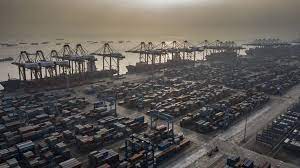

A recent tariff truce between the United States and China has prompted economists to revise their growth forecasts for both nations, with positive ripple effects for the global economy. Both nations had endured a period of heightened trade tensions that led to increased tariffs and uncertainty, but with the easing of these measures, prospects for economic expansion are improving. This shift in economic sentiment is being closely watched by global markets, as it signals a return to more predictable trading conditions.
The truce, hailed by many as a breakthrough in US-China relations, is expected to bolster bilateral trade and consumer confidence, which had been severely impacted by the protracted trade dispute. While challenges remain, especially in areas like intellectual property rights and market access, the resolution of some tariff-related issues is expected to provide a much-needed boost. Global markets, particularly emerging economies, stand to benefit as trade flows stabilize and economic activity picks up.
(NNI / Latest news / Latest news india / India latest news/UPSC Preparation)
Nifty to Consolidate Before Rising to New Heights, According to Manishi Raychaudhuri
Latest News: 16th May 2025
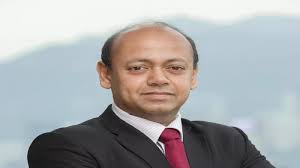

Manishi Raychaudhuri, a prominent market expert, has suggested that the Nifty index may experience a temporary pause before it can reach new all-time highs. While the broader market has shown a strong upward trend, Raychaudhuri believes that a brief consolidation phase is likely as market participants take a breather after the recent rally. This pause could be a natural correction before the index attempts to break past its previous records.
Raychaudhuri's analysis highlights the importance of waiting for stable fundamentals and positive cues to sustain the momentum. Despite the expected pause, he remains optimistic about the long-term outlook for the market, emphasizing that the underlying economic conditions are favorable for continued growth. Investors should be prepared for short-term fluctuations but can remain confident in the broader positive trend that could push the Nifty to new highs in the near future.
(NNI / Latest news / Latest news india / India latest news/UPSC Preparation)
"April Sees Sharp Decline in Wholesale Inflation, Easing to 0.85%"
Latest News: 14th May 2025
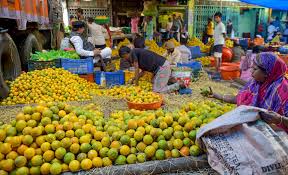

India's wholesale inflation, measured by the Wholesale Price Index (WPI), fell to a 13-month low of 0.85% in April 2025, down from 2.05% in March. This decline was primarily driven by a significant reduction in food and fuel prices. Wholesale food inflation eased to 2.55% from 4.66% in the previous month, with vegetable prices notably falling by 18.26%. Additionally, fuel and power costs decreased by 2.18%, compared to a slight 0.20% rise in March.
Economists anticipate that this downward trend in wholesale inflation could continue in the coming months, offering potential relief to consumers and signaling reduced cost pressures for businesses. The moderation in inflation is expected to provide the Reserve Bank of India (RBI) with room to implement accommodative monetary policies, such as interest rate cuts, to stimulate economic growth.
(NNI / Latest news / Latest news india / India latest news/UPSC Preparation)
RBI’s New Digital Lending Regulations
Latest News: 13th May 2025, UPSC Preparation


The Reserve Bank of India (RBI) introduced comprehensive regulations for digital lending. These guidelines aim to enhance transparency and accountability in the digital lending ecosystem. The new rules require regulated entities to report their digital lending applications through the Centralised Information Management System (CIMS) portal. This initiative is set to encourage trust among borrowers and mitigate unethical practices in digital lending.
New Regulations
The RBI’s new digital lending directions consolidate previous guidelines. They focus on ensuring that digital lending practices are transparent. Regulated entities must report details of their digital lending apps by June 15, 2025. A public directory of these apps will be accessible on the RBI’s website by July 1, 2025.
Key Provisions for Regulated Entities
Regulated entities must conduct enhanced due diligence before partnering with lending service providers (LSPs). This includes assessing the LSP’s technical capabilities and data privacy policies. They must also ensure that loan offers are presented transparently to borrowers. This includes disclosing unmatched lenders in the digital view of loan applications.
Digital View of Loan Offers
The digital view must display all matching loan offers from different lenders. It should include essential details such as loan amount, interest rates, and repayment obligations. This transparency is designed to help borrowers make informed decisions.
Public Directory of Digital Lending Apps
The public directory will list all registered digital lending apps. This will allow borrowers to verify the legitimacy of these platforms. The directory will be updated automatically as regulated entities report new information.
Compliance and Accountability Measures
Chief compliance officers of regulated entities must certify the accuracy of submitted data. They must ensure compliance with all regulatory instructions. Additionally, LSPs are required to appoint grievance redressal officers to address customer complaints.
Importance of Enhanced Transparency
The new regulations aim to build consumer confidence in digital lending. By making loan offers more transparent, borrowers can better evaluate their options. This is expected to reduce the risk of misrepresentation and unethical lending practices.
(NNI / Latest news / Latest news india / India latest news/UPSC Preparation)
Expanded Credit Guarantee Scheme for Startups
Latest News: 13th May 2025, UPSC Preparation


The Government of India has recently expanded the Credit Guarantee Scheme for Startups (CGSS) to enhance financial support for early-stage companies. This initiative aims to facilitate access to debt funding and encourage innovation across various sectors. The Department for Promotion of Industry and Internal Trade (DPIIT) announced changes to the scheme, designed to encourage startups and boost the national economy.
Key Features of the Expanded CGSS
The ceiling on guarantee cover has doubled from ₹10 crore to ₹20 crore per borrower.
The guarantee coverage for loans up to ₹10 crore is now set at 85% of the amount in default.
For loans exceeding ₹10 crore, the coverage is 75%.
These changes are intended to mitigate risks for lenders and stimulate investment in startups.
Reduction in Guarantee Fees
The Annual Guarantee Fee (AGF) for startups in 27 Champion Sectors has been halved from 2% to 1%. This reduction aims to make financing more attractive, particularly in sectors crucial to India’s manufacturing and services landscape, as outlined in the Make in India initiative.
Champion Sectors Under the Scheme
The identified Champion Sectors include both manufacturing and services.
Manufacturing sectors include aerospace and defence, automotive components, pharmaceuticals, biotechnology, chemicals, and electronics.
The services sectors encompass Information Technology, tourism, medical value travel, and audio-visual services. This classification marks the government’s focus on promoting innovation in critical industries.
Impact on Financial Institutions
The expanded scheme is expected to attract more financial institutions to provide credit support to startups. By reducing perceived risks, established lenders are more likely to extend loans. This increased financial flow will support research and development, experimentation, and the creation of innovative technologies.
About CGSS
The CGSS was initially launched in October 2022, following the Startup India initiative, which began in January 2016. The scheme is designed to facilitate collateral-free debt funding for eligible startups through various financial instruments, including working capital and term loans.
Government’s Vision for Startups
The expansion of the CGSS aligns with the government’s broader vision of creating a self-reliant and innovation-driven economy. Prime Minister Narendra Modi’s vision of a “Viksit Bharat” puts stress on the importance of encouraging a robust startup ecosystem that contributes to economic growth and technological advancement.
Operational Reforms
The updated CGSS framework incorporates operational reforms developed in consultation with stakeholders from the startup ecosystem. These reforms aim to enhance the scheme’s appeal to both lenders and startups, ensuring a more effective financial support system.
(NNI / Latest news / Latest news india / India latest news/UPSC Preparation)
"India Proposes Zero Tariffs on U.S. Auto Parts and Steel in Trade Talks"
Latest News: 12th May 2025
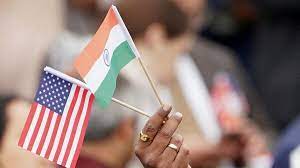

India has proposed a "zero-for-zero" tariff arrangement to the United States, aiming to eliminate import duties on American auto parts and steel in exchange for similar concessions from the U.S. This move is part of broader negotiations to address the U.S.'s threat of reciprocal tariffs, which could impact various sectors, including electronics, pharmaceuticals, and medical devices. The Indian government is working closely with industry stakeholders to identify product categories where tariff reductions can be implemented without adversely affecting domestic industries. The goal is to safeguard sectors such as agriculture while fostering stronger trade ties with the U.S.
The proposed tariff reductions are seen as a strategic effort to mitigate the impact of potential U.S. tariff hikes and to demonstrate India's commitment to fair trade practices. By offering zero duties on specific U.S. imports, India aims to encourage reciprocal actions from the U.S., thereby promoting a more balanced and mutually beneficial trade relationship. These discussions are ongoing, with both nations working towards finalizing the terms of the agreement in the coming months.
(NNI / Latest news / Latest news india / India latest news/UPSC Preparation)
FIMMDA Recognized as Self-Regulatory Organisation
Latest News: 11th May 2025, UPSC Preparation
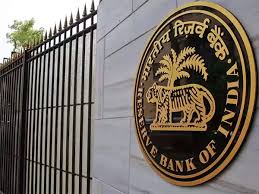

The Reserve Bank of India (RBI) has officially recognised the Fixed Income Money Market and Derivatives Association of India (FIMMDA) as a self-regulatory organisation (SRO). This move aims to enhance supervision in India’s financial markets. FIMMDA, established in 1998, represents various financial institutions. This recognition marks a shift from its previous advisory role to a more authoritative position.
Background of FIMMDA
FIMMDA was founded to represent institutions involved in fixed income, money markets, and derivatives. Its members include banks, insurance companies, and primary dealers. Over the years, it has published benchmark rates and provided standardised documentation. FIMMDA has acted as a hub for industry best practices but lacked regulatory powers.
Changes in Functionality
With the SRO status, FIMMDA gains formal authority to oversee its members. It will establish rules and ensure compliance among its members. FIMMDA can now impose penalties for violations, enhancing market discipline. This transition is expected to improve the effectiveness of financial market regulations. FIMMDA’s grassroots knowledge will help address sector-specific issues.
Governance and Accountability
The new status requires FIMMDA to adhere to high governance standards. It must ensure transparency and avoid conflicts of interest. Members will be treated equitably under its regulations. This shift aims to increase accountability and facilitate quicker decision-making in financial markets.
Regulatory Framework
The RBI’s recognition of FIMMDA aligns with its broader initiative for tighter regulation in financial markets. The central bank introduced a framework for recognising SROs in August 2024. This framework outlines eligibility criteria, responsibilities, and governance standards for SROs. FIMMDA’s compliance with this framework is essential for its operations.
Impact on Financial Markets
FIMMDA’s SRO status is expected to streamline operations within the financial markets. It will enhance the implementation of market discipline under RBI supervision. This recognition aligns India with global standards, where self-regulatory bodies play important role in maintaining market integrity. The industry anticipates minimal disruption but improved efficiency in FIMMDA’s functions.
(NNI / Latest news / Latest news india / India latest news/UPSC Preparation)
RBI Introduces Consultative Framework for New Regulations
Latest News: 09th May 2025,
UPSC Preparation
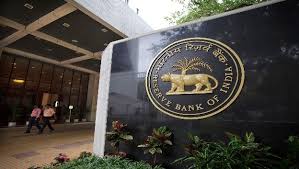

The Reserve Bank of India (RBI) has recently announced a new consultative framework for issuing regulations. This approach aims to enhance transparency and stakeholder engagement. It allows stakeholders 21 days to comment on draft regulations. The RBI will also conduct an impact analysis before finalising any new rules. This initiative reflects the RBI’s commitment to a balanced regulatory environment.
Framework Overview
The RBI’s framework outlines the process for developing new regulations. It mandates the publication of draft regulations on the RBI’s website. Stakeholders can submit comments within 21 days. This process is designed to gather diverse perspectives before finalising regulations.
Impact Analysis
Before finalising any regulation, the RBI will conduct an impact analysis. This analysis assesses the potential effects of the regulation. It aims to evaluate the benefits and costs associated with the proposed rules. The RBI will consider the feasibility of this analysis in each case.
Stakeholder Consultation
The RBI encourages stakeholder consultation as part of its regulatory process. It may issue discussion papers to elicit feedback on key issues. This early engagement helps refine regulations before they are drafted. The RBI aims to ensure that the regulations are relevant and effective.
Periodic Review of Regulations
The framework includes provisions for periodic reviews of existing regulations. The RBI will assess regulations based on their effectiveness and relevance. Factors such as court rulings and international standards will be considered. The goal is to keep regulations up to date and reduce redundancies.
Exceptions to the Framework
Certain regulations are exempt from this framework. These include internal administrative matters and procedural issues. The RBI retains the discretion to modify or dispense with the framework when confidentiality is necessary. This ensures that sensitive matters are handled appropriately.
Commitment to Transparency
The RBI’s new framework reflects its commitment to transparency in the regulatory process. By involving stakeholders, the RBI aims to create regulations that are well-informed and balanced. This approach is expected to encourage trust between the regulator and the public.
Future Implications
The introduction of this consultative framework marks shift in the RBI’s regulatory approach. It acknowledges the importance of public input in shaping effective regulations. This move could set a precedent for other regulatory bodies in India, promoting a culture of transparency and accountability.
(NNI / Latest news / Latest news india / India latest news/UPSC Preparation)
India-UK Free Trade Agreement
Latest News: 08th May 2025, UPSC Preparation


The India-UK Free Trade Agreement (FTA) was finalised in 2025, marking milestone in bilateral relations. This agreement aims to enhance trade and economic cooperation between two major economies. The FTA was a long-anticipated outcome of negotiations that began in 2022 during Boris Johnson’s tenure as Prime Minister. The agreement is expected to stimulate economic activity in both countries and create new opportunities, particularly for Indian businesses and Micro, Small, and Medium Enterprises (MSMEs).
Background of the Agreement
The FTA discussions commenced after Brexit, with the UK seeking to establish new trade partnerships. The urgency for a deal increased due to changing global economic dynamics. The UK has been proactive in negotiating with India, viewing it as a vital trade partner. The agreement was finalised after extensive negotiations that spanned multiple political administrations in the UK.
Key Takeaways from the FTA
Three primary outcomes characterise the FTA. Firstly, it positions the UK ahead of India’s other trade negotiations, notably with the US and the European Union. Secondly, the agreement reflects a bipartisan consensus in the UK regarding the importance of the India-UK relationship. Thirdly, it reinforces the economic pillar of the Comprehensive Strategic Partnership between India and the UK.
Economic Impact
The FTA is expected to enhance bilateral trade . As of late 2024, India and the UK reported a trade volume of £40.9 billion. India is the UK’s 11th largest trading partner, contributing to 2.4% of the UK’s total trade. The FTA aims to increase this figure by facilitating easier access to markets and reducing tariffs.
Future Prospects
The FTA is viewed as a foundation for deeper collaboration across various sectors, including defence, education, and technology. Both countries are committed to strengthening ties, with the Government of India emphasising that the FTA is merely the beginning of a broader partnership. Prime Minister Modi has invited UK Prime Minister Keir Starmer to visit India, signalling intent for ongoing dialogue and cooperation.
Strategic Importance
The FTA holds strategic importance for both nations. It not only enhances economic relations but also serves as a platform for collaboration in defence and security. The agreement is seen as very important in encouraging trust and cooperation in other critical areas, thereby solidifying the Comprehensive Strategic Partnership.
(NNI / Latest news / Latest news india / India latest news/UPSC Preparation)
RBI’s Monetary Policy and Rate Cut Expectations
Latest News: 07th April 2025
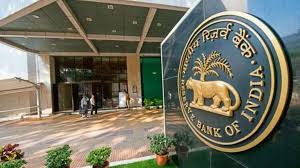

The Reserve Bank of India (RBI) is currently navigating a complex economic landscape. Recent analysis suggests that the RBI’s monetary policy committee (MPC) may not deliver the expected surprises in rate cuts. Historically, the RBI has often surprised the market with larger than anticipated cuts. However, the current environment indicates a more cautious approach.
Historical Context of RBI Rate Cuts
The RBI has a history of surprising the market with its rate cuts.
In 2012, it made an unexpected cut which was later deemed a policy mistake.
In 2015, a surprise inter-meeting cut caught many off guard.
Again in 2019, the new governor initiated a surprise reduction, reversing a hawkish stance.
Each instance had unique circumstances that influenced the decisions.
Current Market Expectations
Nomura India predicts a 25 basis points (bps) cut in the upcoming MPC meeting. The new governor, Sanjay Malhotra, is expected to lead a unanimous vote. The consensus leans towards a cautious approach, with many expecting no drastic changes to the cash reserve ratio (CRR). Some market participants still hold out for a more aggressive stance.
Potential Strategies for Dovish Surprises
There are three primary strategies the RBI could employ to surprise the market:
Larger Rate Cuts: Some expect a 50 bps cut, arguing the RBI has lagged in its response to economic conditions.
Change in Policy Stance: A shift from ‘neutral’ to ‘accommodative’ would signal openness to further cuts, indicating a deeper monetary easing cycle.
Permanent CRR Reduction: A cut in the CRR could inject substantial liquidity into the market, although this is less likely given recent measures.
Economic Conditions and RBI’s Approach
Nomura suggests that the RBI’s focus has shifted towards supporting growth, becoming more tolerant of forex depreciation. The global economic backdrop remains fluid, prompting the RBI to adopt a cautious stance. The bank is likely to continue with open market operations (OMOs) and buy-sell swaps rather than implementing further CRR cuts.
Implications for Future Monetary Policy
The RBI’s decisions will be closely watched as they will impact liquidity and economic growth. While the current consensus expects a measured approach, any unexpected moves could alter market dynamics. The RBI’s historical context and current expectations set the stage for a potentially very important moment in Indian monetary policy.
(NNI / Latest news / Latest news india / India latest news/UPSC Preparation)
Insufficient support for deep tech start-ups in India: study
Latest News: 30th April 2025


The study asked labs to supply data on 62 parameters such as their spend on R&D; around 25% of the participating institutions reported spending between 75% and 100% of their budget on R&D.
Only about one in four public-funded research and development organisations in India gives incubation support to start-ups and only one in six provides support to ‘deep tech’ start-ups. Only 15% collaborated with industry overseas and only half opened their facilities to outside researchers and students, say the findings of a study commissioned by the Office of the Principal Scientific Adviser and executed by the Confederation of Indian Industry (CII) and the Centre for Technology, Innovation, and Economic Research.
The study, via a detailed questionnaire, asked labs to rate themselves and supply data on 62 parameters such as their spend on R&D; the number of young scientists, patents filed, and technologies developed; and participation of women scientists and their contribution to “national missions” such as the Deep Ocean Mission and National Quantum Mission.
Labs of the “strategic sector”, such as those belonging to defence, space, and atomic energy research — all of which constitute the lion’s share of India’s overall Research and Development (R&D) spend — were excluded from the study due to the “sensitive nature of their work”.
The labs studied were those affiliated to the Council of Scientific and Industrial Research, the Department of Science and Technology, the Ministry of Electronics and Information Technology, and so on.
The Union government expenditure on R&D was around ₹55,685 crore in 2020-21, the figure cited in the study and the latest available says. Excluding the expenditure of the strategic departments such as the DRDO (defence), DAE (atomic energy) and DoS (space), the spending by key scientific agencies and other Central government departments was ₹24,587 crore.
Around 25% of the participating institutions reported spending between 75% and 100% of their budget on R&D.
The organisations that reported less than the median share of spending on R&D and S&T (Science and Technology) in the overall budget were largely from ICAR (Agricultural research), CSIR, ICMR (medical research), Ministry of AYUSH (Ayurveda and traditional medicine) and DST (Science and Technology).
Staff strength down
A large number of labs/institutes reported a decrease in the number of permanent staff in 2022-23 compared with the previous year and an increased reliance on contractual staff.
The median share of young researchers increased in 2022-23 to around 58% from 54% in the previous year.
“This is the second time that we have had such an analysis. What we intend is that the data from such a study be closely analysed by institutions so that they can identify areas of improvement,” said Dr. Ajay Sood, Principal Scientific Adviser. “Overall, several research institutes seem to have oriented themselves from being centres of scientific inquiry to innovation centres. I see that as a positive development. Academia and product innovation must go hand in hand.”
As part of its recommendation, the report advocates that every lab should be “mandated to review their existing mandates”.
(NNI / Latest news / Latest news india / India latest news/UPSC Preparation)
India and France finalise agreement for 26 Rafale-Ms
Latest News: 29th April 2025


India and France on Monday formally concluded an Inter-Governmental Agreement (IGA), valued at nearly ₹64,000 crore, to procure 26 Rafale-M fighter jets for the Indian Navy. Deliveries are set to begin from mid-2028 and likely to be completed by 2030.
The IGA was signed by Defence Minister Rajnath Singh and Minister of Armed Forces of France Sebastien Lecornu remotely.
“The deal includes training, simulator, associated equipment, weapons, and performance-based logistics. It also includes additional equipment for the existing Rafale fleet of the Indian Air Force,” a Defence Ministry statement said, adding that the crew will undergo training in France and India. The IGA also includes transfer of technology for the integration of indigenous weapons, such as the Astra Beyond Visual Range air-to-air missile, on the Rafales. “The delivery of these aircraft would be completed by 2030, with the crew undergoing training in France and India,” the Defence Ministry statement said.
Likely to generate jobs
“It also includes the setting up of production facility for Rafale Fuselage as well as Maintenance, Repair and Overhaul (MRO) facilities for aircraft engine, sensors and weapons in India,” the statement said, adding that the deal is expected to generate thousands of jobs and revenue for a large number of Micro, Small, and Medium Enterprises (MSMEs).
The French Defence Minister was scheduled to visit India to sign the deal, but the visit was deferred due to personal reasons. Hence, the signing of the IGA was done by the two Ministers remotely.
The signed copies of the agreement, aircraft package supply protocol, and weapons package supply protocol were exchanged by Indian and French officials in the presence of Defence Secretary Rajesh Kumar Singh at Nausena Bhawan, the Defence Ministry said in a statement. Navy Vice-Chief Vice-Admiral Krishna Swaminathan and French Ambassador in India Thoerry Mathou were also present at the event. In addition to the IGA, several associated Government-to-Business agreements were concluded.
The Indian Navy currently operates two aircraft carriers - the INS Vikramaditya procured from Russia and the indigenously built INS Vikrant commissioned in September 2022.
As per contractual terms, deliveries will begin 37 months from the date of contract and will be completed in 66 months. The deal includes 22 single-seater jets that can operate off aircraft carriers and four twin-seater trainer jets that are not carrier-compatible.
(NNI / Latest news / Latest news india / India latest news/UPSC Preparation)
Are Indian startups not scaling up on innovation?
Latest News: 18th April 2025
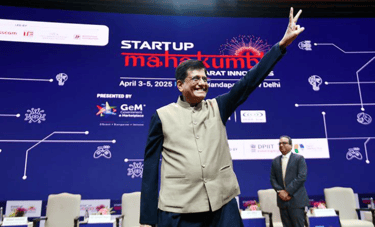

Recently, while speaking at the Startup Mahakumbh in New Delhi, Union Minister of Commerce and Industry Piyush Goyal said that startups were not innovating enough and were limiting themselves to grocery delivery. Are Indian startups not scaling up on innovation? Thillai Rajan and P.K. Jayadevan discuss the question in a conversation moderated by Ashokamithran T. Edited excerpts:
Do you agree with Piyush Goyal’s remarks?
P.K. Jayadevan: I think it has started a debate and the timing of the debate is great. We can disagree on the substance of his statement and a lot of people have taken sides. But I think those add to the discourse and that is a positive sign.
Thillai Rajan: Startups thrive where the ecosystem helps them. Startups are engines of innovation, but are they innovating enough? That means, are they looking at commercialising science and technology-based innovation? If you consider innovation as a spectrum, people always consider science and technology as the highest order of innovation. I’m not saying that is right or wrong; I’m merely stating a fact. From that perspective, data shows that a healthy share of startups qualifies under the deep tech sector. So, there is adequate activity and interest among startups to venture into deep tech sectors.
But the question is, are they scaling up? The capital requirements of the deep tech startups are higher in the initial phase. No revenues come in during that phase, where the level of risk is very high. So, who can provide this amount of capital? The Startup India Seed Fund scheme gives about ₹50 lakh (for activities such as market entry, commercialisation, and scaling up), but that’s not adequate; there has to be follow-up funding. Today, there is realisation that there has to be private sector capital provided after the initial government support.
How do venture capitalists define innovation for the purpose of funding?
PKJ: In the early days, innovation meant just being able to order stuff online. Venture capital firms made large bets on the Indian consumer story and that was the era until 2017. We saw large companies come out of it, such as Flipkart. That was the e-commerce era. Now, we are seeing smaller funds going into deep tech, which are not nearly enough, but you could argue that venture capital is betting on the future. Now, venture capitalists will look at AI, block chain-based innovation, electric mobility, etc.
TR: By innovation, we mean the benefits it will give to users. Are users going to benefit? Are they going to get a new experience from using this product? Will the consumer pay a premium for accessing the products and services? It is to assess the impact that it can create on people. In this regard, there are two points to be made. The first is to ask whether the innovation gives any competitive advantage that can be sustained over a long period of time. For example, a patent gives a competitive advantage. If that is not available, it will not attract investors’ interest because the capital will not get returns. The second could be in terms of the market. It may be a great innovation, but unless it addresses a need in a growing market, there will not be many backers for it. So, these largely determine which innovations get commercialised and which ones do not.
What has been the result of the Startup India push? Has it borne fruit?
TR: The emphasis on a startup policy is possibly the most wide-reaching policy focus of independent India. The facts speak for themselves. First, there are at least 20 Ministries of the Central government which have a dedicated policy or a programme targeted at startups. Second, we can also be proud of the numbers: there are about 1,65,000-1,70,000 startups, if we go by the numbers of the Department for Promotion of Industry and Internal Trade. This indicates that startup policies have been able to encourage many people to start ventures. Third, the capital that has flown in is not only restricted to equity; we are also seeing significant amount of debt capital going into startups. Getting banks to invest in startups is really something. That shows that the startup focus is here to stay and is going to play an integral role in India’s ambition of becoming a developed country. Apart from the Centre, large States too have startup policies.
PKJ: Yeah, absolutely. Everyone wants to start a company these days, which is a huge shift in mindset compared to earlier.
But if you compare India to the U.S., you will find that the U.S. shifted manufacturing to China when it had trouble with Japan. China was where it could find cheaper labour. China saw that as an opportunity to create employment, grow its own market, and also learn from American companies. It built its own telecom networks, micro-satellites, etc. China had a very nationalistic view of technology. Because it’s a closed ecosystem, it always wanted to be more self-reliant with respect to technology. So, the ecosystem matured much faster. China’s consumption economy also grew in a big way. About $12,000-15,000 per capita GDP is really good for a digital economy. We are still around $3,500. We don’t have that kind of money to spend. We have cash-rich companies but they hesitate to invest, which is not the case in other ecosystems. That’s where we are lagging. The India consumption story has to move forward. For that we need some enabling criteria.
Are you speaking about some sort of an import substitution for capital?
PKJ: Not necessarily. If the market is promising, capital will come from anywhere in the world. But yes, there is a need for more Indian home-grown venture capital firms.
What prevents startups from going up the value chain or becoming bigger?
TR: There is a natural selection process that works in the economy. But the issue is whether we should give small amounts to a large number of startups or large amounts to a small number of startups. In India, by and large, the government has been trying to give small amounts to a very large number of companies. Most of the major support that the government has provided has also been used by larger companies. The quantum of support needed has to be substantially higher. The risk capital available is very low and much of it flows from external markets, primarily the U.S. Till we are able to find domestic capital, a good amount of support needs to be provided so that we can find a few winners.
Do you think governments in India have not started taking startups seriously?
TR: No, of course they have. Every sector has been opened up to engage with startups. But the whole process has to be made smoother. There is a lot of bureaucracy, which makes life difficult. In addition to its intentions, if the government has appropriate implementation measures, many startups will find it a lot easier to operate.
India is a very unequal country. The upper middle class in urban areas want quick deliveries, domestic helps, electricians, etc. But the first wave of tech in India saw more broad-based growth. Have startups benefited only a few?
PKJ: The difference with the IT services business was that it was labour-intensive and it worked out at that point in time because of outsourcing. But were we building the foundational products? No. And did we get there? We did. Thanks to venture capital, we had Freshworks, the first Indian software product company to go to the NASDAQ and list. It changed the game. Now there are many startups that were launched by those groomed in Freshworks. Once we have successful startups, founders and others will similarly spread out and build more.
TR: The first wave of entrepreneurship was more unidimensional. Much of it was IT, software. But today, there is an emphasis on all sectors.
For every Aether, there is a Byju’s. What do startups have to do to make sure they become an Aether?
TR: They should continue to be innovative because this is a competitive marketplace. One cannot rest on the laurels of the past.
PKJ: I would say set a very high bar of corporate governance and innovation.
(NNI / Latest news / Latest news india / India latest news/UPSC Preparation)
Retail inflation at its lowest since 2019
Latest News: 16th April 2025
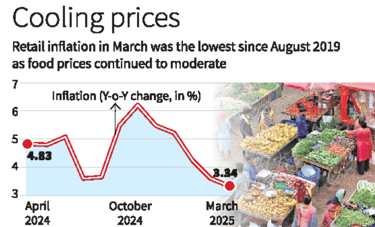

Retail inflation eased to a five-and-a-half-year low of 3.34% in March, from 3.61% in the previous month, mostly due to lower food prices, according to data from the Ministry of Statistics and Programme Implementation. Vegetables, eggs, and pulses were significantly cheaper, though edible oils and fruits continued to see high inflation.
Rural inflation came in at a lower 3.25% in March, down from 3.79% in February, though urban inflation increased marginally from 3.32% in February to 3.43% in March.
Dip in food inflation
Fuel and light inflation increased moderately to 1.48%, with prices rising for the first time since September 2023.
Consumer food price inflation (CFPI) hit a three-year low of 2.7% in March, a sharp drop from 3.75% in the previous month, according to data from the Centre for Monitoring Indian Economy (CMIE).
The slowing prices come on the heels of two consecutive repo rate cuts, each by 25 basis points (bps) or 0.25%, by the Reserve Bank of India indicating that that the central bank is more worried about growth than inflation.
Economists agreed that the inflation is likely to stay under 4% in the coming months, which they said would prompt a 50 bps rate cut. “The softer than expected [Consumer Price Inflation] CPI will provide further comfort to the RBI to continue to prioritise growth. We retain our view that the RBI will continue on its accommodative stance with the terminal repo rate likely around 5% to 5.25%,” said Upasna Bharadwaj, the chief economist at Kotak Mahindra Bank.
Kerala had the highest inflation of 6.6% followed by Chhattisgarh, Maharashtra, Tamil Nadu, Karnataka, Assam, and Haryana which all had inflation of above 3.3%. Inflation was lowest in Delhi and Telangana coming in at 1.5% and 1.1% respectively.
Among major crops, tomato prices plunged almost 35% in March the reporting month, steeper than the 29% deflation in February. Potato prices rose 2.3%, which was the lowest in a little more than a year. The kitchen staple’s price had increased 26% in the previous month. Onion prices increased 19% in March, from 30% in the previous month. Overall, vegetable prices deflated 7% for the second consecutive month. Pulses and products prices deflated 2.7% in March, while egg prices fell over 3%. Rice and wheat prices rose 4.9% and 9% in March, lower than the 5.3% and 9% gains of the previous month.
The CPI data moved in the same direction as the wholesale price inflation data, which was released on the same day by the Commerce Ministry. Wholesale prices eased 2.05% in March, from2.38% in February. Primary articles prices increased at a modest 0.76% in March, down from 2.8% in the previous month. Fuel and power prices increased 0.2 % from a deflation of 0.7% in February 2025. Prices of manufactured goods too increased 3.07% in March, from 2.86% in the previous month. The WPI food index increased at a slower pace of 4.66% in March 2025 from 5.9% in the previous month.
Vivek Rathi, the national director of research at Knight Frank India, said that excluding the food and fuel basket, inflationary pressures persist among households, potentially tightening consumption expenditure, especially for lower-income households that are more sensitive to price increases.
(NNI / Latest news / Latest news india / India latest news/UPSC Preparation)
"India's GDP Growth Slows: Government Points to Central Bank Actions"
Latest News: 28th December 2024

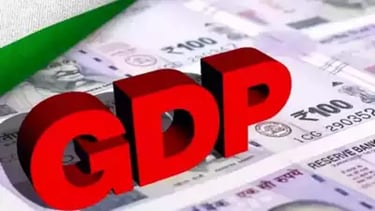
The Indian government has attributed the recent economic slowdown to the Reserve Bank of India's (RBI) monetary policy stance. In its December 2024 economic review, the Ministry of Finance highlighted that the central bank's tight monetary policies and macroprudential measures may have dampened demand and contributed to slower growth in the first half of the 2024-25 fiscal year.
India's GDP growth rate fell to 5.4% in the July-September quarter, the lowest in seven quarters, down from 6.7% in the previous quarter. The slowdown comes amid global economic uncertainties, persistent inflation, and rising borrowing costs due to the RBI’s stance to combat inflation.
The Finance Ministry pointed to the elevated interest rates and liquidity-tightening measures as factors limiting credit growth and reducing consumer spending. However, it acknowledged the central bank's efforts to address inflation and macroeconomic stability, emphasizing the need for a balance between inflation control and fostering economic growth.
To address liquidity concerns, the RBI recently reduced the cash reserve ratio (CRR) from 4.5% to 4%, which is expected to inject additional liquidity into the banking system. This, coupled with government spending in key sectors, is anticipated to revitalize economic activity in the second half of the fiscal year.
The government projects an economic growth rate of around 6.5% for the fiscal year 2024-25 but cautioned that challenges remain, including external pressures and domestic structural issues. Economists and analysts believe that policy coordination between the government and RBI will be critical in steering India back toward its growth trajectory.
(NNI / Latest news / Latest news india / India latest news/UPSC Preparation)
India’s Forex Reserves Witness Largest Weekly Drop in Months, Says RBI
Latest News: 27th December 2024


India’s foreign exchange reserves have witnessed a significant dip of $8.4 billion, standing at $644.3 billion for the week ending December 22, according to the Reserve Bank of India (RBI). This sharp decline comes after months of relative stability and highlights the country’s vulnerability to global financial market fluctuations and domestic economic pressures.
Factors Behind the Decline
Currency Valuation Changes: A significant portion of the decline is attributed to the depreciation of non-dollar currencies held in the reserves, such as the euro, pound, and yen, against the US dollar.
Outflows and Trade Deficit: Rising trade deficits due to increased imports and volatile foreign portfolio investments have also contributed to the decrease.
Global Interest Rates: The Federal Reserve’s hawkish stance on interest rates has strengthened the US dollar, causing outflows from emerging markets like India.
Implications
Rupee Volatility: The dip in reserves puts pressure on the Indian rupee, potentially leading to further depreciation.
Policy Measures: The RBI may need to step up interventions in the forex market to stabilize currency fluctuations.
Economic Outlook: Lower reserves could affect India’s ability to absorb external shocks, making it more vulnerable to global economic uncertainties.
Outlook
While the current reserves still remain robust, ranking among the highest globally, the trend underscores the need for cautious fiscal and monetary policies to maintain economic stability.
(NNI / Latest news / Latest news india / India latest news/UPSC Preparation)
North East Bankers Conclave 2024
Latest News: 26th December 2024, UPSC Preparation
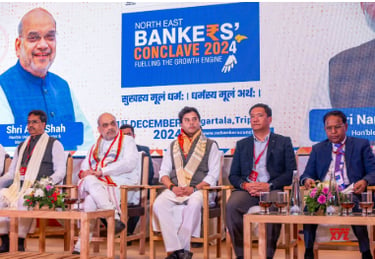

Union Home Minister Amit Shah addressed the North East Bankers Conclave 2024 in Agartala, Tripura, which aimed to encourage financial institutions to invest in the region’s development.
Importance of Economic Inclusion
Amit Shah told the necessity of economic growth across all regions and emphasized that the development of the Northeast is a national responsibility, urging bankers to view it as a vital opportunity for growth rather than a mere business venture.
Future Prospects for the Northeast
Shah expressed confidence in the Northeast becoming a key player in India’s overall development. He credited Prime Minister Narendra Modi for initiatives aimed at transforming the region into a gateway for economic progress. He called for enhanced financial inclusion and targeted investments in infrastructure, agriculture, and small businesses.
Infrastructure Improvements
Significant advancements in connectivity and trade have been achieved in the Northeast. The exchange of enclaves with Bangladesh has opened new trade routes through the Chittagong port. This development has notably reduced transportation costs for goods produced in the Northeast.
Banking Sector Successes
Shah brought into light recent achievements in India’s banking sector, including improved recovery rates of bad debts. He noted that public sector bank mergers have resulted in increased profitability. The Northeast is projected to experience a remarkable growth rate of 20% over the next decade, making it an attractive destination for investment.
Technological Advancements
The implementation of the Unified Payments Interface (UPI) has positively impacted the region. Many villages now enjoy 3G and 4G connectivity, facilitating digital transactions. Shah pointed out the vast potential for hydropower in the Northeast, which could provide affordable electricity to the nation.
Shah urged bankers to explore and invest in the Northeast’s potential. He encouraged them to contribute towards building a developed Northeast, which would, in turn, support the vision of a developed India.
(NNI / Latest news / Latest news india / India latest news/UPSC Preparation)
After Hitting Record Low, Rupee Regains Stability Against US Dollar
Latest News: 25th December 2024


The Indian Rupee showed signs of recovery on Monday, halting its slide after hitting a record low against the US Dollar in the previous trading session. Buoyed by easing crude oil prices and a slight pullback in the US Dollar Index, the currency managed to stabilize at 83.20 per dollar, offering some respite to investors and policymakers alike.
The recent depreciation of the Rupee has been attributed to a combination of global and domestic factors, including rising interest rates in the US, geopolitical tensions, and persistent foreign fund outflows. Experts believe that while the temporary stabilization offers hope, the currency may remain under pressure due to the Federal Reserve's hawkish stance and uncertainties in the global economy.
The Reserve Bank of India (RBI) has been actively intervening in the forex market to prevent excessive volatility, deploying its foreign exchange reserves to stabilize the currency. Analysts suggest that maintaining a balance between forex reserve utilization and managing inflation will be critical for the central bank.
Despite the recent slump, economic experts have highlighted the resilience of India’s economy, supported by robust domestic demand and strong growth prospects. While exporters may benefit from a weaker Rupee, import-dependent sectors like energy and electronics could face cost pressures if the currency's depreciation trend resumes.
Market participants are keeping a close watch on key economic indicators, such as inflation data and global oil prices, as these will play a crucial role in determining the Rupee's trajectory in the coming weeks.
(NNI / Latest news / Latest news india / India latest news/UPSC Preparation)
3rd India-UK Financial Markets Dialogue
Latest News: 16th December 2024, UPSC Preparation
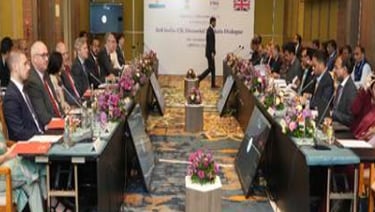

enior officials from India’s Ministry of Finance and the UK’s HM Treasury convened to discuss financial cooperation. This dialogue involved key regulatory bodies, including the Reserve Bank of India (RBI), the Securities and Exchange Board of India (SEBI), and the Bank of England (BoE).
Context and Developments
The dialogue began by reviewing progress since the last meeting in April 2023. Both nations presented their upcoming strategies for financial sector development. They agreed to collaborate to leverage new opportunities.
Discussions focused on ongoing reforms in both countries. The emphasis was on enhancing financial regulation to promote trade and investment. Both sides shared insights on improving capital markets.
Cross-Border Investment
The dialogue included strategies for increasing cross-border investments. India proposed allowing its companies to list directly in London and other foreign markets. This initiative aims to facilitate easier access to international capital.
India updated participants on reforms in its insurance sector. The UK discussed regulatory changes, including Solvency II. Both sides acknowledged the potential for reinsurance and welcomed UK investments in Indian insurance.
Pension Schemes and Reforms
Both nations shared updates on pension reforms. The UK introduced changes to its pension schemes, while India focused on boosting workplace pension participation. They agreed to explore collaborative efforts to enhance growth in this sector.
Innovation emerged as a critical theme, particularly in Fintech and financial data. Both countries scheduled the next Fintech Joint Working Group meeting for early 2025. They discussed the G20 payments roadmap and regulatory sandbox collaboration.
Sustainable Finance Initiatives
Sustainable finance was brought into light as essential for transitioning to a low-carbon economy. The UK shared recent reforms, while India announced plans for a climate finance taxonomy. Discussions included green bond issuances and future sustainable finance efforts.
The dialogue concluded with updates on India’s International Financial Services Centre in GIFT City. Both countries recognised the importance of continued cooperation to enhance financial services and commercial opportunities.
(NNI / Latest news / Latest news india / India latest news/UPSC Preparation)
Interest Rates Likely Unchanged as RBI Tackles Liquidity Challenges
Latest News: 05th December 2024,


The Reserve Bank of India (RBI) began its three-day Monetary Policy Committee (MPC) meeting on December 4, 2024, with expectations centered on maintaining the current interest rates while potentially addressing liquidity concerns through a cut in the Cash Reserve Ratio (CRR). This meeting holds significant implications for India's economic trajectory, balancing sluggish GDP growth and persistent inflation.
Key Economic Context:
Growth Concerns: India's GDP growth for Q2 FY25 fell to 5.4%, its lowest in seven quarters, driven by weak manufacturing, private consumption, and investment. However, rural demand and government spending are expected to stabilize growth in the second half of the fiscal year.
Inflationary Pressures: Consumer inflation remains above the RBI's comfort zone at 6.2%, with food inflation contributing significantly. The central bank is cautious about reducing interest rates prematurely, prioritizing price stability.
Possible Policy Decisions:
Interest Rates: Experts predict the repo rate will remain unchanged at 6.5% as the RBI adopts a cautious approach amidst inflationary concerns and global economic volatility.
CRR Cut: A CRR reduction appears likely to address liquidity shortfalls in the banking sector, potentially injecting funds to bolster credit growth. This measure is seen as a middle ground to support the economy without exacerbating inflation.
The RBI’s policy announcement on December 6 is expected to signal its priorities for 2024, balancing short-term economic needs with long-term stability.
(NNI / Latest news / Latest news india / India latest news/UPSC Preparation)
Indian Rupee Shows Signs of Strength, Gains 3 Paise Against US Dollar
Latest News: 04th December 2024,
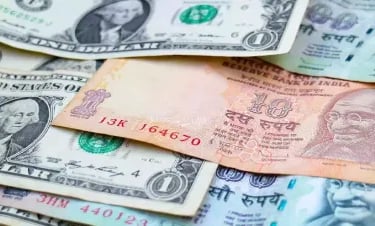

The Indian Rupee showed a slight recovery on December 4, 2024, climbing by 3 paise to 84.69 against the US dollar. This improvement came after the rupee hit an all-time low earlier in the week at 84.70, amidst a volatile market environment. Experts attribute the recent fluctuations to various global economic pressures, including foreign institutional investor (FII) outflows and the ongoing global economic slowdown. While the rupee's recovery is marginal, analysts suggest it may stabilize further if India continues to attract investment and manage its macroeconomic policies effectively.
(NNI / Latest news / Latest news india / India latest news/UPSC Preparation)
"India’s $2 Billion Contribution Reinforces Commitment to BRICS Bank Development"
Latest News: 03rd December 2024,
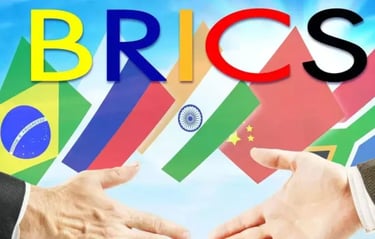

India has contributed $2 billion to the BRICS New Development Bank (NDB), marking a significant commitment to fostering development across the emerging economies of the BRICS bloc. The Finance Ministry confirmed this contribution, underscoring India’s role as a key member of the bank. This contribution is part of India’s broader $10 billion pledge to the NDB, made during its founding in 2014, aimed at promoting infrastructure, sustainable development, and poverty reduction within the member nations.
The NDB has funded numerous projects in areas like renewable energy, urban infrastructure, and transportation in BRICS countries, with India itself being a major beneficiary. This contribution strengthens India's position within the NDB, ensuring continued influence over strategic decisions and aligning with its development goals. India's financial input not only boosts the bank's capital but also enhances its ability to fund large-scale infrastructure projects across developing nations.
This contribution reflects India's deepening involvement in multilateral financial frameworks, which are pivotal to enhancing the country’s standing on the global stage. The BRICS Bank has become a crucial platform for funding sustainable development projects, with India playing an active role in shaping the future of emerging economies.
(NNI / Latest news / Latest news india / India latest news/UPSC Preparation)
India's GST Revenue Grows by 8.5% to ₹1.82 Lakh Crore in November
Latest News: 02nd December 2024,


India's Goods and Services Tax (GST) collection for November 2024 saw a notable rise of 8.5%, totaling ₹1.82 lakh crore. This growth is attributed to increased consumer spending during the festive season, which spurred sales across various sectors. The central GST contributed ₹34,141 crore, while state GST amounted to ₹43,047 crore. Additionally, Integrated GST (IGST) reached ₹91,828 crore, and cess collections stood at ₹13,253 crore. Notably, GST revenues from domestic transactions grew by 9.4%, while tax receipts from imports increased by 6%.
This marks the ninth consecutive month that GST collections have surpassed ₹1.7 lakh crore, reflecting robust economic activity despite a slight month-on-month dip of 2.7% from October's peak.
(NNI / Latest news / Latest news india / India latest news/UPSC Preparation)
"Indian Bank Credit Growth Decelerates to 12.8% as October Figures Fall Short"
Latest News: 01st December 2024


In October 2024, the growth in bank credit slowed down to 12.8% compared to the same period last year, with non-food credit of commercial banks reaching Rs 167.54 lakh crore, up from Rs 148.52 lakh crore in October 2023. This marked a deceleration from the higher growth rate recorded earlier in the year.
This slowdown in credit growth reflects tightening liquidity conditions and the impact of high inflation rates. While credit to key sectors like personal loans and housing has shown robust growth, the pace of increase has moderated in the face of rising interest rates and global economic challenges.
(NNI / Latest news / Latest news india / India latest news/UPSC Preparation)
India’s Foreign Exchange Reserves 2024 – Update
Latest News: 24th November 2024, UPSC Preparation


India’s foreign exchange reserves are crucial for economic stability. On November 15, they stood at $657.89 billion which includes $65.75 billion in gold. The reserves had previously reached $675.65 billion on November 8. A decline of $17.7 billion occurred due to the Reserve Bank of India (RBI) selling dollars to stabilize the rupee.
Special Drawing Rights (SDR)
The SDR portion of India’s reserves is $18.06 billion. SDRs are international reserve assets created by the International Monetary Fund (IMF). They provide liquidity to the global economy. SDRs can be exchanged among member countries.
This financial year, India’s reserves have increased by $11.5 billion. In September, reserves peaked at $704.885 billion. This was a record high. India ranks fourth globally in foreign exchange reserves, following China, Japan, and Switzerland.
Role of the Reserve Bank of India (RBI)
The RBI manages the foreign exchange reserves, which intervenes to manage the rupee’s value. When foreign investors withdraw funds, the RBI sells dollars to prevent a sharp decline. This stabilisation is essential for economic confidence.
Foreign exchange reserves are vital for economic health. They provide a buffer against external shocks. High reserves enhance investor confidence. They also ensure that the country can meet its international payment obligations.
Important Facts for Exams:
Special Drawing Rights (SDR): SDRs are international reserve assets created by the IMF. They provide liquidity to the global economy and can be exchanged among member countries for currencies.
Foreign Exchange Reserves: Foreign exchange reserves are crucial for economic stability. They provide a buffer against external shocks and enhance investor confidence in a country’s economy.
Reserve Bank of India (RBI): The RBI manages India’s foreign exchange reserves. It intervenes to stabilise the rupee when foreign investors withdraw funds, ensuring economic confidence and stability.
(NNI / Latest news / Latest news india / India latest news/UPSC Preparation)
India’s Forex Reserves Slip to USD 675.653 Billion Amid Global Currency Volatility
Latest News: 18th November 2024


New Delhi, November 18, 2024: India’s foreign exchange reserves have witnessed a significant decline, falling by USD 6.477 billion to USD 675.653 billion, according to the latest data released by the Reserve Bank of India (RBI). The drop in reserves is being attributed to several factors, including a reduction in the country's gold reserves and the central bank's efforts to stabilize the rupee in the foreign exchange market.
As of the week ending November 10, 2024, India’s foreign exchange reserves stood at USD 675.653 billion, a decrease from the previous week’s total of USD 682.130 billion. This represents one of the largest weekly declines in recent months, with experts pointing out that the decrease in reserves has been driven by a combination of factors, including global market dynamics and RBI's interventions in the currency markets to support the Indian rupee.
The RBI, which is responsible for managing India’s forex reserves, has been closely monitoring the fluctuating global economic conditions, especially the strength of the US dollar, which has a significant impact on the rupee. The drop in the foreign exchange reserves comes at a time when global inflationary pressures and rising interest rates in major economies are contributing to greater volatility in currency markets worldwide.
The reserves have seen a steady decline in recent weeks as the RBI has been using its foreign exchange reserves to prevent the rupee from depreciating sharply. According to economists, the central bank’s interventions are necessary to keep the currency stable, but they also lead to a reduction in the country’s forex kitty.
The latest data shows that India’s foreign currency assets, which are the largest component of the reserves, declined by USD 6.363 billion, standing at USD 620.140 billion. Similarly, the country’s gold reserves fell by USD 84 million to USD 41.558 billion, while Special Drawing Rights (SDRs) with the International Monetary Fund (IMF) increased marginally by USD 8 million to USD 18.745 billion. India’s reserve position with the IMF also increased by USD 4 million to USD 3.209 billion.
Despite the drop, India’s foreign exchange reserves remain substantial, offering a significant buffer against external shocks and helping to ensure economic stability. Analysts, however, are closely watching how the situation evolves, particularly with the global economic outlook still uncertain.
India’s forex reserves had crossed the USD 640 billion mark earlier this year, but the recent declines are a reminder of the challenges posed by global financial market volatility and the pressure on emerging market currencies. Nevertheless, experts argue that India’s forex reserves are still more than adequate to meet the country’s import needs and external obligations.
In the coming weeks, analysts expect the RBI to continue its efforts to manage the rupee while keeping an eye on global developments, including the US Federal Reserve’s monetary policy decisions and geopolitical tensions that could further impact the stability of the foreign exchange market.
(NNI / Latest news / Latest news india / India latest news/UPSC Preparation)
India and China to Shape Future World Economy
Latest News: 17th November 2024, UPSC Preparation
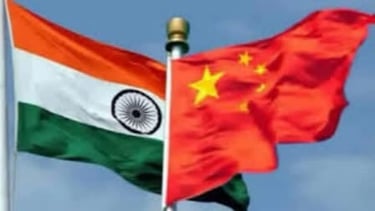

Recent discussions highlight the importance of India and China in the Southeast Asian economic landscape. Singapore’s Senior Minister of State for Foreign Affairs, Sim Ann, emphasized their roles at a launch event for a new series of workshops. This initiative aims to explore the influence of these two nations on the global economy.
Significance of India and China
India and China are the world’s first and third-largest economies based on purchasing power parity, which account for 35% of the global population. Their economic growth is projected to contribute 50% to global growth in 2024. This makes them crucial players in shaping international economic policies.
The Workshop Series
The East Asian Institute (EAI) and the Institute of South Asian Studies (ISAS) at the National University of Singapore (NUS) will conduct a series of workshops. These events will focus on the growth strategies of China and India. They aim to bring together academics, policymakers, and business leaders to discuss the broader implications of their economic policies.
Leading experts have been invited to share their insights. Dr Li Li from Tsinghua University and Professor C Raja Mohan from ISAS are among the speakers. They will address how the economic trajectories of India and China influence global trade and innovation.
Global Economic Landscape
EAI Director Alfred Schipke stated that China and India are very important pillars in the global economy. Their combined potential is expected to drive important economic growth in the coming years. The influence of these nations extends beyond their borders, impacting global policies and challenges.
Future Trends in Digitalisation and Green Economy
Both India and China are essential for the future of digitalisation and the transition to a green economy. ISAS Director Iqbal Singh Sevea brought into light the evolving global order. About the impact of these two countries on global trends is vital for future economic strategies.
Engagement with India and China is essential for Southeast Asia. Their economic strategies will shape the region’s growth and development. Continuous collaboration and dialogue are necessary to navigate the complexities of the global economy.
Important Facts for Exams:
EAI: The East Asian Institute focuses on research and policy analysis in the context of East Asia. It promotes understanding of regional issues through workshops and events.
ISAS: The Institute of South Asian Studies studies South Asian affairs. It aims to enhance knowledge and understanding of the region’s dynamics and its global implications.
NUS: The National University of Singapore is a leading global university. It is known for its research excellence and diverse academic programmes across various disciplines.
PPP: Purchasing Power Parity is an economic theory. It compares different countries’ currencies through a basket of goods approach to determine relative value.
(NNI / Latest news / Latest news india / India latest news/UPSC Preparation)
"Sensex Dips by 1,400 Points, Nifty Tumbles as Inflation, Global Worries Weigh"
Latest News: 05th November 2024
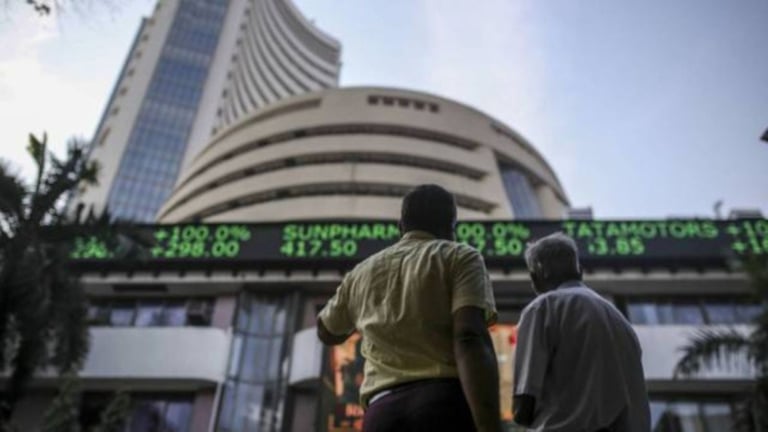

Indian stock markets experienced a sharp downturn today, with the BSE Sensex falling by more than 1,400 points, dipping below the crucial 79,000-mark. The widespread selling pressure was attributed to a combination of factors, including global market uncertainties, weak domestic economic data, and concerns over rising inflationary pressures.
The Sensex, which opened the day on a weak note, saw its biggest drop in months as major sectors including banking, technology, and energy faced heavy sell-offs. The Nifty50 also mirrored the downtrend, shedding over 400 points and falling below the 18,700-level.
Reasons Behind the Decline:
Global Market Weakness: Global markets have been in turmoil, with investors reacting to a series of negative economic reports from major economies, including the United States and China. The global recession fears, coupled with rising bond yields, have created an air of uncertainty that is impacting investor sentiment worldwide.
Inflation Concerns: Domestic inflation, especially food and fuel prices, continues to be a major worry for the Indian economy. Rising inflation has put pressure on the Reserve Bank of India (RBI) to consider tightening monetary policies, which could hurt market liquidity and slow economic growth.
Corporate Earnings Disappointments: While some sectors showed growth, corporate earnings for the second quarter of FY24 have been underwhelming, with several companies reporting disappointing results. The lack of strong corporate earnings further dampened investor sentiment.
Foreign Institutional Investors (FII) Outflow: A significant outflow of funds by foreign institutional investors has been observed in recent weeks. This, along with rising interest rates in developed countries, has led to a reduction in foreign investments in Indian equities.
Sectoral Impact:
Banking & Financials: The banking sector saw the largest losses, with major lenders such as HDFC Bank, ICICI Bank, and State Bank of India (SBI) losing significant ground. Investors are worried about the impact of a potential rate hike on loan growth and credit demand.
IT Stocks: The IT sector, which had been a strong performer for several years, came under selling pressure as concerns about global demand for tech services, along with the strengthening US dollar, weighed on the stock prices of top players like Infosys, TCS, and Wipro.
Energy & Metals: The energy and metals sectors were not immune to the market’s broad-based sell-off, with oil prices and commodity prices remaining volatile, contributing to the negative sentiment.
Market Analysts’ Viewpoint:
Analysts are cautioning that while the market’s near-term outlook appears bleak, this could also be a good opportunity for long-term investors to enter the market at discounted prices. "The market is facing a short-term correction due to a mix of global and domestic factors. However, the fundamentals of the Indian economy remain strong, and we expect the markets to recover in the medium to long term," said Anil Kumar, Senior Equity Analyst at HDFC Securities.
What’s Next for the Markets?
Investors are closely monitoring the upcoming monetary policy meeting of the RBI, where any hint of tightening measures could further unsettle the markets. Market watchers are also keeping an eye on the upcoming earnings results and any fresh developments on the global economic front that could influence sentiment.
Investor Sentiment:
Despite the sharp correction, retail investors are advised to remain cautious and not panic. Many analysts believe the current market downturn could be a result of overreaction and that opportunities may arise in quality stocks once the dust settles.
The volatility in the market is expected to continue, with global and domestic factors continuing to drive market behavior in the coming weeks. As the Sensex sits below 79,000, market participants are waiting for signs of stability and possible signs of a rebound.
(NNI / Latest news / Latest news india / India latest news/UPSC Preparation)
Top Countries in AI Preparedness Index
2023-24
Latest News: 04th November 2024, UPSC Preparation


Artificiall Intelligence(AI) is reshaping the global economy. It is reinventing labor markets, industries, and societal dynamics. This transformation brings both opportunities and challenges. The global AI market is expected to grow, with a compound annual growth rate (CAGR) of 36.6% from 2024 to 2030. Advanced economies will experience these changes sooner than emerging markets due to their focus on cognitive-intensive roles.
AI Preparedness Index (AIPI)
The AI Preparedness Index (AIPI) measures a country’s readiness to adopt AI technologies. The index considers four key metrics:
Digital infrastructure
Human capital
Technological innovation
Legal frameworks
The International Monetary Fund (IMF) released the AI Preparedness Index for 2023, ranking countries based on these criteria.
Top Countries Most Prepared for AI
According to the IMF, the top 10 countries most prepared for AI in 2023 are:
Singapore – Score: 0.80
United States
United Kingdom
Germany
France
Canada
Australia
Sweden
Netherlands
Finland
Singapore leads with the highest score, having invested heavily in AI capabilities. It also has the fastest workers in adopting AI skills, according to LinkedIn.
India’s Position in AI Preparedness
India ranks 72nd out of 174 countries, with an AI Preparedness Index rating of 0.49. Despite this lower ranking has the highest percentage of AI users. About 45% of respondents reported using ChatGPT. The country is home to 338 AI startups, indicating a growing interest in AI technologies.
Comparison with Other Emerging Markets
In comparison to India, other emerging markets like Bangladesh and Sri Lanka rank lower. Bangladesh has a score of 0.38 and is ranked 113th. Sri Lanka has a score of 0.43, placing it at 92nd. China, while an emerging market, has a better ranking of 31st with a score of 0.63.
Consumer Awareness of AI
Consumer awareness of AI tools varies globally. In India and the United Arab Emirates, over 90% of consumers are familiar with ChatGPT. Awareness in China and Saudi Arabia exceeds 80%. This high level of awareness indicates a strong interest in AI technologies among consumers in these regions.
Challenges for Advanced Economies
Advanced economies must enhance regulatory frameworks to manage AI’s impact. They need to facilitate labor reallocation to mitigate job displacement. Protecting those negatively affected by AI adoption is crucial.
Focus on Emerging Economies
Emerging markets should prioritize building robust digital infrastructure. They must encourage digital skills development to prepare their workforce for AI integration. This focus will help them leverage AI’s benefits in the future.
AI is transforming economies worldwide. The AI Preparedness Index marks the varying levels of readiness among countries. As AI continues to evolve, understanding these dynamics is essential for effective adaptation and growth.
(NNI / Latest news / Latest news india / India latest news/UPSC Preparation)
"Economic Strain: Weak Corporate Profit Growth Likely in Next Earnings Cycle"
Latest News: 24th October 2024


Initial trends suggest that corporate profit growth is likely to remain weak in the second quarter of the fiscal year, raising concerns among investors and analysts. Early reports indicate that many companies are facing challenges such as rising input costs, labor shortages, and ongoing supply chain disruptions, which are expected to impact their earnings.
Analysts project that sectors such as manufacturing and retail may experience slower profit growth compared to previous quarters. Key companies in these industries have reported lower-than-expected sales figures, further contributing to the cautious outlook. In particular, businesses that heavily rely on consumer spending are bracing for a challenging quarter as inflation continues to affect purchasing power.
While some sectors, such as technology and pharmaceuticals, may still report robust earnings, the overall corporate landscape appears to be under pressure. Market experts are advising investors to closely monitor earnings reports as they come in, as they will provide a clearer picture of the economic climate and potential recovery.
The anticipated weak profit growth may lead to increased volatility in the stock market, as investors reassess their positions and expectations. Analysts suggest that companies may need to implement cost-cutting measures or explore new strategies to maintain profitability in this challenging environment.
As the second quarter progresses, businesses and stakeholders will be keenly observing market trends to navigate the uncertain economic landscape.
(NNI / Latest news / Latest news india / India latest news/UPSC Preparation)
“Economic Recovery at Stake: RBI Governor Highlights Inflation Risks”
Latest News: 24th October 2024
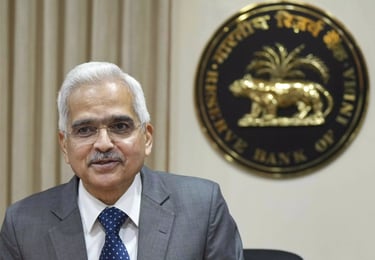

In a recent address, Reserve Bank of India (RBI) Governor Shaktikanta Das emphasized the critical need to maintain monetary stability as the country navigates economic recovery post-pandemic. With inflationary pressures still a concern, Das underscored the RBI's commitment to preventing another surge in inflation that could jeopardize the progress made in the economy.
Key Highlights
Inflation Concerns: Das noted that inflation has been a persistent issue, influenced by various factors including supply chain disruptions, global commodity prices, and domestic demand. He stressed that any resurgence in inflation could undermine consumer confidence and economic growth.
Monetary Policy Strategy: The RBI is closely monitoring inflation indicators and has implemented measures to ensure price stability. Das affirmed that the central bank will not hesitate to adjust interest rates if necessary to keep inflation in check.
Economic Recovery: While the Indian economy shows signs of recovery, Das warned that sustainable growth is contingent upon controlling inflation. He highlighted the importance of balancing growth and price stability to foster a conducive environment for investment and consumption.
Global Economic Landscape: The RBI Governor acknowledged the challenges posed by global economic conditions, including geopolitical tensions and fluctuations in oil prices. He urged stakeholders to remain vigilant and adaptive to these external factors.
Looking Ahead: Das concluded by reiterating the RBI’s commitment to its dual mandate of promoting economic growth while ensuring price stability. He called for collective efforts from policymakers, businesses, and consumers to navigate the challenges ahead.
Conclusion
Shaktikanta Das’s remarks serve as a reminder of the delicate balance required in economic management. With inflation remaining a critical concern, the RBI's proactive measures will be essential in steering the economy toward a stable and prosperous future.
(NNI / Latest news / Latest news india / India latest news/UPSC Preparation)
“Geopolitical Instability in West Asia Poses Challenges for India’s Economic Aspirations”
Latest News: 23rd October 2024


In a recent article published by the Reserve Bank of India (RBI), the central bank has emphasized a positive growth outlook for India, attributing this optimism to robust domestic economic engines. The RBI's assessment comes amid global economic uncertainties, highlighting the resilience and potential of the Indian economy.
Key Highlights from the RBI Article
Domestic Demand Resilience: The RBI pointed out that strong domestic demand is a significant driver of growth. Increased consumer spending, fueled by a recovering job market and rising incomes, has bolstered economic activity across various sectors.
Investment Surge: The article noted a surge in both public and private investments. Government initiatives aimed at infrastructure development and manufacturing have led to increased capital expenditure, which is expected to create jobs and stimulate further economic growth.
Exports and Trade Recovery: Despite global challenges, India’s export sector has shown signs of recovery. The RBI mentioned that strategic partnerships and diversification of trade markets have helped Indian exporters navigate through turbulent international waters.
Inflation Management: The RBI also addressed concerns about inflation, stating that effective monetary policy measures have helped keep inflation under control, thereby fostering a stable economic environment conducive to growth.
Future Projections: Looking ahead, the RBI remains optimistic about India’s growth trajectory, projecting a GDP growth rate of [insert projected percentage] for the upcoming fiscal year. The emphasis on sustainable development and digital transformation is expected to further enhance economic resilience.
Conclusion
The RBI's article reinforces the notion that India's economic fundamentals are strong, driven by a combination of domestic demand, investment, and effective policy measures. As the global economy faces uncertainty, India’s growth outlook appears promising, supported by its robust domestic engines.
(NNI / Latest news / Latest news india / India latest news/UPSC Preparation)
“RBI Projects Strong GDP Growth for India, Citing Investment and Consumer Spending”
Latest News: 22nd October 2024
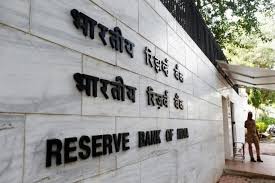

In a recent article published by the Reserve Bank of India (RBI), the central bank has emphasized a positive growth outlook for India, attributing this optimism to robust domestic economic engines. The RBI's assessment comes amid global economic uncertainties, highlighting the resilience and potential of the Indian economy.
Key Highlights from the RBI Article
Domestic Demand Resilience: The RBI pointed out that strong domestic demand is a significant driver of growth. Increased consumer spending, fueled by a recovering job market and rising incomes, has bolstered economic activity across various sectors.
Investment Surge: The article noted a surge in both public and private investments. Government initiatives aimed at infrastructure development and manufacturing have led to increased capital expenditure, which is expected to create jobs and stimulate further economic growth.
Exports and Trade Recovery: Despite global challenges, India’s export sector has shown signs of recovery. The RBI mentioned that strategic partnerships and diversification of trade markets have helped Indian exporters navigate through turbulent international waters.
Inflation Management: The RBI also addressed concerns about inflation, stating that effective monetary policy measures have helped keep inflation under control, thereby fostering a stable economic environment conducive to growth.
Future Projections: Looking ahead, the RBI remains optimistic about India’s growth trajectory, projecting a GDP growth rate of [insert projected percentage] for the upcoming fiscal year. The emphasis on sustainable development and digital transformation is expected to further enhance economic resilience.
Conclusion
The RBI's article reinforces the notion that India's economic fundamentals are strong, driven by a combination of domestic demand, investment, and effective policy measures. As the global economy faces uncertainty, India’s growth outlook appears promising, supported by its robust domestic engines.
(NNI / Latest news / Latest news india / India latest news/UPSC Preparation)
"Festive Season Boosts Gold Demand: Prices Continue to Climb"
Latest News: 18th October 2024


Gold prices have continued their upward trajectory, reflecting heightened demand as the festive season approaches in India. As of the price of gold has reached around 80k per gram, marking a significant increase from previous weeks. Analysts attribute this surge to a combination of traditional buying patterns and a robust recovery in consumer sentiment.
The festive season, particularly with Diwali around the corner, is historically a period of increased gold purchases in India. Families often invest in gold jewelry and ornaments as part of their celebrations and as a symbol of wealth and prosperity. This year, the demand is further buoyed by a sense of optimism in the economy following easing inflation and improved consumer confidence.
Retail gold jewelers are reporting a noticeable uptick in inquiries and sales, with many anticipating a strong season ahead. "We are seeing a substantial increase in customers looking to purchase gold for Diwali," said Jeweler's, a prominent gold retailer. "People are keen to invest in gold as they view it as a safe and valuable asset."
Global factors are also influencing gold prices. The recent fluctuations in international markets, combined with geopolitical uncertainties, have led investors to seek refuge in gold, traditionally viewed as a safe-haven asset. Additionally, fluctuations in currency values, particularly the weakening of the dollar, have made gold more appealing to investors worldwide.
Experts predict that the demand for gold will remain strong in the coming weeks, especially with various festivals and weddings contributing to buying sentiments. "As we head closer to the peak festive season, we expect gold prices to stabilize at higher levels, reflecting sustained demand," commented commodities expert.
However, with rising prices, potential buyers are advised to consider their purchasing strategies carefully. While the allure of gold remains strong, consumers are urged to remain informed about price trends and market conditions to make educated buying decisions.
As the festive season unfolds, the gold market is poised for significant activity, with many hoping to capitalize on the traditional surge in demand that characterizes this time of year.
(NNI / Latest news / Latest news india / India latest news/UPSC Preparation)
"Domestic Airlines Report Strong Recovery: 6.38% Increase in September Passengers"
Latest News: 15th October 2024


The latest aviation data for September has revealed that domestic airlines in India experienced a passenger growth of 6.38% compared to the same month last year. This surge reflects a strong recovery in the aviation sector as travel demand continues to rebound post-pandemic. According to the Directorate General of Civil Aviation (DGCA), airlines carried approximately 13.5 million passengers in September 2023, marking a significant increase from the previous year's figures.
The report highlights that budget carriers played a crucial role in driving this growth, with low-cost airlines accounting for a substantial portion of the passenger traffic. IndiGo, the country's largest airline, maintained its leadership position, carrying the highest number of passengers during the month. Other carriers like SpiceJet and Air India also reported encouraging numbers, contributing to the overall growth of the sector.
The increase in passenger numbers is attributed to several factors, including the resumption of business travel, festive season demand, and a rise in leisure travel. Airlines have also been expanding their networks and increasing flight frequencies to cater to the growing demand.
Despite this positive trend, the aviation industry faces challenges, including rising fuel prices and operational costs. Industry experts believe that while the growth trajectory is promising, sustained efforts are needed to maintain momentum and ensure profitability.
As the sector continues to evolve, stakeholders are optimistic about the future, anticipating further growth in passenger numbers as travel restrictions ease and consumer confidence improves.
(NNI / Latest news / Latest news india / India latest news/UPSC Preparation)
"Rising Food Prices Push India's Retail Inflation to 5.49%: Economic Implications"
Latest News: 14th October 2024


India's retail inflation has surged to a nine-month high of 5.49% in September, raising concerns among economists and policymakers. This increase is primarily driven by rising food prices, particularly in essential categories like vegetables and pulses. The latest data from the Ministry of Statistics and Programme Implementation indicates that while inflation remains within the Reserve Bank of India's tolerance band, the upward trend could prompt the central bank to reassess its monetary policy stance. Analysts warn that sustained inflationary pressures could affect consumer spending and overall economic growth, urging the government to implement measures to stabilize prices.
(NNI / Latest news / Latest news india / India latest news/UPSC Preparation)
"India Among Top 3 Most Optimistic Nations as Global South Sees Economic Hope"
Latest News: 05th October 2024
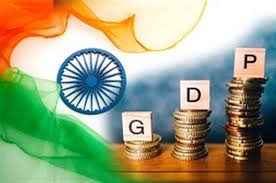

A recent survey has revealed that countries in the Global South exhibited the highest levels of economic optimism in September, with India securing the third position among the most optimistic nations. The survey, conducted by a leading global research firm, highlighted positive sentiments regarding economic recovery, investment opportunities, and growth potential across the region.
Respondents from various sectors in the Global South expressed confidence in their economies, driven by factors such as increasing consumer demand, government stimulus measures, and a rebound in industrial activity. India, in particular, was praised for its robust recovery following the pandemic, with strong performances in sectors like technology, manufacturing, and agriculture.
The survey indicated that 65% of Indian respondents believe the economy will improve in the next six months, citing factors such as rising foreign investments, improved infrastructure, and a favorable policy environment as key drivers of their optimism. “India’s economic fundamentals remain strong, and there is a collective belief in the country’s growth trajectory,” said an economist involved in the survey.
Countries leading the optimism chart included Brazil and Mexico, which ranked first and second, respectively. Both nations also reported positive economic indicators, including job creation and business expansion. The survey highlighted that this trend among the Global South reflects a broader shift in economic dynamics, with emerging markets gaining more influence on the global stage.
Despite the positive outlook, challenges such as inflation, geopolitical tensions, and supply chain disruptions remain concerns for many respondents. However, the overall sentiment suggests a resilient confidence in the capabilities of the Global South to navigate these challenges.
As the world continues to recover from the economic impacts of the COVID-19 pandemic, the survey results signal a hopeful outlook for countries in the Global South, positioning them as key players in the global economy.
(NNI / Latest news / Latest news india / India latest news/UPSC Preparation)
"Rupee Declines Against US Dollar as FPI Outflows Weigh on Domestic Mark
Latest News: 04th October 2024


The Indian rupee weakened against the US dollar in today's trading session, closing at a notable low as foreign portfolio investors (FPIs) continued to pull out funds from the domestic equity market. The currency closed at ₹83.50 per dollar, reflecting a loss of 0.25% from the previous day’s close.
Market analysts attribute this depreciation to a combination of factors, including rising concerns over global economic conditions and increased selling pressure in the Indian stock markets. FPIs have been net sellers in recent weeks, withdrawing substantial amounts of capital as they reassess their investments in light of shifting economic indicators and geopolitical tensions.
The outflow of foreign investments has not only affected the rupee but has also raised concerns about potential impacts on market stability and economic growth. Experts suggest that continued FPI outflows could lead to further pressure on the rupee, especially if investors remain cautious in the face of upcoming economic data releases.
In response to the weakening currency, the Reserve Bank of India (RBI) is closely monitoring the situation. Economists suggest that any significant depreciation of the rupee could prompt the central bank to intervene in the forex market to stabilize the currency.
As global economic conditions remain uncertain, traders and investors are advised to stay vigilant and adapt their strategies accordingly, while keeping an eye on both domestic and international developments that may impact currency movements in the near future.
(NNI / Latest news / Latest news india / India latest news/UPSC Preparation)
India Faces Economic Pressure as August Exports Fall and Trade Deficit Swells to $30 Billion
Latest News: 18th September 2024

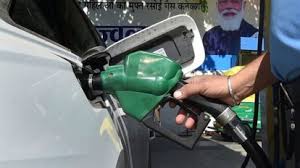
India’s goods exports experienced a significant decline in August, dropping by 9% compared to the previous year, primarily due to a slowdown in petroleum exports. The overall trade deficit widened to a ten-month high of $30 billion, raising concerns about the country’s economic outlook.
According to recent data released by the Ministry of Commerce, total merchandise exports for August stood at $32 billion, down from $35.2 billion in the same month last year. The decline in petroleum exports, which account for a substantial portion of India’s total exports, is attributed to fluctuating global oil prices and reduced demand.
The widening trade deficit is also influenced by a surge in imports, particularly of crude oil and gold. India’s imports rose to $62 billion in August, further exacerbating the trade imbalance. Economists warn that the rising trade deficit could put pressure on the Indian rupee and affect the country’s foreign exchange reserves.
Experts emphasize the need for diversification in export markets and products to mitigate the impact of global fluctuations. "The government must focus on enhancing non-petroleum exports to stabilize trade balances and foster sustainable economic growth," said an industry analyst.
As the government seeks to address these challenges, the decline in exports underscores the importance of strategic planning to ensure a resilient trade environment. With global economic uncertainties persisting, stakeholders are closely monitoring the situation as India navigates its trade dynamics.
(NNI / Latest news / Latest news india / India latest news/UPSC Preparation)
"Final Call for FPI Beneficial Ownership Disclosure: Deadline Set for September 9"
Latest News: 17th September 2024
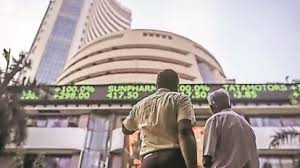

The regulatory deadline for reporting the beneficial ownership of Foreign Portfolio Investments (FPIs) is set to expire on September 9, 2024. This requirement mandates that all FPIs disclose detailed information about the individuals who hold substantial ownership stakes or control in the investment vehicles.
The directive, issued by the Securities and Exchange Board of India (SEBI), aims to enhance transparency in the financial markets by ensuring that the true owners of FPI holdings are identified and reported. This move is part of broader efforts to prevent market abuse, ensure compliance with anti-money laundering regulations, and maintain the integrity of India’s financial systems.
Beneficial ownership reporting requires FPIs to submit comprehensive data about their investors, including names, addresses, and the extent of their ownership. This information is crucial for regulatory authorities to monitor and manage potential risks associated with foreign investments. It also helps in safeguarding against illicit financial activities such as money laundering and terrorist financing.
FPIs have been given a specific timeframe to complete this reporting, and the September 9 deadline marks the final day for submissions. Failure to comply with this requirement could result in penalties or restrictions on trading activities, underscoring the importance for FPIs to adhere to the new regulations.
The deadline is a key milestone in the regulatory landscape for FPIs, reflecting SEBI’s ongoing commitment to improving transparency and accountability within the financial sector. It follows recent regulatory changes aimed at tightening the oversight of foreign investments and ensuring that financial markets operate in a fair and orderly manner.
In preparation for the deadline, many FPIs have already begun the process of collecting and verifying the necessary information to ensure timely and accurate reporting. Financial institutions and compliance teams have been working diligently to meet the requirements and avoid any last-minute complications.
Investors and market participants are advised to review their compliance procedures and ensure that all necessary documentation is submitted by the deadline. For those seeking guidance or assistance, SEBI has provided resources and support to facilitate the reporting process.
The successful implementation of this reporting requirement is expected to strengthen the regulatory framework for FPIs and contribute to a more transparent and robust financial environment. As the September 9 deadline approaches, all FPIs are urged to complete their beneficial ownership disclosures to ensure compliance and avoid any disruptions in their investment activities.
(NNI / Latest news / Latest news india / India latest news/UPSC Preparation)
"India's Forex Reserves Surge by $5.25 Billion to Record High of $689.24 Billion"
Latest News: 15th September 2024
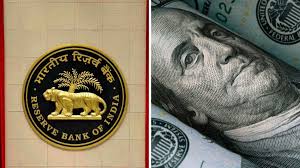

India's foreign exchange reserves have reached a new all-time high, climbing by $5.25 billion to total $689.24 billion, according to recent data released by the Reserve Bank of India (RBI). This marks a significant milestone in the country’s economic stability and financial strength.
The latest increase in forex reserves is attributed to a combination of factors, including strong foreign investment inflows and favorable external economic conditions. The reserves have surged to this unprecedented level, surpassing the previous peak, reflecting robust economic fundamentals and improved investor confidence in the Indian economy.The increase in reserves is also seen as a buffer against global financial volatility and exchange rate fluctuations. A larger reserve base provides India with greater capacity to manage currency fluctuations and external shocks, thereby bolstering economic stability.Economists and analysts have welcomed the rise in forex reserves, noting that it strengthens India's financial position globally. The reserves are comprised of foreign currency assets, gold holdings, and Special Drawing Rights (SDRs) with the International Monetary Fund (IMF).The RBI's foreign exchange reserves are crucial for maintaining the stability of the Indian rupee and supporting economic growth. A healthy reserve base also enhances India’s ability to meet its international financial obligations and support import financing.The significant rise in reserves follows a period of sustained economic recovery and positive trade balances. The robust performance in various sectors, including information technology and pharmaceuticals, has contributed to the influx of foreign exchange into the country.The government and RBI officials have expressed optimism about the continued positive trend in the forex reserves, which they believe will support India's ongoing efforts to bolster economic resilience and attract further foreign investments.As India continues to navigate global economic uncertainties, the record-high forex reserves provide a solid foundation for addressing future challenges and ensuring sustainable growth in the years to come.
(NNI / Latest news / Latest news india / India latest news/UPSC Preparation)
"RBI Governor Das: India Poised for 7.5% Growth or Higher Amidst Economic Optimism"
Latest News: 13th September 2024
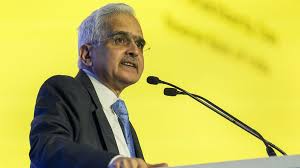

Reserve Bank of India (RBI) Governor Shaktikanta Das has expressed a bullish outlook on India’s economic prospects, stating that the country has the potential to achieve a growth rate of 7.5% or higher. In a recent statement, Das highlighted that India's robust economic fundamentals and favorable demographic trends underpin this optimistic forecast. He emphasized that with the right policy measures and continued investment in infrastructure and innovation, the nation could surpass current growth expectations.
Das's remarks come amid ongoing discussions about the global economic landscape and India's role in it. The RBI Governor also reassured stakeholders about the central bank's commitment to maintaining financial stability and supporting economic growth through prudent monetary policies. His comments are expected to bolster confidence among investors and policymakers, reinforcing the narrative of India as a key player in the global economy.
(NNI / Latest news / Latest news india / India latest news/UPSC Preparation)
54th GST Council Meeting
Latest News: 12th September 2024, UPSC Preparation

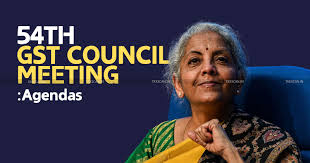
The 54th Goods and Services Tax (GST) Council meeting took place in New Delhi, led by Finance Minister Nirmala Sitharaman. The council focused on adjusting tax rates for essential items, including health insurance, cancer drugs, and snacks.
Major Decisions Made
Group of Ministers (GoM): A special group has been created to review GST rates on health insurance, cancer medicines, and savoury snacks (known as namkeens).
GST Cut on Cancer Drugs: The council proposed reducing the GST from 12% to 5% on specific cancer treatments. This includes expensive drugs like Trastuzumab Deruxtecan, Osimertinib, and Durvalumab.
Impact on Cancer Treatment
The reduction in GST is expected to lower the cost of cancer treatments, which can be very high. India has seen a rise in cancer cases, and this move aims to help reduce the financial stress on patients. Below are some of the current prices of key cancer drugs:
Trastuzumab Deruxtecan: ₹22,300 per vial
Osimertinib: ₹204,000 for 10 tablets
Durvalumab: ₹157,000 per vial
Potential Reductions on Other Goods
Savoury Snacks (Namkeens): The council is considering reducing GST on these snacks from 18% to 12%, with non-fried variants possibly taxed at 5%.
Research Services: Services provided by government bodies, universities, and colleges for research could be exempt from GST.
Increases in GST for Certain Items
Car and Motorcycle Seats: The GST on these items may increase from 18% to 28%.
Helicopter Charters: GST for helicopter charters will stay at 18%, but passenger transport via helicopters will continue to be taxed at 5%.
Changes in Taxpayer Responsibilities
Reverse Charge Mechanism: Updates have been proposed for how taxes are applied on commercial property rentals and metal scrap transactions. In certain cases, the buyer will be responsible for paying the tax.
Interest Waiver: Taxpayers who have pending tax demands from previous years may be eligible for a waiver if they pay by March 31, 2025.
Future Plans
GoM Report on Insurance: The GoM will submit its findings on life and health insurance GST rates by October 2024.
New Invoice System: A new Invoice Management System (IMS) will be introduced to simplify invoicing and reduce errors in input tax credits. A pilot project for B2C (business-to-consumer) e-invoicing will also be launched to improve retail transaction transparency.
This meeting reflects important changes in India’s GST policy. By lowering taxes on key cancer drugs and other essentials, the council aims to ease the financial burden on consumers. However, certain goods and services like car seats may see higher taxes, balancing out the tax reliefs in other areas.
(NNI / Latest news / Latest news india / India latest news/UPSC Preparation)
Renewable Energy Minister Says India Needs Rs 30 Lakh Crore To Meet 50 GW By 2030
Latest News: 11th September 2024
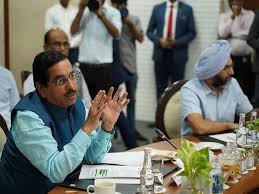

India's Renewable Energy Minister has stated that the country needs an investment of Rs 30 lakh crore to meet its goal of generating 50 gigawatts (GW) of renewable energy by 2030. The substantial financial requirement underscores the scale of the transition towards cleaner energy and the government's commitment to expanding its renewable energy infrastructure.
(NNI / Latest news / Latest news india / India latest news/UPSC Preparation)
‘We will be in a position to export lithium-ion batteries soon’: Nitin Gadkari
Latest News: 10th September 2024
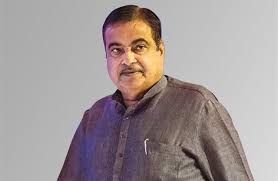

Union Minister Nitin Gadkari has announced that India will soon be in a position to export lithium-ion batteries. This development is part of the country's broader push to advance its battery manufacturing capabilities and strengthen its position in the global market. Gadkari's statement reflects India's growing focus on renewable energy and technological innovation.
(NNI / Latest news / Latest news india / India latest news/UPSC Preparation)
India’s growth story intact, polls brought govt expenditure down: RBI governor day after GDP slips to 5-quarter low
Latest News: 09th September 2024, UPSC Preparation
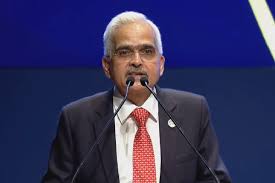

RBI Governor Shaktikanta Das has assured that India's growth story remains robust, despite the GDP slipping to a five-quarter low. He attributed the decline partly to reduced government expenditure following recent elections. Das emphasized that the long-term economic fundamentals are strong, and temporary fluctuations do not undermine the overall growth trajectory.
(NNI / Latest news / Latest news india / India latest news/UPSC Preparation)
India’s Forex Reserves Hit Record High of USD 683.987 Billion
Latest News: 08th September 2024, UPSC Preparation


India’s foreign exchange reserves reached a new record of USD 683.987 billion. This increased by USD 2.299 billion in just one week, continuing an upward trend from the earlier high of USD 681.688 billion.
Growth Trend in 2024
In 2024, India’s reserves have grown by more than USD 60 billion, showing impressive progress, especially compared to a decline of USD 71 billion in 2022. In 2023 alone, the reserves increased by about USD 58 billion, highlighting a positive shift in the country’s economic position.
Components of Forex Reserves
India’s foreign exchange reserves consist of various assets. The largest portion is foreign currency assets (FCA), which have now reached USD 599.037 billion after growing by USD 1.485 billion. In addition to this, gold reserves have also seen an increase, rising by USD 862 million to a total of USD 61.859 billion.
Importance of Forex Reserves
Foreign exchange reserves play a critical role in protecting the domestic economy from global financial shocks. They act as a financial cushion and are currently sufficient to cover around one year of India’s projected imports. This enhances financial stability and provides security during economic uncertainties.
Role of the Reserve Bank of India (RBI)
The Reserve Bank of India (RBI) is responsible for managing these reserves. It intervenes in the foreign exchange market when needed to stabilize the currency and control liquidity. For example, if the market becomes too volatile, the RBI might sell dollars to maintain stability, without targeting a specific exchange rate.
What are Foreign Exchange Reserves?
Foreign exchange reserves are the assets a country’s central bank holds in foreign currencies. These reserves typically include foreign banknotes, government bonds, and treasury bills. Countries like China, Japan, and Switzerland hold the largest reserves globally. Reserves help stabilize a country’s currency, manage exchange rates, and settle international debts. Many countries diversify their reserves by holding gold or even cryptocurrencies. The International Monetary Fund (IMF) monitors these reserves, which are vital for global trade and investment.
(NNI / Latest news / Latest news india / India latest news/UPSC Preparation)
98% Rs 2,000 Notes Returned To RBI, Rs 7,261 Crore Still With Public
Latest News: 07th September 2024


The Reserve Bank of India (RBI) has received 98% of the Rs 2,000 notes that were withdrawn from circulation, with Rs 7,261 crore still remaining in public hands. The RBI's data highlights the substantial amount of currency that has yet to be returned, reflecting ongoing efforts to manage and phase out the high-denomination notes.
(NNI / Latest news / Latest news india / India latest news/UPSC Preparation)
Sensex down nearly 900 points, investors lose over Rs 4 lakh crore
Latest News: 06th September 2024


The Sensex plunged by nearly 900 points, leading to a significant loss of over Rs 4 lakh crore for investors. The sharp decline reflects widespread market volatility and investor concern over economic uncertainties. The downturn has triggered apprehension among market participants, with analysts closely monitoring the situation for further developments.
(NNI / Latest news / Latest news india / India latest news/UPSC Preparation)
Telangana, Tamil Nadu Top in GSDP Growth
Latest News: 05th September 2024, UPSC Preparation


Telangana, Tamil Nadu, and Rajasthan have been recognized as the fastest-growing large states in India by the Ministry of Statistics and Programme Implementation (MoSPI). These states have achieved impressive economic growth, surpassing the national average GDP growth rate of 8.2%. This means their economies are expanding at a faster pace than the country’s overall economic growth.
Key Growth Numbers
Telangana: Telangana’s economy grew by 9.2%, reaching a Gross State Domestic Product (GSDP) of ₹7.9 lakh crore. This is a significant increase, showing that the state’s economy is strong and growing rapidly.
Tamil Nadu: Tamil Nadu’s economy grew by 8.2%, with its GSDP reaching ₹15.7 lakh crore. This makes Tamil Nadu one of the top-performing states in terms of economic growth.
Rajasthan: Rajasthan experienced an 8% growth in its economy, making it the seventh-largest economy in India. This growth indicates a healthy economic environment in the state.
Importance of the Services Sector
The services sector has been a key factor in driving economic growth in these states. The services sector includes industries like healthcare, finance, education, and tourism, which have been performing well and contributing significantly to the states’ economies.
Tamil Nadu: In Tamil Nadu, the services sector contributes 52% to the total Gross Value Added (GVA), which is a measure of the state’s economic output. This sector grew by 9%, helping the state’s overall economy.
Telangana: Telangana’s services sector is even more dominant, accounting for 63% of the total GVA, with an impressive growth rate of 11%. This shows that the services industry is a major driver of Telangana’s economic success.
Maharashtra: Although Maharashtra remains the largest economy in India, its services sector growth was 9%, which is lower compared to the 13% growth seen in the previous fiscal year (FY23). This indicates a slowdown in the services sector’s contribution to Maharashtra’s economy.
Performance in Other Sectors
While the services sector has been a strong performer, the agriculture sector faced challenges in many states due to the El Niño weather phenomenon, which negatively affected crop production and overall agricultural growth.
Tamil Nadu: Despite the challenges in agriculture, Tamil Nadu’s economy was supported by gains in agriculture, construction, and real estate, contributing to its strong growth.
Telangana: Telangana’s growth was boosted by real estate, other services, and a recovery in the manufacturing sector, which had faced difficulties earlier.
Comparing Top States
Telangana, Tamil Nadu, and Rajasthan have shown impressive growth, but Maharashtra still holds its position as the largest economy in India. Gujarat, which was previously ranked as the second-largest economy, is awaiting confirmation of its ranking based on the latest budget estimates. Uttar Pradesh and Karnataka are also close competitors, ranking fourth and fifth in terms of GSDP.
This overview highlights how important the services sector is in driving growth in India’s largest states, while also pointing out the different challenges and successes in agriculture and other sectors.
What is Gross State Domestic Product (GSDP)
GSDP is a measure of a state’s economic performance, similar to how GDP measures a country’s economy. It represents the total value of goods and services produced within a state. GSDP per capita, which divides the GSDP by the population, provides insight into the standard of living in a state. States with higher GSDP tend to attract more investments and have stronger economies. GSDP data is essential for shaping regional policies and can be influenced by factors like population growth, employment rates, natural disasters, and economic changes.
(NNI / Latest news / Latest news india / India latest news/UPSC Preparation)
Navratna Status Granted to NHPC, SJVN, RailTel PSUs
Latest News: 04th September 2024, UPSC Preparation


NHPC, SJVN, and RailTel, three major public sector companies in India, have been given the prestigious “Navratna” status by the Government of India. This makes them the 18th, 19th, and 20th companies to earn this special title. This status is a significant achievement for these companies, giving them more freedom and power to make decisions and expand their operations.
Eligibility Criteria
To be awarded Navratna status, a company must meet specific criteria:
Miniratna-I Status: The company must already have Miniratna-I status, which is a lower level of recognition given to profitable public sector companies.
Excellent Performance: The company must have received an “Excellent” or “Very Good” rating in its performance evaluation (MoU rating) for at least three of the last five years.
Strong Financial Performance: The company must score at least 60 points in six key financial indicators, such as Net Profit, Net Worth, and Earnings Per Share.
Investment Autonomy
With Navratna status, NHPC, SJVN, and RailTel now have more freedom to make investment decisions:
Investment Autonomy: These companies can now invest up to ₹1,000 crore or 15% of their net worth in a single project without needing approval from the government. They can also invest up to 30% of their net worth in a year if it does not exceed the ₹1,000 crore limit.
Expanded Operational Capabilities: The Navratna status also allows these companies to set up subsidiaries abroad, form joint ventures, and restructure their organizations to improve efficiency and performance.
Overview of the Companies
SJVN (Satluj Jal Vidyut Nigam Limited): SJVN, which became a Miniratna in 2008, manages a large portfolio of 56,802 MW across 75 energy projects, including hydroelectric, solar, and wind power.
NHPC (National Hydroelectric Power Corporation): Established in 1975, NHPC is one of India’s leading hydropower companies, with an installed capacity of 7,144.2 MW. The company aims to increase its capacity to 23,000 MW by 2032 and 50,000 MW by 2047, focusing on major projects in northeastern states like Assam and Arunachal Pradesh.
RailTel: In 2000, RailTel provided telecom infrastructure and broadband services in India. The company manages over 55,000 kilometers of optical fiber networks along railway tracks, making it one of the largest telecom infrastructure providers in the country. RailTel also offers Wi-Fi services at railway stations and supports various government initiatives like Smart Cities and e-governance.
The announcement of Navratna’s status has drawn attention to the shares of these companies. However, despite this positive news, the shares of SJVN, NHPC, and RailTel have recently experienced significant declines, with SJVN and NHPC shares down by 18% and RailTel shares down by 21% from their all-time highs.
(NNI / Latest news / Latest news india / India latest news/UPSC Preparation)
Indian MSMEs losing ground as Chinese goods flood market: GTRI
Latest News: 03rd September 2024, UPSC Preparation

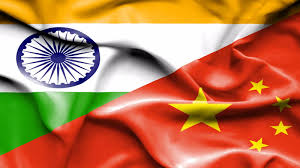
The dominance of Chinese imports is displacing local production, as over 90 per cent of the umbrellas, artificial flowers, and human hair articles used in India are sourced from China.
(NNI / Latest news / Latest news india / India latest news/UPSC Preparation)
India’s growth story intact, polls brought govt expenditure down: RBI governor day after GDP slips to 5-quarter low
Latest News: 02nd September 2024, UPSC Preparation
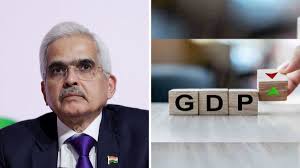

“Going ahead, whatever growth projection we have given for the current FY, which is 7.2%, should be materialised,” Shaktikanta Das said
(NNI / Latest news / Latest news india / India latest news/UPSC Preparation)
RBI Announces Future Launch of Unified Lending Interface (ULI)
Latest News: 29th August 2024, UPSC Preparation
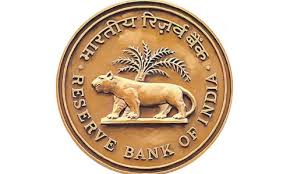

The Unified Lending Interface (ULI) is a new technology platform that the Reserve Bank of India (RBI) plans to introduce across the country. Its main purpose is to make it easier and faster for people, especially those in rural areas, to get loans. ULI is designed to improve the lending process by lowering costs and speeding up how quickly loans are given out.
Why is ULI Needed?
India has been rapidly growing in terms of digital technology, but when it comes to loans, the information needed to assess a person’s creditworthiness (whether they can pay back a loan) is often scattered across different systems. These systems belong to various government bodies and financial institutions. Because this information is not in one place, it makes the process of getting a loan slow and difficult. ULI is being created to solve this problem by bringing all this information together, making lending faster and smoother.
Key Features of ULI
Easy Information Sharing: ULI will allow for the smooth, consent-based sharing of digital information from various sources, like land records, making it easier to access needed details.
Standardized APIs: The platform will use common software tools (APIs) that allow different systems to work together easily, helping banks and lenders quickly access the information they need.
Less Paperwork: By using digital data, ULI will reduce the amount of paperwork borrowers have to deal with, making it faster and simpler to get loans.
Expected Impact of ULI
ULI is expected to meet the high demand for credit, especially in sectors like agriculture and small businesses (MSMEs). It is seen as an important step in improving India’s digital infrastructure, similar to the success of initiatives like JAM (Jan Dhan, Aadhar, Mobile) and
UPI.
How UPI Paved the Way
The Unified Payments Interface (UPI), launched in 2016, has completely changed how digital payments are made in India. It allows people to make real-time transactions through a single mobile app that connects with multiple banks. UPI has been very successful and has drawn global attention for its efficiency, playing a big role in increasing digital payments in India. Just as UPI transformed digital payments, ULI is set to do the same for the lending process. It will provide a strong framework for delivering loans, empowering borrowers, and helping India’s economy grow.
(NNI / Latest news / Latest news india / India latest news/UPSC Preparation)
Union Cabinet Approves Unified Pension Scheme for Employees
Latest News: 27th August 2024, UPSC Preparation

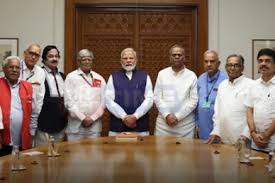
Indian government will start a new pension system called the Unified Pension Scheme (UPS), on April 1, 2025, after getting approval from the Union Cabinet. This scheme aims to address the dissatisfaction among government employees with the current National Pension Scheme (NPS) and comes at a time when several important Assembly elections are approaching.
What is the National Pension Scheme (NPS)?
The NPS began in 2004, replacing the Old Pension Scheme (OPS). It was designed to create a more sustainable pension system. However, under NPS, pensions are not guaranteed and depend on how well investments in the market perform. Employees contribute to this pension alongside the government, but many are unhappy because the benefits are unpredictable and often lower than expected.
What is the Unified Pension Scheme (UPS)?
The Unified Pension Scheme (UPS) is a pension system in India designed to provide financial security for citizens. Launched in 2019, it combines various existing pension schemes into one unified framework to simplify the process and ensure wider coverage. The UPS is linked to an individual’s Aadhaar number for easy identity verification and enrollment. Under this scheme, both employees and employers contribute to the pension fund, and the government also contributes. It promotes financial inclusion by encouraging digital transactions, making it easier for more people to participate in the economic system.
Key Features of the Unified Pension Scheme (UPS)
Guaranteed Pension: Employees will receive 50% of their average basic pay from their last year of work, with adjustments based on how long they have served.
Minimum Pension Guarantee: Retirees with less than 25 years of service will get at least Rs 10,000 per month as a pension, provided they have worked for at least 10 years.
Family Pension: If the retiree passes away, their immediate family will receive 60% of the last drawn pension.
Inflation Adjustment: Pensions will be adjusted for inflation, based on the All India Consumer Price Index.
Lump Sum Payment at Retirement: Along with the gratuity, retirees will receive a one-time payment calculated from their last drawn pay.
Comparing UPS, NPS, and OPS
OPS: Provides a guaranteed pension based on the last salary, without needing the employee to contribute.
NPS: Funded by both the employee and the government, but does not guarantee returns and depends on the market.
UPS: Combines features of both OPS and NPS, offering guaranteed pensions while still requiring employee contributions.
Who Can Get the UPS?
The UPS is available to all government employees who retired under the NPS since 2004. Employees can choose to switch to UPS only once, and it may also be extended to state government employees.
Financial Impact
Implementing the UPS will cost the government around Rs 6,250 crore initially, plus an additional Rs 800 crore for arrears. The new scheme is designed to be financially responsible while addressing employee complaints, unlike the OPS, which had led to unsustainable pension costs. The introduction of UPS is a major political move, intended to maintain the support of government employees as elections approach. Even though some states may face financial challenges, they might still adopt the UPS due to the influence of the central government’s decision and the electoral context.
(NNI / Latest news / Latest news india / India latest news/UPSC Preparation)
RBI Governor ranked among top 3 global central bankers; Modi lauds Shaktikanta Das
Latest News: 26th August 2024

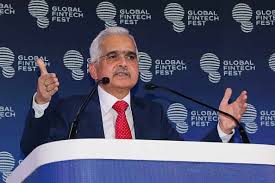
Prime Minister Narendra Modi congratulated Das in a post on X. "This is a recognition of his leadership at the RBI and his work towards ensuring economic growth and stability," Modi said.
(NNI / Latest news / Latest news india / India latest news/UPSC Preparation)
US Approves $52.8 Million Sonobuoy Sale to India
Latest News: 25th August 2024, UPSC Preparation
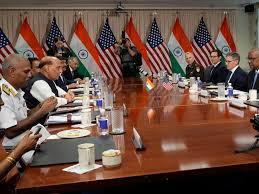

The United States Secretary of State, Antony Blinken, has given the green light for a possible sale of anti-submarine warfare equipment to India, worth around USD 52.8 million. This move highlights the strong commitment between the US and India to strengthen their relationship, especially in the areas of defence and security.
Details of the Sale
The US Department of Defence, through its Defence Security Cooperation Agency (DSCA), has announced that India has asked to buy various sonobuoys, which are special devices used to detect submarines underwater. The specific types include:
AN/SSQ-53G High Altitude Anti-Submarine Warfare (HAASW) sonobuoys
AN/SSQ-62F HAASW sonobuoys
AN/SSQ-36 sonobuoys
Along with the sonobuoys, the sale will also include technical documents, engineering support, and logistical services to help India use and maintain this equipment.
Strategic Importance
This sale is part of the US’s broader foreign policy and national security goals. It is meant to:
Strengthen the strategic partnership between the US and India.
Improve India’s defence capabilities, especially in the Indo-Pacific and South Asia regions, which are very important for maintaining political stability and economic growth.
Operational Impact
With this new equipment, India will be better equipped to carry out anti-submarine warfare, especially using its MH-60R helicopters. The DSCA is confident that India will be able to smoothly integrate this advanced equipment into its current military systems without any issues.
Regional Stability Concerns
The purpose of this sale is to support stability in the region rather than disrupt it. It is designed to maintain the current military balance, ensuring that the region remains peaceful. The companies expected to be the main contractors for this sale are Sparton Corporation and Undersea Sensor Systems Inc. There haven’t been any reports about additional agreements, known as “offset agreements,” related to this deal. This proposed sale of anti-submarine warfare equipment to India is a significant step in boosting defence relations between the US and India. It reflects the shared interests of both countries in security and strategic cooperation, especially in a world where the geopolitical landscape is rapidly changing.
(NNI / Latest news / Latest news india / India latest news/UPSC Preparation)
Jackson Hole Symposium 2024
Latest News: 24th August 2024, UPSC Preparation
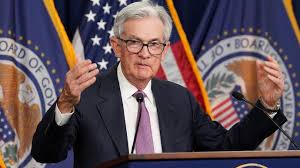

The Jackson Hole Economic Policy Symposium is a yearly event that gathers important people like central bankers, economists, and policymakers from around the world. It is organized by the Federal Reserve Bank of Kansas City. Since it began in 1978, this event has become a key meeting place where big ideas about the global economy and money policies are discussed. People like Ben Bernanke, a former U.S. Federal Reserve Chair, and Mario Draghi, the former President of the European Central Bank, have spoken at this event, making it very influential.
Why the 2024 Symposium is Important
The 2024 symposium, happening from August 22-24, is especially important because it could give us clues about what might happen with interest rates in the future. Jerome Powell, the current Chair of the Federal Reserve, is expected to give a speech that might include hints about whether the Federal Reserve will cut interest rates to help reduce unemployment. Investors are paying close attention because such decisions can greatly affect financial markets around the world.
How the Symposium Impacts Global Markets
What is said at the Jackson Hole Symposium can have a big impact on global financial markets. If the discussions suggest that interest rates will go up (a “hawkish” stance), this could lead to a drop in stock markets. But if the talks hint that interest rates might go down (a “dovish” tone), it could boost the markets. This year, many are looking forward to seeing if there will be any signs of interest rate cuts by the Federal Reserve, as these have been crucial in past market recoveries.The Jackson Hole Economic Policy Symposium is more than just a meeting—it’s a major event that shapes how the global economy is managed. What’s discussed there can set the stage for economic decisions that affect everyone, from big investors to everyday people. That’s why it’s watched so closely by those who care about the economy.
What Happened in 2023
Last year’s symposium in 2023 focused on “Structural Shifts in the Global Economy.” Influential speakers like Jerome Powell and Christine Lagarde, President of the European Central Bank, talked about important issues like how monetary policies (the way central banks manage money supply and interest rates) need to adapt to new economic challenges. Their insights had a real impact on how central banks around the world set their strategies over the past year.
What to Expect in 2024
For its 47th year, the 2024 symposium will explore “Reassessing the Effectiveness and Transmission of Monetary Policy.” This means they’ll be discussing how well past policies have worked, especially those put in place during the pandemic and periods of high inflation. The goal is to learn from these experiences to better understand how to keep economies strong and growing in the future.
The Jackson Hole Economic Policy Symposium is more than just a meeting—it’s a major event that shapes how the global economy is managed. What’s discussed there can set the stage for economic decisions that affect everyone, from big investors to everyday people. That’s why it’s watched so closely by those who care about the economy.
uniform civil code / what is uniform civil code / uniform civil code meaning / uniform civil code article / uniform civil code in india / uniform civil code in hindi / uniform civil code upsc / uniform civil code kya hai / ucc uniform civil code / what is uniform civil code in india / uniform civil code Uttarakhand / uniform civil code essay / uttarakhand uniform civil code / uniform civil code means / uniform civil code kerala / kerala uniform civil code / uniform civil code in which state of india / uniform civil code pdf / uniform civil code in Uttarakhand / uniform civil code india
Use simple words in notices to taxpayers, exercise power judiciously: FM tells taxmen
Latest News: 22nd August 2024
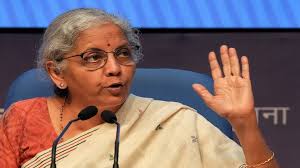

Addressing the 165th Income Tax Day celebrations, Ms. Sitharaman said that after adopting the faceless regime, the tax officers must now aspire to be more ‘fair and friendly’ in their dealings with taxpayers
uniform civil code / what is uniform civil code / uniform civil code meaning / uniform civil code article / uniform civil code in india / uniform civil code in hindi / uniform civil code upsc / uniform civil code kya hai / ucc uniform civil code / what is uniform civil code in india / uniform civil code Uttarakhand / uniform civil code essay / uttarakhand uniform civil code / uniform civil code means / uniform civil code kerala / kerala uniform civil code / uniform civil code in which state of india / uniform civil code pdf / uniform civil code in Uttarakhand / uniform civil code india
‘Do not permit creation of shell companies, not a tax haven’: Mauritius regulator on Hindenburg report
Latest News: 21st August 2024


The response comes days after Hindenburg Research alleged that the Sebi Chairperson Madhabi Puri Buch and her husband, Dhaval Buch, had stake in obscure offshore entities used by the Adani group for siphoning off the money.
(NNI / Latest news / Latest news india / India latest news/UPSC Preparation)
Government Finalizes Tender for 1,000 GPUs Under IndiaAI Mission
Latest News: 20th August 2024, UPSC Preparation


The Indian government is pushing forward with the IndiaAI Mission, aiming to build strong AI computing abilities. They have finalized a plan to buy 1,000 graphics processing units (GPUs), which are crucial for helping start-ups, researchers, and public agencies.
Main Goals of the IndiaAI Mission
The mission has a budget of ₹10,370 crore and plans to use more than 10,000 GPUs. The goal is to create AI models with over 100 billion parameters, tailored to work with major Indian languages, especially in areas like healthcare and agriculture. Those who win the contract must provide AI computing time right away: 100 hours immediately, 500 hours within two days, and more than 500 hours within a week. This setup will support the growing demand for AI by making computing resources easier to access.
Details of the Tender
The tender allows groups of companies to bid together, but at least one partner must have an annual income of over ₹100 crore. All bids must ensure that user data stays within India’s borders, following data localization rules. The project will use a public-private partnership model, where the government will cover 50% of the cost to make building the necessary infrastructure more affordable. About ₹4,564 crore will be used specifically for developing this computing infrastructure.
Impact on Start-ups and SMEs
This new computing capacity will make AI resources more available to small and medium enterprises (SMEs) and start-ups, which often find these resources too expensive and hard to get. This move aims to boost innovation and competitiveness in India’s tech sector.
What is AI Computing Capacity?
AI computing power has grown rapidly, with GPUs and TPUs leading the way. For example, in 2021, the world’s largest AI model, OpenAI’s GPT-3, had 175 billion parameters. Training AI models can use up a lot of electricity, but improvements in AI algorithms are making them more efficient. Supercomputers like Fugaku are often used to train AI models, and future advancements like quantum computing could further increase AI’s speed and efficiency.
About the IndiaAI Mission
Launched in 2020, the IndiaAI Mission aims to enhance AI research and innovation, focusing on ethical AI use and collaboration. India is currently third in the world for AI research output. The mission supports start-ups with funding and resources and has established the National AI Portal as a central knowledge hub. It promotes AI in sectors like agriculture, healthcare, and education and works with global groups like the Global Partnership on AI. The mission also aims to train over 1 million AI experts by 2025, boosting the skills of the workforce.
What is Graphics Processing Units (GPUs)?
GPUs were first developed in the late 1990s and revolutionized how images are rendered on screens. NVIDIA’s GeForce 256 is considered the first true GPU. While GPUs are widely known for gaming, they are also vital in AI, cryptocurrency mining, and scientific research. Unlike CPUs, which have fewer cores, GPUs have thousands, allowing them to process many tasks at once. NVIDIA’s CUDA programming model helps developers use GPUs for various tasks. AMD’s Radeon was the first to support Direct3D 11. The term “GPU” was coined by NVIDIA in 1999, highlighting its key role in modern computing.
(NNI / Latest news / Latest news india / India latest news/UPSC Preparation)
Banks woo depositors with special schemes amid contest with markets
According to bank officials, current and savings bank (CASA) deposits declined during the quarter. SBI’s CASA deposits fell to Rs 19.41 lakh crore from Rs 19.14 lakh crore in March 2024.
Latest News: 18th August 2024


With deposit growth slowing down, banks are racing to mobilise funds through special deposit schemes and other innovative plans to meet the credit demand in the system. Many banks have reported a decline in deposits during the quarter ended June 2024 as customers are now looking at alternative avenues like the capital markets to park their funds for better returns.
State Bank of India (SBI), India’s largest bank, registered a fall in deposits to Rs 49.01 lakh crore in the June quarter of FY25, compared to Rs 49.16 lakh crore in the March 2024 quarter. Bank of Baroda reported a fall in deposits from Rs 13.26 lakh crore to Rs 13.06 lakh crore in the June quarter. Other banks also reported a similar trend during the June quarter.
(NNI / Latest news / Latest news india / India latest news/UPSC Preparation)
Rupee settles flat at 83.97 against US dollar
Latest News: 17th August 2024


Anil Kumar Bhansali, Head of Treasury and Executive Director, Finrex Treasury Advisors LLP, said, the rupee was again in a range of 3 paise with RBI selling at 83.97 while others buying dollar.
(NNI / Latest news / Latest news india / India latest news/UPSC Preparation)
‘Tax’ by militants stirs Nagaland protests
Latest News: 15th August 2024


Such illegal “tax” demands from separatist outfits are common in Nagaland with unbridled collections and coercion by Naga nationalist and separatist groups
news live / news24 live / news aaj tak / news18 live / news live hindi / news today / news 24 / news aaj ka / news aaj ki / news abp live / news aaj tak live today 2024 live / news asianet live / news abp / news arjun / ai news today / news Pakistan / news live / ai news 24 / news book / news channel / dd news / news eighteen live / news english live india / news elvish Yadav / news English / news election / news eighteen / news english live / bd news 24 / dd news live / news debate in hindi latest / news dijiye / news db live / news drishti ias / news dikhaiye / news bharat / news live / news channel live hindi / news channel live hindi all / news channel live / news nation / news live
#breakingnews #sneakernews #freefirenews #fortnitenews #footballnews #cryptonewsdaily #artnewss #artsnewss #aeronewsx #goodnewsxhm #runews24 #wasinews24 #xebernews24 #cryptonews24 #foxnews5 #wkrgnews5 #actionnews5 #wlwtnews5 #ktlanews5 #cearánews7 #eyewitnessnews7 #abcnews7 #bvbnews7 #commentwithnews7tamil
#baynews9
The Banking Laws (Amendment) Bill, 2024, introduced by Union Finance Minister Nirmala Sitharaman, brings several important updates to banking regulations in India.
Latest News: 14th August 2024
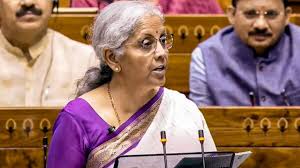

Significance of the Bill
Consistency in Reporting: The Bill aims to create uniformity in how banks report to the RBI, making the process more predictable and streamlined.
Increased Nominee Options: Allowing up to four nominees addresses issues related to unclaimed deposits, which have accumulated significantly (over ₹42,000 crore as of March 2023). This change helps ensure that accounts are managed according to the depositor's wishes and reduces the incidence of unclaimed assets.
Investor Protection: By transferring unclaimed assets to the IEPF, the Bill enhances investor protection and ensures that individuals can reclaim their assets from a centralized fund.
Conclusion
The Banking Laws (Amendment) Bill, 2024 modernizes banking regulations by increasing nominees, redefining substantial interest, and improving auditor flexibility.
(NNI / Latest news / Latest news india / India latest news)
(UPSC current affairs / UPSC / UPSC Preparation / UPSC Preparation Books / UPSC Preparation Strategy )
REFUGEE RIGHTS, THE GENDERED NATURE OF DISPLACEMENT
Latest News: 14th August 2024


Armed conflict, violence, human rights abuses, and persecution have reportedly displaced 117.3 million people worldwide by the end of 2023, with 37.6 million of them being refugees.
Millions of people around the world are forced to flee their homes due to armed conflict, violence, and persecution. This situation results in a substantial number of displaced individuals.
As of the end of 2023, the United Nations High Commissioner for Refugees (UNHCR) reported that approximately 117.3 million people were displaced globally. Among these, 37.6 million were refugees.
The ongoing conflicts in regions like Israel, Ukraine, and Myanmar are likely to increase these numbers.
Gendered Impact of Displacement
Women, especially those with disabilities, are particularly affected by displacement.
The United Nations Population Fund highlights that “the face of displacement is female,” meaning women and girls disproportionately bear the brunt of displacement’s hardships.
Legal Framework and India's Role
UN Convention on the Rights of Persons with Disabilities (UNCRPD): This international treaty recognizes the rights of persons with disabilities, including those with psychosocial disabilities. It mandates that women and girls with disabilities should enjoy all human rights and fundamental freedoms equally.
Rights of Persons with Disabilities Act, 2016 (RPWDA) in India: This act guarantees rights to persons with disabilities, including access to healthcare. However, it does not explicitly address refugees or psychosocial disabilities, which limits its applicability to refugee women.
Challenges in India
Lack of Specific Legislation: India is not a party to the 1951 Refugee Convention or its 1967 Protocol, and lacks specific domestic legislation for refugees, including those with disabilities. This creates a gap in protecting the rights of refugee women with psychosocial disabilities.
Limited Access to Healthcare: Refugees often have restricted access to health services and are excluded from most public health programs available to citizens. This means that even though the Supreme Court of India has affirmed refugees’ right to health under Article 21, practical access to these services remains limited.
Need for a Uniform Framework: To address these issues, India needs a comprehensive legal framework that includes specific provisions for refugees with disabilities. This would help in implementing international commitments and ensuring that refugees with disabilities are adequately supported.
Moving Forward
Develop Inclusive Policies: Create and enforce policies that specifically address the needs of refugees with disabilities, ensuring their inclusion in health care and other services.
Collect Data: Gather disaggregated data on the health conditions of refugees with disabilities to better understand their needs and challenges.
Enhance Awareness and Support: Increase awareness about the specific issues faced by refugee women with disabilities and improve the accessibility and availability of mental health services.
Conclusion
The ongoing systematic gaps in India’s refugee protection framework and the exclusion of refugees with disabilities from essential rights highlight a pressing need for comprehensive reforms to ensure their well-being and equal access to support services.
(NNI / Latest news / Latest news india / India latest news)
(UPSC current affairs / UPSC / UPSC Preparation / UPSC Preparation Books / UPSC Preparation Strategy )
Unicommerce eSolutions IPO lists at 118% premium: Hold or sell?
Latest News: 13th August 2024


Unicommerce eSolutions IPO listing: The shares opened at Rs 235 on the NSE, marking a premium of 117.59% over its issue price of Rs 108.
(NNI / Latest news / Latest news india / India latest news)
(UPSC current affairs / UPSC / UPSC Preparation / UPSC Preparation Books / UPSC Preparation Strategy )
Banking Laws Amendment Bill 2024
Latest News: 12th August 2024, UPSC Preparation
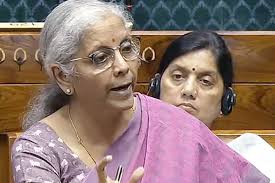

Minister of State for Finance Pankaj Chaudhary introduced the Banking Laws (Amendment) Bill, 2024, in the Lok Sabha. The purpose of this Bill is to give customers more options and to improve the way banks are governed.
Key Provisions of the Bill
Nominee Options: The Bill allows bank account holders to name up to four nominees for their accounts, instead of just one, as is the current rule.
Definition of ‘Substantial Interest’: The Bill proposes raising the limit for what counts as a ‘substantial interest’ in bank directorships from ₹5 lakh to ₹2 crore. This change reflects how the economy has grown over the past sixty years.
Bank Auditor Remuneration: Banks will have more control over how much they pay their statutory auditors.
Regulatory Reporting Dates: The dates by which banks must report compliance will now be the 15th and last day of each month, making the process more efficient.
Legislative Background
The Bill aims to update several important laws, including:
The Reserve Bank of India Act, 1934
The Banking Regulation Act, 1949
The State Bank of India Act, 1955
The Banking Companies (Acquisition and Transfer of Undertakings) Act, 1970
The Banking Companies (Acquisition and Transfer of Undertakings) Act, 1980
These changes were first mentioned by Finance Minister Nirmala Sitharaman during her 2023-24 Budget speech. They are designed to strengthen how banks are managed and to protect investors.
Controversy and Opposition
However, Congress member Manish Tewari opposed the Bill, arguing that state governments should have the power to make laws about cooperative societies. In response, Finance Minister Sitharaman explained that the Bill is focused on banking regulations and does not intend to interfere with cooperative banks that have banking licenses.
Facts about the Reserve Bank of India Act
The Reserve Bank of India (RBI) was established by the RBI Act in 1934, officially starting on April 1, 1935. Initially, the RBI’s main job was to regulate currency and maintain monetary stability. The Act gives the RBI the authority to issue currency notes (except one-rupee notes) and to manage foreign exchange and inflation through monetary policy. The Act has been amended 60 times to include new financial regulations. The first Governor of the RBI was Osborne Smith. The Act outlines the roles of the central bank in managing India’s economy.
(NNI / Latest news / Latest news india / India latest news)
(UPSC current affairs / UPSC / UPSC Preparation / UPSC Preparation Books / UPSC Preparation Strategy )
5th ASEAN-India Trade in Goods Agreement Joint Committee held in Jakarta
Latest News: 8th August 2024, UPSC Preparation


The 5th AITIGA Joint Committee and related meetings took place from July 29 to August 1, 2024, at the ASEAN Secretariat in Jakarta, Indonesia. The goal of these meetings was to strengthen economic cooperation between ASEAN countries and India, emphasizing the importance of the ASEAN-India Trade in Goods Agreement (AITIGA).
Background on AITIGA
AITIGA, established in 2009, aims to make trade easier between ASEAN countries and India by reducing barriers and promoting free trade, thereby strengthening economic ties. The recent meetings focused on reviewing and updating this agreement to fit current trade conditions.
Structure of Recent Meetings
The meeting was co-chaired by Shri Rajesh Agrawal from India’s Department of Commerce and Ms. Mastura Ahmad Mustafa from Malaysia. Delegates from all 10 ASEAN countries and India attended, ensuring that all sides were represented in the trade discussions. Discussions to review AITIGA started in May 2023. The Terms of Reference and Negotiating Structures were established, and negotiations began in February 2024.
Sub-Committees and Their Functions
Eight sub-committees addressed important areas such as:
National Treatment and Market Access
Rules of Origin
Standards, Technical Regulations, and Conformity Assessment Procedures
Sanitary and Phytosanitary Measures
Legal and Institutional Issues
Customs Procedures and Trade Facilitation
Trade Remedies
Economic and Technical Cooperation
Each sub-committee reported their findings to the Joint Committee to guide future discussions.
Bilateral Engagements
During the meetings, the Indian delegation also had bilateral talks with delegates from Malaysia, Singapore, Indonesia, and Vietnam to better understand the issues at hand. At a dinner organized by the Indian Embassy in Jakarta, the delegation spoke with Indian businesses to gather insights and expectations about the AITIGA review, emphasizing the initiative’s goal of achieving practical outcomes for industry stakeholders.
(NNI / Latest news / Latest news india / India latest news)
(UPSC current affairs / UPSC / UPSC Preparation / UPSC Preparation Books / UPSC Preparation Strategy )
Lok Sabha Passes Appropriation Bill for Financial Year 2024-25
Latest News: 7th August 2024, UPSC Preparation


On 26th February 2024, the Lok Sabha passed the Appropriation (No. 2) Bill, 2024, allowing the Indian government to withdraw funds from the Consolidated Fund of India for the 2024-25 financial year. This followed discussions on budget allocations for several ministries, especially the Ministry of Fisheries, Animal Husbandry, and Dairying.
Understanding the Appropriation Bill
The Appropriation Bill is an important legislative measure that enables the government to spend money allocated for various expenses within a financial year. This Bill makes it legally possible to transfer the necessary funds for government operations.
Procedure in Lok Sabha
During the session, Speaker Om Birla shortened the discussions and moved the Bill forward at 6 PM after addressing cut motions proposed by members, which were then rejected. Finance Minister Nirmala Sitharaman proposed the Bill for approval, and it was passed shortly after.
Key Ministry Highlights
During the discussions, Minister Rajiv Ranjan Singh talked about the government’s funding initiatives, especially in fisheries and animal husbandry. He highlighted the Modi government’s non-discriminatory approach to state funding, mentioning specific projects in West Bengal, Kerala, and Andhra Pradesh.
Investment in Fisheries Projects
Singh pointed out significant financial allocations, including ₹41.44 crore for West Bengal under the Blue Revolution Project. He also noted that India is the second-largest fishery producer in the world and the top dairy producer.
Fishermen’s Support Initiatives
The government has started various welfare measures for fishermen, including the installation of a transponder by ISRO. This device helps with communication and ensures the safety of fishermen who might cross maritime boundaries.
(NNI / Latest news / Latest news india / India latest news)
(UPSC current affairs / UPSC / UPSC Preparation / UPSC Preparation Books / UPSC Preparation Strategy )
Bangladesh political crisis: Indian exporters stare at disruption in goods flow, brace for payment delays
Latest News: 6th August 2024
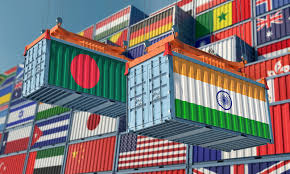

Monday’s developments in Bangladesh came at a time when the country is grappling with an economic crisis.
(NNI / Latest news / Latest news india / India latest news)
(UPSC current affairs / UPSC / UPSC Preparation / UPSC Preparation Books / UPSC Preparation Strategy )
Zomato collected Rs 83 crore in platform fee from customers till March
Latest News: 5th August 2024


Platform fee has been cited as one of the three key factors driving Zomato's Adjusted Revenue, which grew 27 per cent year-on-year to Rs 7,792 crore in FY24.
(NNI / Latest news / Latest news india / India latest news)
Mcap of BSE-listed companies jumps to lifetime peak of Rs 462.38 lakh cr
Latest News: 4th August 2024
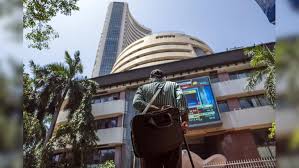

Reliance Industries, Tata Motors, Infosys, Mahindra and Mahindra, Bajaj Finance and Axis Bank were the laggards.
(NNI / Latest news / Latest news india / India latest news)
ADB Loans $200 Million for India’s Waste Management Improvement
Latest News: 3rd August 2024, UPSC Preparation
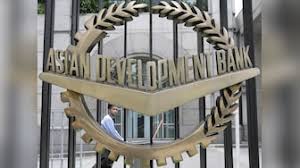

The Asian Development Bank (ADB) has approved a $200 million loan to improve how solid waste and sanitation are handled in 100 cities across India. This project is part of the Swachh Bharat Mission 2.0, which aims to create cleaner cities.
Program Objectives
The funding will be used to improve waste management systems, focusing on better ways to separate, collect, and dispose of waste. The loan was signed by Juhi Mukherjee from the Finance Ministry and Mio Oka, ADB’s Country Director for India.
Infrastructure Development
The money will be used to build and upgrade facilities for handling waste, including:
Bio-methanation plants: These facilities turn organic waste into energy.
Composting plants: These turn organic waste into useful compost for soil.
Managed landfills: Safe places to dispose of waste.
Material recovery facilities: Places where materials from waste are sorted and recycled.
Plastic waste processing centers: Facilities to process and recycle plastic waste.
Climate and Disaster Resilience
The plan will include climate protection, disaster readiness, gender equality, and social fairness in city services. It aims to improve the ability of city management teams to handle waste and sanitation better. The program will encourage cities to learn from each other and work with private companies to improve services.
About Swachh Bharat Mission 2.0
Swachh Bharat Mission 2.0, started in 2021, focuses on making sanitation practices last longer and be more effective. Its goal is to improve how cities handle their waste by encouraging community involvement. The mission supports using scientific ways to process waste, like composting (turning waste into useful compost) and recycling. It also aims to build more public toilets, especially for women. This effort matches the United Nations’ goals for sustainable development and seeks to create overall cleanliness in cities, making urban life better and tackling environmental issues in a meaningful way.
(NNI / Latest news / Latest news india / India latest news)
(UPSC current affairs / UPSC / UPSC Preparation / UPSC Preparation Books / UPSC Preparation Strategy )
India aims for $30 Trillion Economy by 2047
Latest News: 1st August 2024, UPSC Preparation
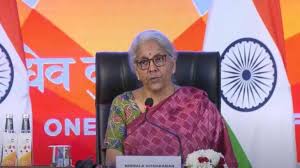

India aims to become a USD 30 trillion economy by 2047, the 100th anniversary of its independence. According to a plan by NITI Aayog, called ‘Vision for Viksit Bharat @ 2047’, the goal is to raise the average income per person to USD 18,000 per year. This plan is designed to help India avoid getting stuck at a middle-income level.
Economic Aspirations
To reach this goal, India needs to grow its economy from the current USD 3.36 trillion to USD 30 trillion, which means it has to grow nine times bigger in the next couple of decades. The average income per person also needs to increase from USD 2,392 to USD 18,000. The report says moving from a middle-income to a high-income country requires a steady annual growth rate of 7-10% for 20-30 years. Only a few countries have managed to maintain such high growth rates consistently.
Defining Viksit Bharat
The idea of Vikshit Bharat means creating a country with high income and advanced social, cultural, technological, and institutional attributes. According to the World Bank, a high-income country has an average annual income per person of more than USD 14,005 (as of 2023). The plan identifies several key challenges, such as improving manufacturing and logistics capabilities and reducing the income gap between rural and urban areas. These improvements are essential for turning the agricultural workforce into a strong industrial workforce.
Collective Efforts
NITI Aayog stresses that achieving this vision requires the participation of the entire nation, not just a few individuals or the government. The document highlights that this is a crucial moment for India, suggesting that the 21st century could be India’s century. Success depends on balancing energy security, accessibility, affordability, and sustainability.
About Viksit Bharat
Vision for Sustainable Growth: ‘Viksit Bharat,’ or ‘Developed India,’ embodies India’s goal for sustainable development by 2047, focusing on reducing poverty, achieving gender equity, and ensuring environmental sustainability.
Urbanization and Smart Planning: With India’s urban population expected to reach 600 million by 2031, smart urban planning is crucial. Key areas of focus include digital innovation and renewable energy.
Skill Development and Economic Self-Reliance: The government prioritizes skill development through initiatives like ‘Skill India’ and promotes local industries via ‘Make in India’ to foster economic independence and growth.
(NNI / Latest news / Latest news india / India latest news)
(UPSC current affairs / UPSC / UPSC Preparation / UPSC Preparation Books / UPSC Preparation Strategy )
India only country where petrol, diesel prices declined in last 3 years: Puri
Latest News: 30th July 2024


New Delhi, Union Petroleum and Natural Gas Minister Hardeep Singh Puri on Monday said India is the only country where rates of petrol and diesel have come down between November 2021 and April 2024.
(NNI / Latest news / Latest news india / India latest news)
Sensex rises 1200 points as market gets rid of budget hangover
Latest News: 29th July 2024

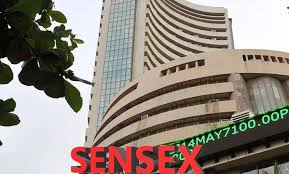
Benchmark stock market indices closed higher after witnessing a massive rally on Friday, driven by a rise in IT stocks.
The S&P BSE Sensex gained 1292.92 points to close at 81,332.72, while the NSE Nifty50 added 428.75 points to close at 24,834.85.
In today's trading session, the Nifty50 index saw movement among key stocks. Shriram Finance emerged as the star performer, surging an impressive 9.52%, leading the pack of gainers.
(NNI / Latest news / Latest news india / India latest news)
How to correct errors in income tax return using revised ITR, last date, new rules
Latest News: 28th July 2024


The income tax department allows taxpayers an option of filing a revised Income Tax return (ITR), replacing the originally filed return, if mistakes are made while filing tax returns, including putting in the wrong bank account number, claiming an improper deduction, or wrongly declaring interest income.
(NNI / Latest news / Latest news india / India latest news)
‘States have unlimited right to tax mineral-rich lands’
Latest News: 27th July 2024, UPSC Preparation


Syllabus: Federalism
Mains: State legislatures to levy taxes on mineral-bearing lands and quarries without restriction by Parliament
Context: In a landmark judgment, a nine-judge Constitution Bench of the Supreme Court, led by Chief Justice D.Y. Chandrachud, affirmed the authority of State legislatures to levy taxes on mineral-bearing lands and quarries without restriction by Parliament. This ruling, delivered with an 8:1 majority, addresses the relationship between federal and state powers regarding taxation and mineral resource management.
Background and Case Details:
Judgment Context:
The judgment arose from 86 appeals involving various State governments, mining companies, and public sector undertakings.
The case had its origins in a dispute between India Cements Ltd. and the Tamil Nadu government regarding taxation on mining lands.
Key Legal Arguments:
Parliament vs. State Powers: The central issue was whether Parliament could restrict State powers to tax mineral-bearing lands under the Mines and Minerals (Development and Regulation) Act (MMDR Act) of 1957.
Royalty vs. Tax: The court also examined whether royalty payments made by mining leaseholders constituted a tax.
Court’s Verdict and Reasoning:
State Taxation Powers:
Majority Opinion: The Court held that Parliament cannot limit State legislatures’ power to tax mineral-rich lands. This power derives from Article 246 and Entry 49 of the State List in the Seventh Schedule of the Constitution.
Chief Justice Chandrachud’s Explanation: The Chief Justice emphasized that any restriction on State taxation powers would impact revenue generation, thereby hindering the States’ ability to fund welfare programs and infrastructure.
Royalty vs. Tax:
Judgment on Royalty: The Court clarified that royalty paid by mining lessees is a contractual consideration rather than a tax. It is a payment for the right to extract minerals, not a tax on land or resources.
Dissenting Opinion:
Justice B.V. Nagarathna: Disagreed with the majority on the inclusion of mineral-bearing lands in the definition of ‘lands’ under Entry 49 but concurred that royalty is not a tax.
Constitutional Interpretation:
Article 246 and Entry 49:
Scope of State Power: The Court confirmed that mineral-bearing lands fall under ‘lands’ as per Entry 49, granting States the power to tax such lands.
Role of Entry 50 and MMDR Act:
Distinct Subject Matters: The Court held that Entries 50 and 49 cover different areas; Entry 50 relates to mineral development, while Entry 49 pertains to State taxation powers.
Limits on Federal Power: The MMDR Act cannot impose limitations on State taxation powers since there is no specific constitutional stipulation allowing such restrictions.
Issues
Impact of Restrictions on State Powers:
Revenue Generation: Any restrictions imposed by Parliament on State taxation powers could significantly affect the ability of State governments to generate revenue.
Welfare and Development: Reduced revenue from mineral taxes may impede States’ capacity to invest in essential services and infrastructure.
Constitutional Federalism:
Balance of Power: The case underscores the importance of maintaining a balance between federal and state powers, adhering to principles of federalism and decentralized governance.
Per Capita Income Disparity: States like Chhattisgarh, Jharkhand, and Odisha, despite being rich in minerals, have per capita incomes below the national average, highlighting the need for effective resource taxation.
Significance
Federal Balance:
Strengthening State Powers: The ruling reinforces the federal balance by affirming States’ rights to tax mineral resources, crucial for state autonomy and fiscal health.
Economic Implications:
Revenue Assurance: Ensures that States can adequately tax mineral-rich lands, securing revenue essential for development and governance.
Constitutional Clarity:
Legal Precedent: Provides a clear legal precedent regarding the separation of powers between Parliament and State legislatures in the context of taxation and resource management.
Government Initiatives
Legislative Adjustments:
Review of MMDR Act: Parliament may need to review and adjust the MMDR Act to align with the constitutional limits defined by the Court’s ruling.
State Revenue Management:
Policy Formulation: States should develop policies to effectively manage and utilize revenue from mineral taxation, ensuring transparency and accountability.
Solutions
Strengthening State Capacities:
Enhanced Revenue Management: States should enhance their capacity to manage and utilize mineral taxation revenues for infrastructure and social welfare.
Federal Coordination:
Inter-Governmental Dialogue: Promote dialogue between Central and State governments to address any potential conflicts and ensure cohesive resource management.
Legal Framework Adjustments:
Constitutional Amendments: Consider amendments or clarifications in the Constitution or laws to better define the roles and limits of federal and state powers in resource taxation.
Nut Graf: The Supreme Court’s ruling reaffirms the autonomy of State legislatures in taxing mineral-rich lands, aligning with the principles of federalism and ensuring that States retain essential revenue streams for their development.
(NNI / Latest news / Latest news india / India latest news)
(UPSC current affairs / UPSC / UPSC Preparation / UPSC Preparation Books / UPSC Preparation Strategy )
Sensex, Nifty end flat after weak Q1 results dampen investor sentiment
Latest News Economy: 26th July 2024


The S&P BSE Sensex dropped by 109.08 points to close at 80,039.80, while the NSE Nifty50 lost 7.40 points to end at 24,406.10.
(NNI / Latest news / Latest news india / India latest news)
What the post-Budget middle-class meltdown means for the BJP
Latest News: 25th July 2024
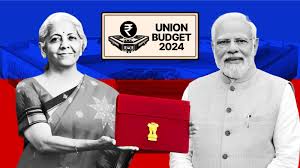

The middle class, which forms 31% of India's population, said it felt forsaken. Without any major relief for a decade and paying taxes for both income and spending, Tuesday saw an epic meltdown of the middle class after the Budget announcements. This is significant as it is the middle-class voters that give the BJP the edge.
(NNI / Latest news / Latest news india / India latest news)
New tax regime changes explained: Income up to Rs 7.75 lakh exempt from tax, Rs 17,500 savings
Latest News: 24th July 2024

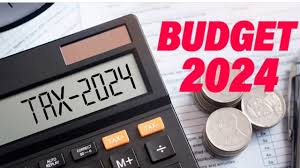
Budget 2024 income tax changes: The standard deduction limit has been increased from Rs 50,000 to Rs 75,000, and the tax slabs have been revised.
(NNI / Latest news / Latest news india / India latest news)
Income Tax Budget 2024 Live: Will FM Nirmala Sitharaman provide relief to middle class?
Latest News: 23rd July 2024
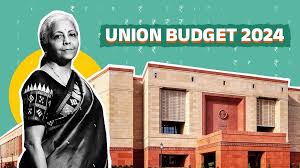

Income Tax Budget 2024 Live: FM Nirmala Sitharaman will present documents in Lok Sabha amid expectations of tax relief for the middle class, given tax buoyancy.
(NNI / Latest news / Latest news india / India latest news)
Elevating India’s capital goods for a global electronics revolution
Latest News: 22nd July 2024
(UPSC current affairs / UPSC / UPSC Preparation / UPSC Preparation Books / UPSC Preparation Strategy )


India stands at a critical juncture with its capital goods industry, particularly in electronics manufacturing. Similar to the transformative power of the steam engine during the Industrial Revolution, the development of advanced capital goods can propel India to the forefront of the global electronics market.
The nation’s electronics production has seen remarkable growth, reaching $115 billion in FY24, and is poised for further expansion. To capitalize on this potential, India must focus on innovation, research and development (R&D), and robust manufacturing infrastructure.
Current State of Electronics Manufacturing:
Impressive Growth: India’s electronics production has quadrupled over the past decade, with projections to increase fivefold in the next five years.
Global Market Potential: The global electronics market, valued at $4.5 trillion, is expected to reach $6.1 trillion by 2030, presenting a significant opportunity for India.
Role of Capital Goods:
Definition: Capital goods include machinery, tools, and equipment essential for production.
Importance: Advanced capital goods are crucial for producing high-quality electronics efficiently and at scale.
Demand-Supply Gap:
Domestic Demand: There is an urgent need to bridge the gap between the demand and supply of capital goods within India.
Dependency on Imports: Enhancing domestic manufacturing infrastructure will reduce reliance on imports and ensure a steady supply of high-quality equipment.
Innovation and R&D:
Investment in R&D: Significant investment in R&D is necessary to develop cutting-edge manufacturing technologies.
Intellectual Property Rights (IPR): Strong IPR protection can foster a secure environment for innovation.
Strategic Initiatives:
Dedicated Innovation Centre: Establishing a centre with a corpus of at least ₹1,000 crore at the Central Manufacturing Technology Institute (CMTI) to drive innovation in capital goods.
Industry-Academia Collaboration: Partnering with industry leaders and academic institutions to streamline production processes and enhance competitiveness.
Significance
Economic Growth:
Job Creation: Enhanced manufacturing capabilities can create numerous job opportunities.
Export Potential: Developing a robust capital goods sector can position India as a major player in the global electronics market.
Technological Advancements:
Global Standards: Indigenous technologies that meet and set international standards in quality and efficiency.
Sustainable Practices: Adopting eco-friendly technologies to position India as a responsible manufacturing hub.
Global Competitiveness:
Strategic Positioning: Indian firms can become formidable contenders on the global stage, potentially rivaling companies like ASML.
Reputation for Excellence: Building a reputation for high-quality and efficient manufacturing processes.
(NNI / Latest news / Latest news india / India latest news)
EPFO’s IT systems are dysfunctional and crash-prone’
Latest News: 22nd July 2024
(UPSC current affairs / UPSC / UPSC Preparation / UPSC Preparation Books / UPSC Preparation Strategy )
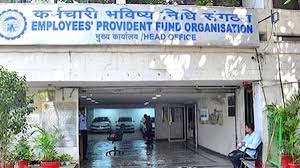

The Employees’ Provident Fund Organisation (EPFO) in India, responsible for managing the provident fund and pension claims of millions of workers, is facing severe IT system challenges. Despite repeated warnings and requests for intervention over the past two and a half years, the issues remain unaddressed, leading to significant operational inefficiencies and frustrations among EPFO staff.
Current Issues:
System Crashes and Instability: EPFO’s IT systems have been experiencing frequent crashes, system slowdowns, involuntary user logouts, and complete system failures.
Operational Challenges: The deficiencies in the IT infrastructure make it difficult for staff to process claims efficiently, often taking longer than the stipulated 20 days, despite performance indicators suggesting a 10-day turnaround.
Efforts to Address Issues:
Repeated Warnings Ignored: The EPF Officers’ Association has consistently flagged these issues to the Central PF Commissioner and other top officials, but their concerns have not been acknowledged.
Extraordinary Measures: Field offices have resorted to working on weekends and holidays to manage claim settlements during periods of lower system load.
Call for Comprehensive Overhaul:
Expert Evaluation Needed: The officers’ association has proposed a comprehensive evaluation of EPFO’s application software by leading industry experts.
Technological Upgrades: An urgent overhaul of the IT systems is necessary to align with the technological advancements seen in other departments, such as the Income Tax department.
Significance
Impact on Employees and Beneficiaries:
Delayed Claims Processing: The inefficiencies in the IT systems directly affect millions of workers who depend on timely processing of their provident fund and pension claims.
Increased Frustration: Both staff and beneficiaries experience escalating frustration due to the prolonged inefficiencies and lack of resolution.
Operational Efficiency:
Resource Utilization: The current situation demands additional resources and extraordinary measures to manage claim settlements, which could be optimized with a fully functional IT system.
Performance Metrics: The discrepancy between actual performance and the performance indicators suggests a systemic failure in addressing the core issues.
Systemic Implications:
Organizational Trust: The continued denial and delay in addressing these issues can erode trust in the EPFO’s ability to manage its responsibilities effectively.
Benchmarking Against Other Departments: The successful technological upgrades in other government departments highlight the lag in EPFO’s systems, underscoring the need for urgent action.
(NNI / Latest news / Latest news india / India latest news)
Living in denial about unemployment
Latest News: 21st July 2024
(UPSC current affairs / UPSC / UPSC Preparation / UPSC Preparation Books / UPSC Preparation Strategy )


The conflicting narratives about unemployment in India highlight the urgent need for reliable and consistent data. Acknowledging and addressing the limitations in current data collection methods is essential for formulating effective policies. By improving data accuracy and focusing on sustainable job creation, India can better address the unemployment crisis and harness its demographic potential.
Unemployment remains a contentious issue in India, with conflicting reports from various institutions. Prime Minister Narendra Modi recently cited a Reserve Bank of India (RBI) report claiming significant job creation, while the opposition and several financial institutions argue otherwise. This discrepancy highlights the complexities and challenges in accurately assessing employment in India.
Conflicting Reports:
RBI Report: The India KLEMS Database, released on July 7, 2024, claims 8 crore jobs were created in the last 3-4 years.
State Bank of India (SBI) Report: States that 8.9 crore jobs were created in manufacturing and services from FY14-FY23.
Centre for Monitoring Indian Economy (CMIE) Report: Reports an unemployment rate rise to 9.2% in June 2024, contrary to the government’s narrative.
Ground Realities:
High Demand for Limited Jobs: 47 lakh applicants for 60,000 constable positions in Uttar Pradesh.
Massive Aspirations: 1.25 crore aspirants for the Railway Recruitment Board’s Non-Technical Popular Categories exam.
Protests and Frustration: Protests in states like Bihar and Uttar Pradesh against schemes like Agnipath highlight youth dissatisfaction.
Data Sources and Their Limitations:
KLEMS Data: Uses official data from the Employment and Unemployment Surveys (EUS) and the Periodic Labour Force Survey (PLFS). It does not independently estimate employment.
PLFS vs. CMIE: PLFS includes those working without income, leading to higher employment figures, while CMIE only counts those earning an income, showing higher unemployment.
Challenges in Data Collection:
Organized vs. Unorganized Sectors: The organized sector has reliable data, but the unorganized sector, which employs 94% of the labor force, lacks comprehensive data.
Impact of Economic Shocks: Events like demonetization, GST implementation, the NBFC crisis, and the COVID-19 pandemic have disrupted traditional data collection methods.
Issues
Inconsistent Data: Varying definitions and methodologies among data sources lead to conflicting employment statistics.
Outdated Surveys: Reliance on old Census data and infrequent surveys results in inaccurate employment estimates.
Economic Shocks: Recent economic disruptions have exacerbated data collection challenges and impacted employment figures.
Significance
Policy Making: Accurate employment data is crucial for effective policy making and addressing unemployment.
Youth Unrest: Growing unemployment and underemployment can lead to increased youth frustration and social unrest.
Economic Growth: Sustainable job creation is essential for economic growth and leveraging India’s demographic dividend.
Solutions
Improved Data Collection: Conduct more frequent and comprehensive surveys, particularly in the unorganized sector.
Unified Definitions: Standardize definitions and methodologies across data sources to ensure consistency.
Economic Reforms: Implement policies that promote job creation, particularly in sectors like manufacturing and services.
Skill Development: Invest in skill development programs to enhance employability and match market demands.
(NNI / Latest news / Latest news india / India latest news)
‘Smoothen administration of tax for the growth of capital markets’
Latest News: 21st July 2024


(NNI / Latest news / Latest news india / India latest news)
Windows outage: how a faulty software update hit businesses worldwide
Latest News: 20th July 2024


Microsoft said that a preliminary cause for the disruption was a configuration change “in a portion of [its] Azure backend workloads”, which resulted in connectivity failures that affected Microsoft 365 services dependent on these connections.
(NNI / Latest news / Latest news india / India latest news)
Union Budget 2024: How can government make housing affordable?
Latest News: 19th July 2024
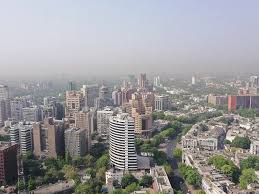

The Monsoon Session of Parliament is scheduled to begin on July 22 and will conclude on August 12, with the Budget being presented on July 23.
(NNI / Latest news / Latest news india / India latest news)
WTO pact worries small fisher bodies
Latest News: 19th July 2024, UPSC Preparation
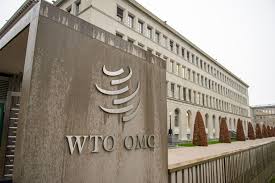

Context: Small-scale fisher organizations from India, Bangladesh, Ecuador, Gambia, and Indonesia have raised concerns over the World Trade Organization (WTO) negotiations on curbing overcapacity and overfishing (OCOF) subsidies. They argue that the comprehensive agreement, once concluded, could have detrimental effects on their livelihoods and the future of indigenous communities worldwide.
Concerns Raised by Small Fisher Bodies:
Special and Differential Treatment: The limited provisions for special and differential treatment in the draft agreement are inadequate for protecting small-scale fishers in developing countries.
National Determination and Definitions: Although the exempted category will be determined nationally, there are challenges in defining activities that exclude small-scale fishers, posing risks of misclassification and potential harm.
Demands and Recommendations:
Removal from WTO Jurisdiction: Small-scale fisher organizations demand that subsidy negotiations be removed from the WTO framework.
Alternative Platform: They propose that negotiations be transferred to the Committee of Fisheries under the Food and Agriculture Organisation (FAO)’s Sub-Committee on Trade, which is better equipped to handle fisheries policy and small-scale fishers’ issues.
Statements from International Organizations:
World Forum of Fisher Peoples and World Forum of Fish Harvesters and Fish Workers: These organizations, representing traditional small-scale fishing communities globally, emphasize that while some exemptions are agreed upon, the definitions and scope need clear articulation to avoid adverse impacts on small-scale fishers.
Significance
Impact on Small-Scale Fishers:
Livelihoods and Sustainability: The agreement could undermine the sustainability and livelihoods of small-scale fishers who rely heavily on subsidies to maintain their operations.
Indigenous Communities: Indigenous fishing communities could face severe disruptions, threatening their traditional way of life and economic stability.
Broader Implications:
Global Fisheries Management: The debate highlights the need for more inclusive and nuanced approaches in global fisheries management, recognizing the unique needs and contributions of small-scale fishers.
Policy Expertise: Involving the FAO’s Sub-Committee on Trade could bring more specialized expertise to the negotiations, ensuring that policies are well-informed and equitable.
(NNI / Latest news / Latest news india / India latest news)
(UPSC current affairs / UPSC / UPSC Preparation / UPSC Preparation Books / UPSC Preparation Strategy )
Intergenerational equity as tax devolution criterion
Latest News: 18th July 2024, UPSC Preparation
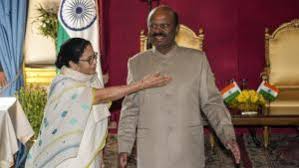

Context: Small-scale fisher organizations from India, Bangladesh, Ecuador, Gambia, and Indonesia have raised concerns over the World Trade Organization (WTO) negotiations on curbing overcapacity and overfishing (OCOF) subsidies. They argue that the comprehensive agreement, once concluded, could have detrimental effects on their livelihoods and the future of indigenous communities worldwide.
Concerns Raised by Small Fisher Bodies:
Special and Differential Treatment: The limited provisions for special and differential treatment in the draft agreement are inadequate for protecting small-scale fishers in developing countries.
National Determination and Definitions: Although the exempted category will be determined nationally, there are challenges in defining activities that exclude small-scale fishers, posing risks of misclassification and potential harm.
Demands and Recommendations:
Removal from WTO Jurisdiction: Small-scale fisher organizations demand that subsidy negotiations be removed from the WTO framework.
Alternative Platform: They propose that negotiations be transferred to the Committee of Fisheries under the Food and Agriculture Organisation (FAO)’s Sub-Committee on Trade, which is better equipped to handle fisheries policy and small-scale fishers’ issues.
Statements from International Organizations:
World Forum of Fisher Peoples and World Forum of Fish Harvesters and Fish Workers: These organizations, representing traditional small-scale fishing communities globally, emphasize that while some exemptions are agreed upon, the definitions and scope need clear articulation to avoid adverse impacts on small-scale fishers.
Significance
Impact on Small-Scale Fishers:
Livelihoods and Sustainability: The agreement could undermine the sustainability and livelihoods of small-scale fishers who rely heavily on subsidies to maintain their operations.
Indigenous Communities: Indigenous fishing communities could face severe disruptions, threatening their traditional way of life and economic stability.
Broader Implications:
Global Fisheries Management: The debate highlights the need for more inclusive and nuanced approaches in global fisheries management, recognizing the unique needs and contributions of small-scale fishers.
Policy Expertise: Involving the FAO’s Sub-Committee on Trade could bring more specialized expertise to the negotiations, ensuring that policies are well-informed and equitable.
(NNI / Latest news / Latest news india / India latest news)
(UPSC current affairs / UPSC / UPSC Preparation / UPSC Preparation Books / UPSC Preparation Strategy )
What is Fiscal Responsibility and Budget Management Act (FRBM Act)?
Latest News Economy: 17th July 2024
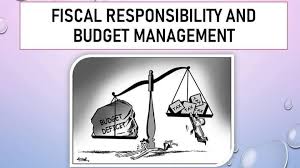

The Fiscal Responsibility and Budget Management (FRBM) Act, passed in 2003, was meant to make the Indian government more responsible with its money and cut down on its debt. Its importance has been emphasized during economic problems, especially during the COVID-19 pandemic, when the FRBM Act’s usual fiscal goals were loosened to allow for more government spending.
Origin and Implementation
The FRBM Act was first suggested by Yashwant Sinha, who was Finance Minister at the time, in 2000. It became law in 2003. It was officially put into place on July 5, 2004, and its goal was to set up a framework for fiscal control to protect macroeconomic stability and long-term economic growth.
Goals and Objectives of the FRBM Act
The Act’s goals are to:
Keep the budget stable.
Promote transparency in government financial operations.
Give the Reserve Bank of India more practical freedom to control inflation.
One of its long-term goals is to ensure the financial load is shared fairly.
Key Features of the FRBM Act
The FRBM Act mandates the presentation of specific documents with the Union Budget:
Medium-term fiscal policy statement.
Macroeconomic framework statement.
Fiscal policy strategy statement.
There is a clear picture of the government’s finances in these papers because they show predictions for important fiscal indicators like revenue and fiscal deficits. The Act lets the government deviate from its fiscal goals in certain situations, like natural disasters or major threats to national security, which gives fiscal policy some freedom.
Challenges and Reforms
The FRBM Act has a very detailed structure, but it has been hard to put into practice, so it has been changed many times over the years. In 2016, the NK Singh Committee looked over the Act and suggested a number of changes, such as making paying down debt the main budget goal.
Making a separate economic council to keep an eye on things.
Making it clear what kinds of deviations from economic goals are okay.
Setting strict rules for how the government can borrow money.
The goal of these suggestions is to make the FRBM Act better at promoting long-term economic growth and security. The FRBBM Act is still very important for India’s economic management because it enforces structured fiscal control and openness. This is especially true now that the global economy is unstable.
(NNI / Latest news / Latest news india / India latest news)
(UPSC current affairs / UPSC / UPSC Preparation / UPSC Preparation Books / UPSC Preparation Strategy )
Government to Propose Insurance Act Amendments in Budget Session
Latest News: 16th July 2024


People in New Delhi are getting more and more excited about the upcoming Budget session. They think that the government will bring a bill to change the Insurance Act of 1938. ‘Insurance for All by 2047’ is the goal of this project, which will make a lot of big changes to the insurance industry to fit modern needs.
Key Amendments Proposed
The proposed changes to the Insurance Act include adding a composite license, changing the capital requirements (differential capital), lowering the solvency standards, giving out captive licenses, changing the rules on investments, setting up a one-time registration system for intermediaries, and letting insurers sell other financial products. The draft bill, which is being prepared for approval by the Cabinet, wants to change the insurance industry so that it is more like the banking sector, which is divided into general banks, small finance banks, and payments banks.
Impact of Composite Licensing
The plan for composite licensing is a big change. The Insurance Regulatory and Development Authority of India (IRDAI) does not allow Indian insurance companies to have a license that would allow them to give both life insurance and other types of insurance, like health or general insurance. With this change, life insurers would be able to give health and general insurance as well. This would make the process easier and allow one insurer to provide more services.
Operational and Economic Benefits
The suggested changes to the laws should not only better protect customers and increase their returns, but they should also make it easier for new companies to enter the market. By making the insurance business more operational and financial efficient, this could help the economy grow and create jobs. With these changes, it should be easier to do business, which should bring more Indian and foreign companies into the insurance market.
Regulatory Background and Public Input
For the insurance business in India, the Insurance Act of 1938 is the most important law. The Insurance Act and the Insurance Regulatory Development Act of 1999 are both being looked at again to make sure they meet the needs of today’s business. In December 2022, the Ministry of Finance asked the public for feedback on the planned changes, highlighting the government’s open approach to changing important economic laws.
Broader Implications for the Insurance Sector
By making it easier for insurers to meet certain capital and liquidity requirements, these changes could lead to the rise of niche insurers that focus on areas that haven’t been well served, like micro-insurance or regional insurance. With these new companies coming into the Indian market, more people from all walks of life and in more places are likely to get insurance. This will have a big effect on the country’s economy. The government wants to make the Indian insurance market more active, responsive, and open to everyone by taking these steps. These goals are in line with the country’s overall economic strategy. (NNI / Latest news / Latest news india / India latest news)
(UPSC current affairs / UPSC / UPSC Preparation / UPSC Preparation Books / UPSC Preparation Strategy )
Nifty hits fresh record high in early trade; Sensex climbs 290 points
Latest News 15th July 2024
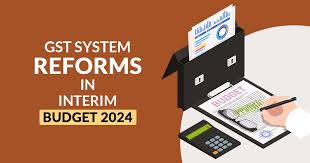

The 30-share BSE Sensex climbed 290.46 points to 80,809.80 in early trade. The NSE Nifty rallied 95.85 points to hit a new record peak of 24,598.
(NNI / Latest news / Latest news india / India latest news)
GST system reforms panel rejigged
Latest economic news India 14th July 2024
UPSC Preparation


he Indian government plans to expand its EV policy, announced in March, to attract global players and enhance local manufacturing. The revised policy aims to lower costs, boost production, and strengthen the domestic EV ecosystem, fostering sustainable growth and competitiveness.
Introduction: Government’s Consideration for Extending EV Policy
The government is considering expanding its EV policy announced in March to have a retrospective effect.
This policy aims to encourage global players to localize production and invest in the domestic ecosystem.
The revised policy will extend benefits to entities that have already made investments.
The revised policy is expected to be formally announced in August.
The focus of the March Policy:
The March policy aimed to provide access to the latest technology and strengthen the EV ecosystem.
It encouraged healthy competition by achieving higher production volumes, economies of scale, and lower production costs.
The policy mandated that half of the value addition in manufacturing be done domestically within five years.
Import duty on EVs as completely built units (CBUs) with a minimum cost, insurance, and freight (CIF) value of $35,000 was reduced from 70%-100% to 15%.
Need for Investment and Intervention:
A Niti Aayog report in 2022 emphasized the need for viable economics for owning and maintaining EVs.
The report suggested that a sharper decline in costs would accelerate EV adoption.
India faces structural unit cost disadvantages in producing certain cell components, requiring significant capital investment.
Bain & Company’s India EV Report (2023) highlighted after-sales service as a major pain point for EV customers.
Significant investor support is required to realize the $100 billion-plus EV opportunity in India.
Addressing the Paradigm:
The EV policy shares priorities with those in the U.S., China, and Europe, where incentives are provided on a case-by-case basis.
The International Energy Agency’s Global EV Outlook for 2024 pointed out that electric cars are still more expensive than combustion engine equivalents.
Europe and the U.S. meet 20%-30% of their EV battery demands through imports, forming a case for integrated production lines.
According to Dinesh Abrol, policies should focus on building core manufacturing capabilities domestically.
Strengthening domestic players in creating capabilities for critical components is essential for progress.
(UPSC current affairs / UPSC / UPSC Preparation / UPSC Preparation Books / UPSC Preparation Strategy )
(NNI / Latest news / Latest news india / India latest news)
Future investments in India’s EV space


he Indian government plans to expand its EV policy, announced in March, to attract global players and enhance local manufacturing. The revised policy aims to lower costs, boost production, and strengthen the domestic EV ecosystem, fostering sustainable growth and competitiveness.
Introduction: Government’s Consideration for Extending EV Policy
The government is considering expanding its EV policy announced in March to have a retrospective effect.
This policy aims to encourage global players to localize production and invest in the domestic ecosystem.
The revised policy will extend benefits to entities that have already made investments.
The revised policy is expected to be formally announced in August.
The focus of the March Policy:
The March policy aimed to provide access to the latest technology and strengthen the EV ecosystem.
It encouraged healthy competition by achieving higher production volumes, economies of scale, and lower production costs.
The policy mandated that half of the value addition in manufacturing be done domestically within five years.
Import duty on EVs as completely built units (CBUs) with a minimum cost, insurance, and freight (CIF) value of $35,000 was reduced from 70%-100% to 15%.
Need for Investment and Intervention:
A Niti Aayog report in 2022 emphasized the need for viable economics for owning and maintaining EVs.
The report suggested that a sharper decline in costs would accelerate EV adoption.
India faces structural unit cost disadvantages in producing certain cell components, requiring significant capital investment.
Bain & Company’s India EV Report (2023) highlighted after-sales service as a major pain point for EV customers.
Significant investor support is required to realize the $100 billion-plus EV opportunity in India.
Addressing the Paradigm:
The EV policy shares priorities with those in the U.S., China, and Europe, where incentives are provided on a case-by-case basis.
The International Energy Agency’s Global EV Outlook for 2024 pointed out that electric cars are still more expensive than combustion engine equivalents.
Europe and the U.S. meet 20%-30% of their EV battery demands through imports, forming a case for integrated production lines.
According to Dinesh Abrol, policies should focus on building core manufacturing capabilities domestically.
Strengthening domestic players in creating capabilities for critical components is essential for progress.
First Budget of NDA 3.0

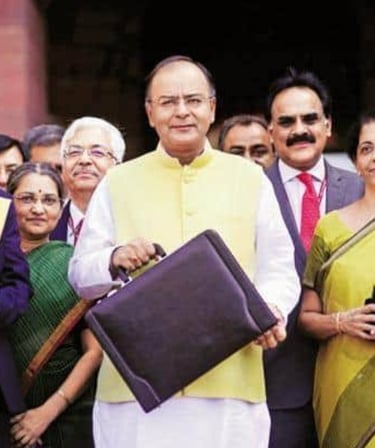
Finance Minister Nirmala Sitharaman is going to give her seventh Union Budget, which will happen during the monsoon months, a time of natural renewal. This event shows that India’s government is stable and strong, and it especially shows how important it is for women to be in charge of making important decisions.
Context and Significance of the Current Budget
The next budget is important because it is the first one under NDA 3.0, which means that policymakers want to make big changes and keep things the same. After getting back on track after the Covid pandemic and global wars, the budget aims to support India’s long-term goal of becoming “Viksit Bharat” by 2047.
Expectations from the Union Budget
This budget cycle plans to focus on policies that will change four major groups in society: the poor (Garib), the young (Yuva), the farmers (Annadata), and the women (Nari). It is expected to strengthen the economic framework that has been weakened by recent events around the world. The Reserve Bank of India says that the financial stability matrix is strong, which suggests that the conditions are good for putting important economic changes into action.
Focus Areas and Strategic Initiatives
The Banking, Financial Services, and Insurance (BFSI) sectors are expected to get better, especially when it comes to digitalization, security, and making services easier for customers to access. Fintech and Non-Banking Financial Companies (NBFCs) are likely to get some good policies in the budget, which will help more people get access to money and encourage new ideas. Micro and small businesses make a big contribution to the GDP. To meet their needs, support systems are planned to make it easier for them to get money and follow the rules.
Challenges in Real Estate and Healthcare
Tax breaks are meant to get the real estate market going again after it has slowed down. They are expected to encourage both building and buying, which will keep prices low. More money could be put into expanding healthcare infrastructure, especially in places that aren’t metropolises. There could also be more pharmaceuticals made in the United States, thanks to new technologies like AI and IoT.
About Union Budget
The Indian Union Budget, which used to be given on the last day of February every year, was moved to February 1st in 2017 to speed up the process of allocating funds.
During the “Halwa ceremony,” which marks the beginning of the budget writing process, officials from the Finance Ministry are locked up to keep things secret.
In 1950, R. K. Shanmukham Chetty introduced India’s first Union Budget as an independent country.
The Budget had a separate Railway Budget until 2016. After that, it was combined for a more unified approach.
Article 112 of the law calls for the Budget, which is also known as the “Annual Financial Statement.”
In 2019, a “bahi-khata,” or ledger, was used instead of the briefcase that was usually used to bring the Budget documents to Parliament.
The process of making the budget starts about six months before it is shown.
The “black budget” of 1973–74, which was led by Indira Gandhi, was named after the fact that it focused on debt.
Its two main parts are the Revenue Budget and the Capital Budget.
The Union Budget has been given by Arun Jaitley the most times in the 21st century.
What is Angel Tax?

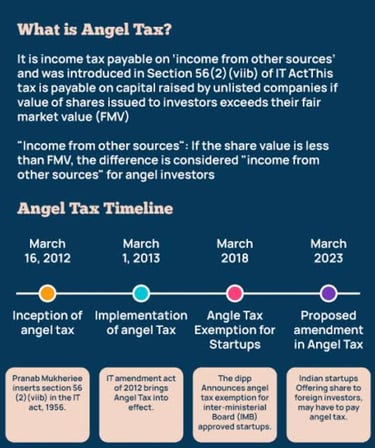
The DPIIT has suggested that the unpopular “angel tax” on startups should be gotten rid of. This could be announced in the Union Budget. The DPIIT secretary stated that a proposal to get rid of the tax has been made. The goal is to make it easier for startups to get funding and make them more appealing to investors.
Understanding Angel Tax
Angel tax is a tax that private companies have to pay on raised money that is more than their fair market value. It mostly affects payments from angel investors, which is how the name came about. Section 56(2) VII B of the Income Tax Act put this tax in place. It says that any premium on selling shares to foreign buyers is “income from other sources,” which means it needs to be taxed.
Origins of Angel Tax
The angel tax was included in the 2012 Union Budget by Pranab Mukherjee, who was Finance Minister at the time. Its goal was to stop people from moving money. In April 2018, a big change was made: startups didn’t have to pay this tax if the total investment, including funds from angel investors, didn’t go over 10 crore. However, they still had to get more licenses and valuation certificates.
Rationale Behind DPIIT’s Recommendation for Repeal
This suggestion came from talking with people in the startup environment and industry groups that were constantly worried about how the angel tax would hurt startup funding and growth. The DPIIT has told the finance ministry about these worries and suggested that getting rid of it could help capital formation in the country a lot.
Impact on Startups
Getting rid of the angel tax could greatly help India’s over 141,000 DPIIT-registered startups. It would also make angel investments more attractive and smart financially. Angel tax is currently seen as a turnoff by possible investors because it lowers the amount of money that can be used to grow and reinvest in startups. The Confederation of Indian Industry (CII) and other business groups have been vocal supporters of lowering this tax to help the startup environment.
Current Investment Trends and Challenges
A small drop in startup fundraising efforts was seen in the first half of 2024, which shows that the economy is tough for new tech startups. Also, big drops in the values of well-known startups are a sign of a wider slowdown in funding, which is made worse by investors’ careful views on the world’s markets. Getting rid of the angel tax might help with some of these problems by promoting more robust business activities.
MSMEs need outlays for technology upgrades, to aid in green transition
The growth and sustainability of the MSME sector are pivotal for India’s economic progress. By focusing on technology upgrades, enhancing credit access, extending payment timelines, and supporting green transitions, the government can ensure that MSMEs continue to thrive and contribute significantly to the economy. The upcoming budget must address these areas to fuel growth, generate employment, and promote sustainable development within the MSME sector.
Six Pillars for MSME Growth:
Formalisation and Access to Credit: Ensuring that MSMEs have access to formal financial systems and credit facilities.
Increased Market Access and E-commerce Adoption: Encouraging MSMEs to leverage digital platforms for broader market reach.
Higher Productivity through Modern Technology: Promoting the adoption of advanced technologies to enhance productivity.
Enhanced Skill Levels and Digitalisation: Investing in skill development and digital transformation, particularly in the service sector.
Support to Khadi, Village, and Coir Industry: Aiming to globalize traditional industries.
Empowerment of Women and Artisans: Fostering enterprise creation among women and artisans.
Infrastructure Development:
Sustainable Economic Growth: Prioritizing infrastructure development, especially in industrial clusters, to support the MSME sector and overall economic growth.
Employment Generation:
Export Growth: With exports growing at a CAGR of 8.5% from FY18 to FY24, the target is to reach $2 trillion by FY30, requiring a supportive ecosystem for exporters and MSMEs.
NPA Timeline Extension: Proposing to extend the NPA timeline from 90 days to 180 days to provide relief to struggling MSMEs.
Credit and Financial Support:
Credit Guarantee Scheme: Revamping the Credit Guarantee Scheme for micro and small enterprises in the manufacturing sector.
Interest Equalisation Scheme: Extending the scheme for five years to support exports, along with restoring subvention rates for MSMEs.
Emergency Credit Line Guarantee Scheme: Reintroducing the scheme for MSME exporters for another two years.
Payment Timeline Extension: Extending the timeline for payments to MSME job work to 120 days from the current 45 days.
Policy and Scheme Adjustments:
PLI Scheme for MSMEs: Lowering the investment limit to ₹25 crore and the turnover limit to ₹70 crore under the PLI scheme for the textile and garment sector.
RoDTEP and RoSCTL Schemes: Extending these schemes for another five years to support the textile and garment sector.
Green Transition and R&D:
Climate Change Impact: Providing soft funds for MSMEs to transition to green resources and technologies.
Research and Development: Increasing the weighted tax deduction under Section 35(2AB) to 300% and extending benefits to LLPs, partnership firms, and proprietary firms to incentivize R&D.
Issues
Access to Credit: Limited access to formal credit facilities hampers the growth of MSMEs.
Technological Lag: Many MSMEs lack the necessary technology to compete globally.
Payment Delays: Short payment timelines create cash flow issues for MSMEs.
Climate Change Adaptation: MSMEs need support to adapt to climate change and transition to sustainable practices.
Significance
Economic Growth: Strengthening the MSME sector is crucial for sustainable economic growth and achieving export targets.
Employment Generation: MSMEs are key to generating employment and boosting economic resilience.
Technological Advancement: Investing in technology upgrades will enhance productivity and global competitiveness.
Sustainable Development: Supporting green transitions will ensure the long-term sustainability of MSMEs.
Solutions
Enhanced Credit Access: Implementing measures to improve access to formal credit for MSMEs.
Technology Upgradation: Providing financial and technical support for MSMEs to adopt modern technologies.
Extended Payment Timelines: Adjusting payment timelines to ensure better cash flow management for MSMEs.
Green Transition Funds: Allocating more funds to support MSMEs in transitioning to green technologies and practices.
Incentivizing R&D: Increasing tax incentives for R&D to promote innovation within the MSME sector.



